Low Emission Vehicle: Impact on Transport Industry in the UK
VerifiedAdded on 2023/06/08
|67
|16369
|134
AI Summary
This research deals with the concept of low emission vehicles and its impact on the transport industry in the UK. It discusses about detailed information about low emission vehicle concept from previous research papers and theories. The environmental impact of the low emission vehicle has been provided in the chapter.
Contribute Materials
Your contribution can guide someone’s learning journey. Share your
documents today.
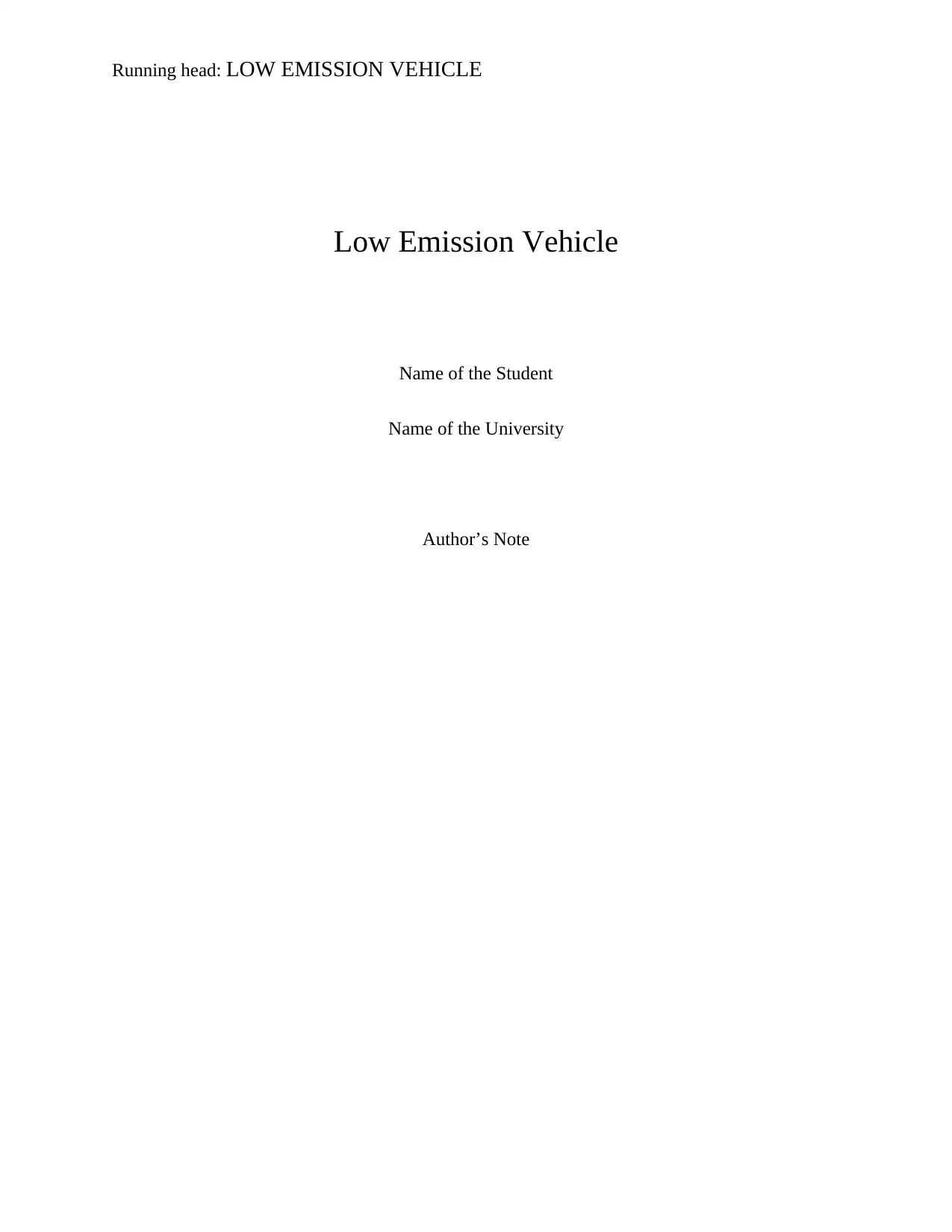
Running head: LOW EMISSION VEHICLE
Low Emission Vehicle
Name of the Student
Name of the University
Author’s Note
Low Emission Vehicle
Name of the Student
Name of the University
Author’s Note
Secure Best Marks with AI Grader
Need help grading? Try our AI Grader for instant feedback on your assignments.
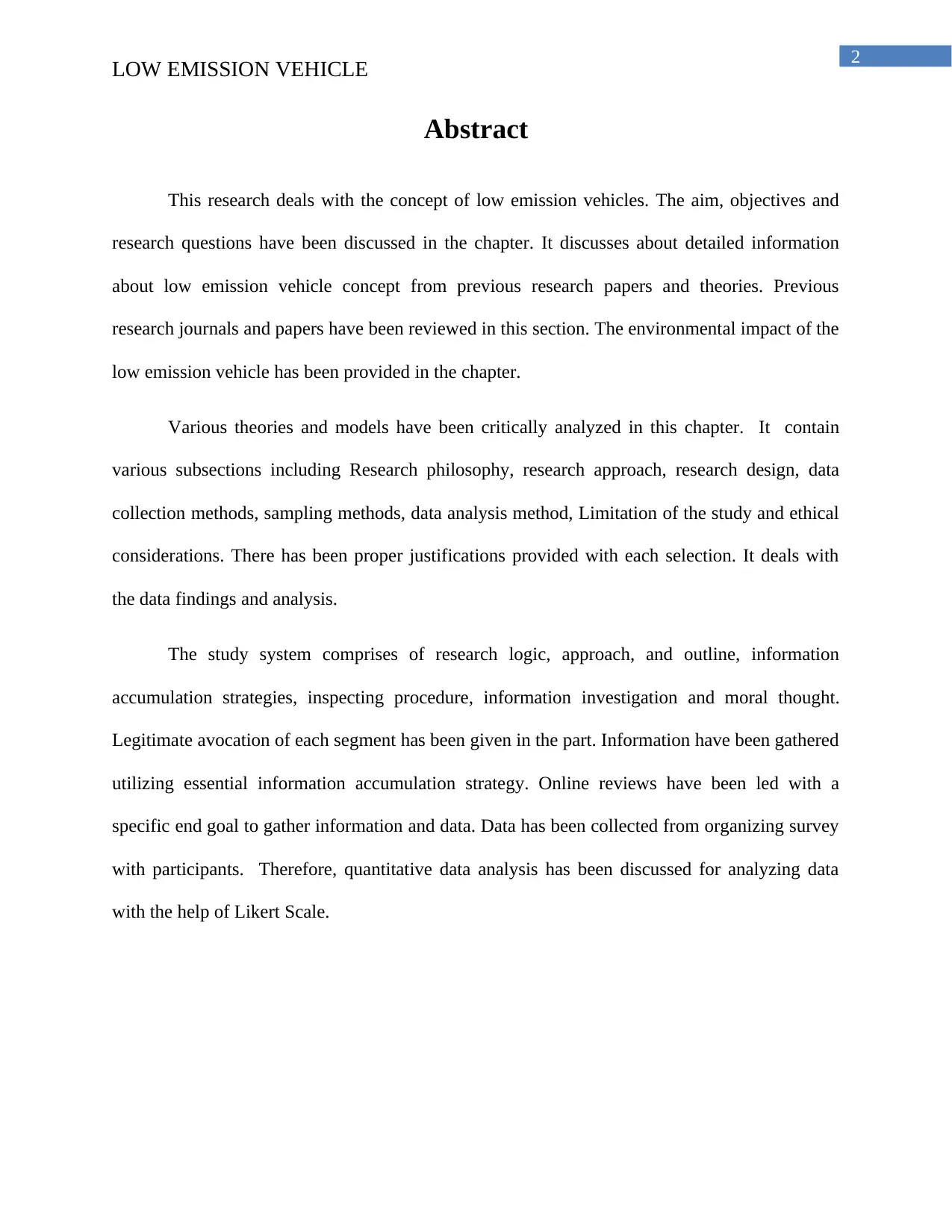
2
LOW EMISSION VEHICLE
Abstract
This research deals with the concept of low emission vehicles. The aim, objectives and
research questions have been discussed in the chapter. It discusses about detailed information
about low emission vehicle concept from previous research papers and theories. Previous
research journals and papers have been reviewed in this section. The environmental impact of the
low emission vehicle has been provided in the chapter.
Various theories and models have been critically analyzed in this chapter. It contain
various subsections including Research philosophy, research approach, research design, data
collection methods, sampling methods, data analysis method, Limitation of the study and ethical
considerations. There has been proper justifications provided with each selection. It deals with
the data findings and analysis.
The study system comprises of research logic, approach, and outline, information
accumulation strategies, inspecting procedure, information investigation and moral thought.
Legitimate avocation of each segment has been given in the part. Information have been gathered
utilizing essential information accumulation strategy. Online reviews have been led with a
specific end goal to gather information and data. Data has been collected from organizing survey
with participants. Therefore, quantitative data analysis has been discussed for analyzing data
with the help of Likert Scale.
LOW EMISSION VEHICLE
Abstract
This research deals with the concept of low emission vehicles. The aim, objectives and
research questions have been discussed in the chapter. It discusses about detailed information
about low emission vehicle concept from previous research papers and theories. Previous
research journals and papers have been reviewed in this section. The environmental impact of the
low emission vehicle has been provided in the chapter.
Various theories and models have been critically analyzed in this chapter. It contain
various subsections including Research philosophy, research approach, research design, data
collection methods, sampling methods, data analysis method, Limitation of the study and ethical
considerations. There has been proper justifications provided with each selection. It deals with
the data findings and analysis.
The study system comprises of research logic, approach, and outline, information
accumulation strategies, inspecting procedure, information investigation and moral thought.
Legitimate avocation of each segment has been given in the part. Information have been gathered
utilizing essential information accumulation strategy. Online reviews have been led with a
specific end goal to gather information and data. Data has been collected from organizing survey
with participants. Therefore, quantitative data analysis has been discussed for analyzing data
with the help of Likert Scale.

3
LOW EMISSION VEHICLE
Acknowledgement
I would like to thank all the people who helped me throughout the writing of this dissertation
project. I would like to thank wholeheartedly to my family members and my
supervisors_____________ who supported me throughout my time at the university. I would
also like to thank the University for providing the data which where helpful for my research
project. Finally, I would like to thank my course tutor ____________ who guided me throughout
the course.
LOW EMISSION VEHICLE
Acknowledgement
I would like to thank all the people who helped me throughout the writing of this dissertation
project. I would like to thank wholeheartedly to my family members and my
supervisors_____________ who supported me throughout my time at the university. I would
also like to thank the University for providing the data which where helpful for my research
project. Finally, I would like to thank my course tutor ____________ who guided me throughout
the course.
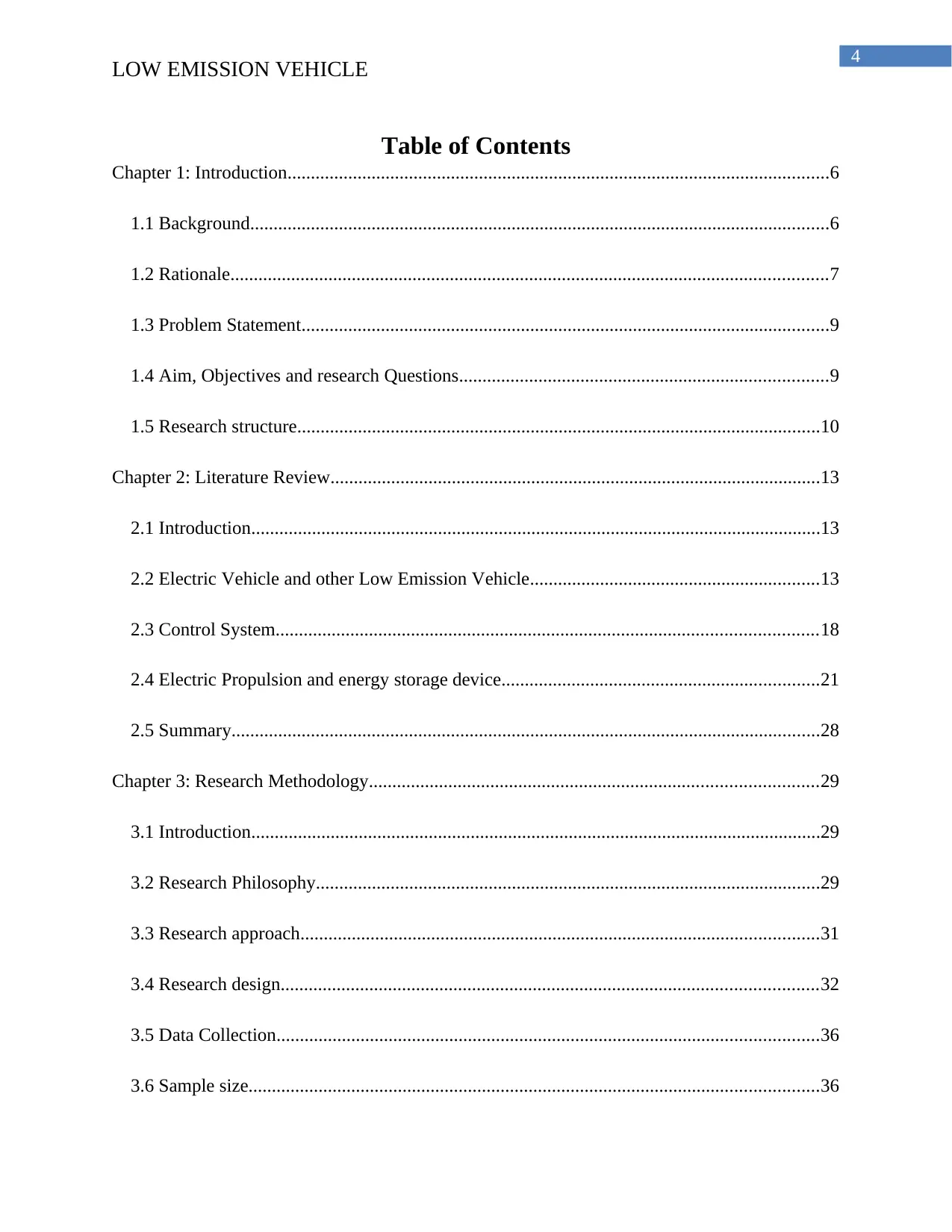
4
LOW EMISSION VEHICLE
Table of Contents
Chapter 1: Introduction....................................................................................................................6
1.1 Background............................................................................................................................6
1.2 Rationale................................................................................................................................7
1.3 Problem Statement.................................................................................................................9
1.4 Aim, Objectives and research Questions...............................................................................9
1.5 Research structure................................................................................................................10
Chapter 2: Literature Review.........................................................................................................13
2.1 Introduction..........................................................................................................................13
2.2 Electric Vehicle and other Low Emission Vehicle..............................................................13
2.3 Control System....................................................................................................................18
2.4 Electric Propulsion and energy storage device....................................................................21
2.5 Summary..............................................................................................................................28
Chapter 3: Research Methodology................................................................................................29
3.1 Introduction..........................................................................................................................29
3.2 Research Philosophy............................................................................................................29
3.3 Research approach...............................................................................................................31
3.4 Research design...................................................................................................................32
3.5 Data Collection....................................................................................................................36
3.6 Sample size..........................................................................................................................36
LOW EMISSION VEHICLE
Table of Contents
Chapter 1: Introduction....................................................................................................................6
1.1 Background............................................................................................................................6
1.2 Rationale................................................................................................................................7
1.3 Problem Statement.................................................................................................................9
1.4 Aim, Objectives and research Questions...............................................................................9
1.5 Research structure................................................................................................................10
Chapter 2: Literature Review.........................................................................................................13
2.1 Introduction..........................................................................................................................13
2.2 Electric Vehicle and other Low Emission Vehicle..............................................................13
2.3 Control System....................................................................................................................18
2.4 Electric Propulsion and energy storage device....................................................................21
2.5 Summary..............................................................................................................................28
Chapter 3: Research Methodology................................................................................................29
3.1 Introduction..........................................................................................................................29
3.2 Research Philosophy............................................................................................................29
3.3 Research approach...............................................................................................................31
3.4 Research design...................................................................................................................32
3.5 Data Collection....................................................................................................................36
3.6 Sample size..........................................................................................................................36
Secure Best Marks with AI Grader
Need help grading? Try our AI Grader for instant feedback on your assignments.
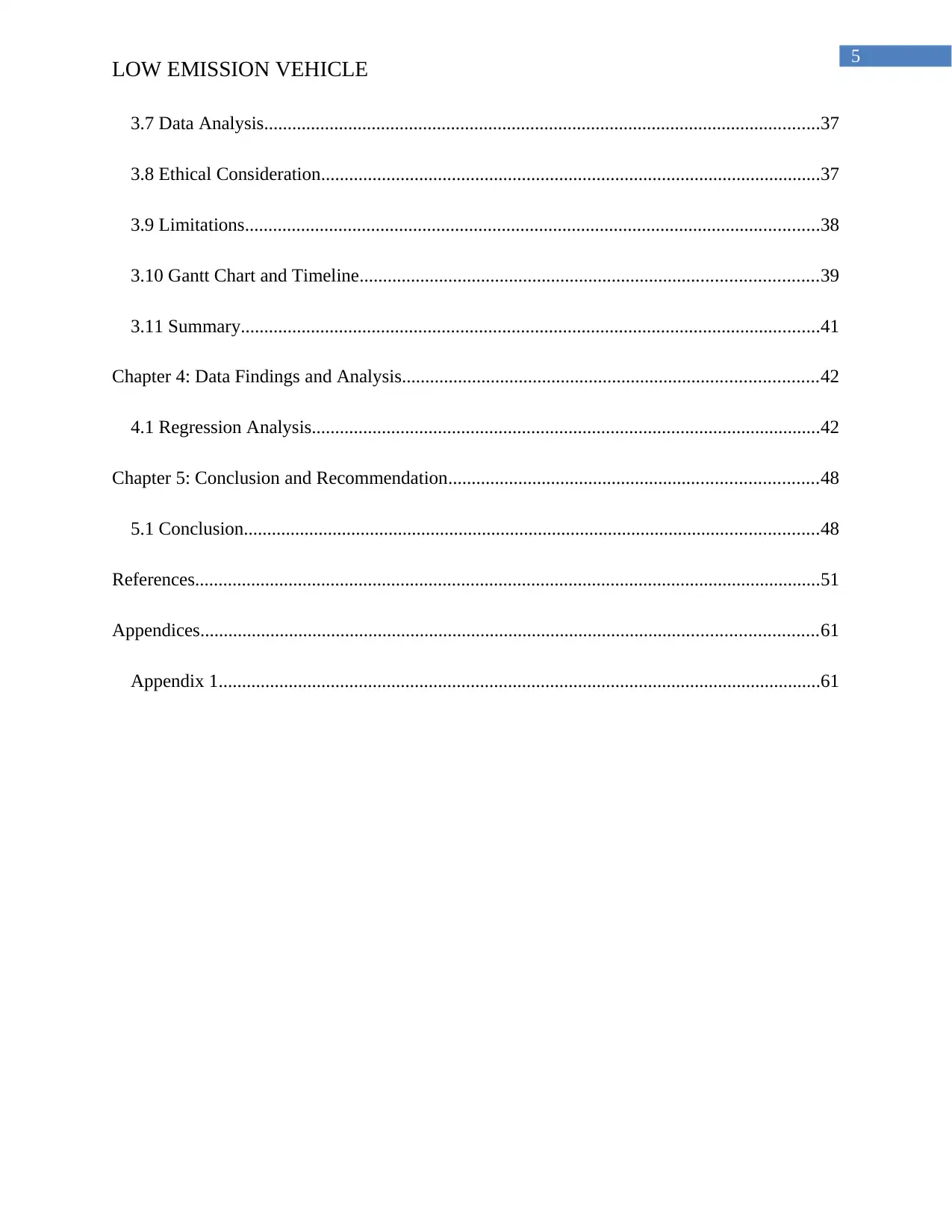
5
LOW EMISSION VEHICLE
3.7 Data Analysis.......................................................................................................................37
3.8 Ethical Consideration...........................................................................................................37
3.9 Limitations...........................................................................................................................38
3.10 Gantt Chart and Timeline..................................................................................................39
3.11 Summary............................................................................................................................41
Chapter 4: Data Findings and Analysis.........................................................................................42
4.1 Regression Analysis.............................................................................................................42
Chapter 5: Conclusion and Recommendation...............................................................................48
5.1 Conclusion...........................................................................................................................48
References......................................................................................................................................51
Appendices....................................................................................................................................61
Appendix 1.................................................................................................................................61
LOW EMISSION VEHICLE
3.7 Data Analysis.......................................................................................................................37
3.8 Ethical Consideration...........................................................................................................37
3.9 Limitations...........................................................................................................................38
3.10 Gantt Chart and Timeline..................................................................................................39
3.11 Summary............................................................................................................................41
Chapter 4: Data Findings and Analysis.........................................................................................42
4.1 Regression Analysis.............................................................................................................42
Chapter 5: Conclusion and Recommendation...............................................................................48
5.1 Conclusion...........................................................................................................................48
References......................................................................................................................................51
Appendices....................................................................................................................................61
Appendix 1.................................................................................................................................61
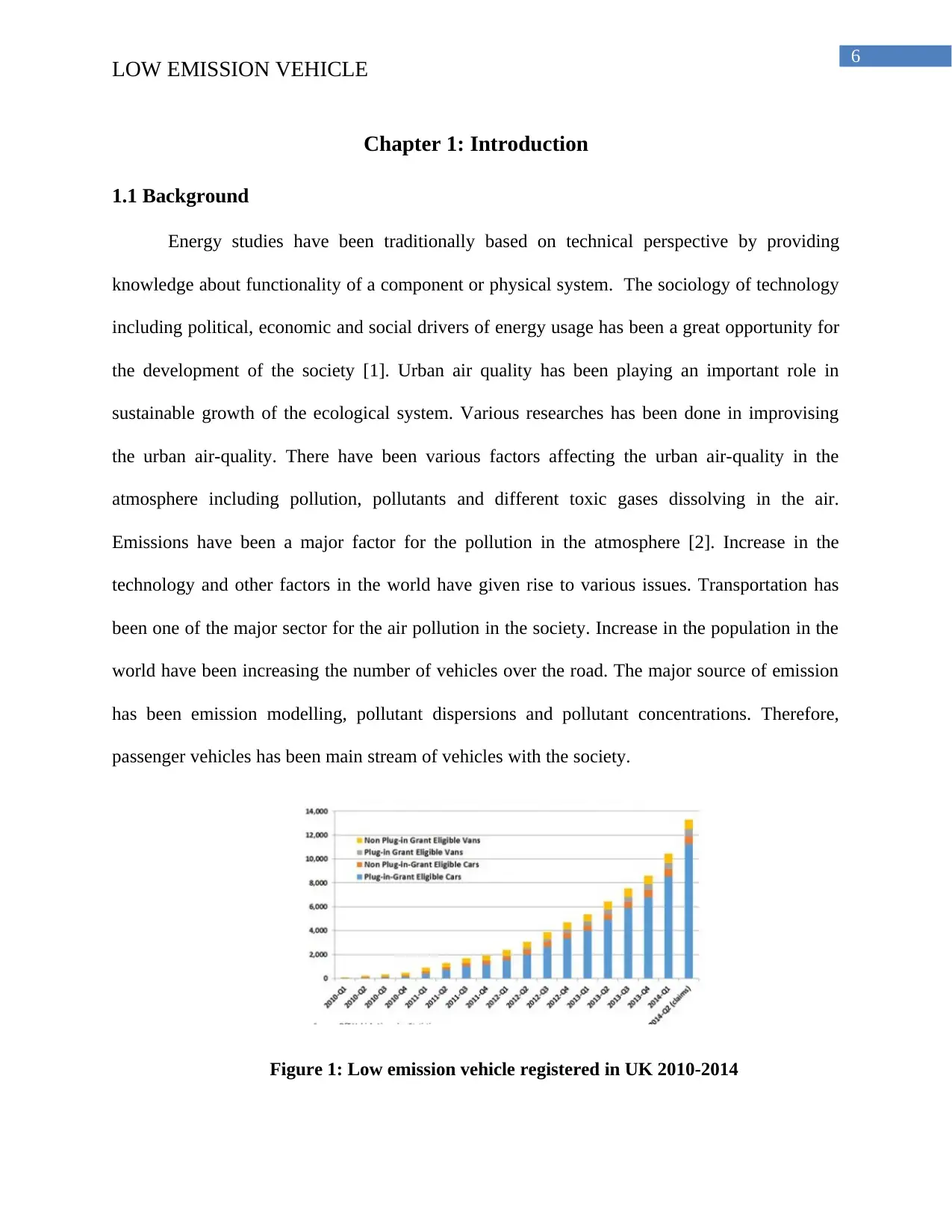
6
LOW EMISSION VEHICLE
Chapter 1: Introduction
1.1 Background
Energy studies have been traditionally based on technical perspective by providing
knowledge about functionality of a component or physical system. The sociology of technology
including political, economic and social drivers of energy usage has been a great opportunity for
the development of the society [1]. Urban air quality has been playing an important role in
sustainable growth of the ecological system. Various researches has been done in improvising
the urban air-quality. There have been various factors affecting the urban air-quality in the
atmosphere including pollution, pollutants and different toxic gases dissolving in the air.
Emissions have been a major factor for the pollution in the atmosphere [2]. Increase in the
technology and other factors in the world have given rise to various issues. Transportation has
been one of the major sector for the air pollution in the society. Increase in the population in the
world have been increasing the number of vehicles over the road. The major source of emission
has been emission modelling, pollutant dispersions and pollutant concentrations. Therefore,
passenger vehicles has been main stream of vehicles with the society.
Figure 1: Low emission vehicle registered in UK 2010-2014
LOW EMISSION VEHICLE
Chapter 1: Introduction
1.1 Background
Energy studies have been traditionally based on technical perspective by providing
knowledge about functionality of a component or physical system. The sociology of technology
including political, economic and social drivers of energy usage has been a great opportunity for
the development of the society [1]. Urban air quality has been playing an important role in
sustainable growth of the ecological system. Various researches has been done in improvising
the urban air-quality. There have been various factors affecting the urban air-quality in the
atmosphere including pollution, pollutants and different toxic gases dissolving in the air.
Emissions have been a major factor for the pollution in the atmosphere [2]. Increase in the
technology and other factors in the world have given rise to various issues. Transportation has
been one of the major sector for the air pollution in the society. Increase in the population in the
world have been increasing the number of vehicles over the road. The major source of emission
has been emission modelling, pollutant dispersions and pollutant concentrations. Therefore,
passenger vehicles has been main stream of vehicles with the society.
Figure 1: Low emission vehicle registered in UK 2010-2014
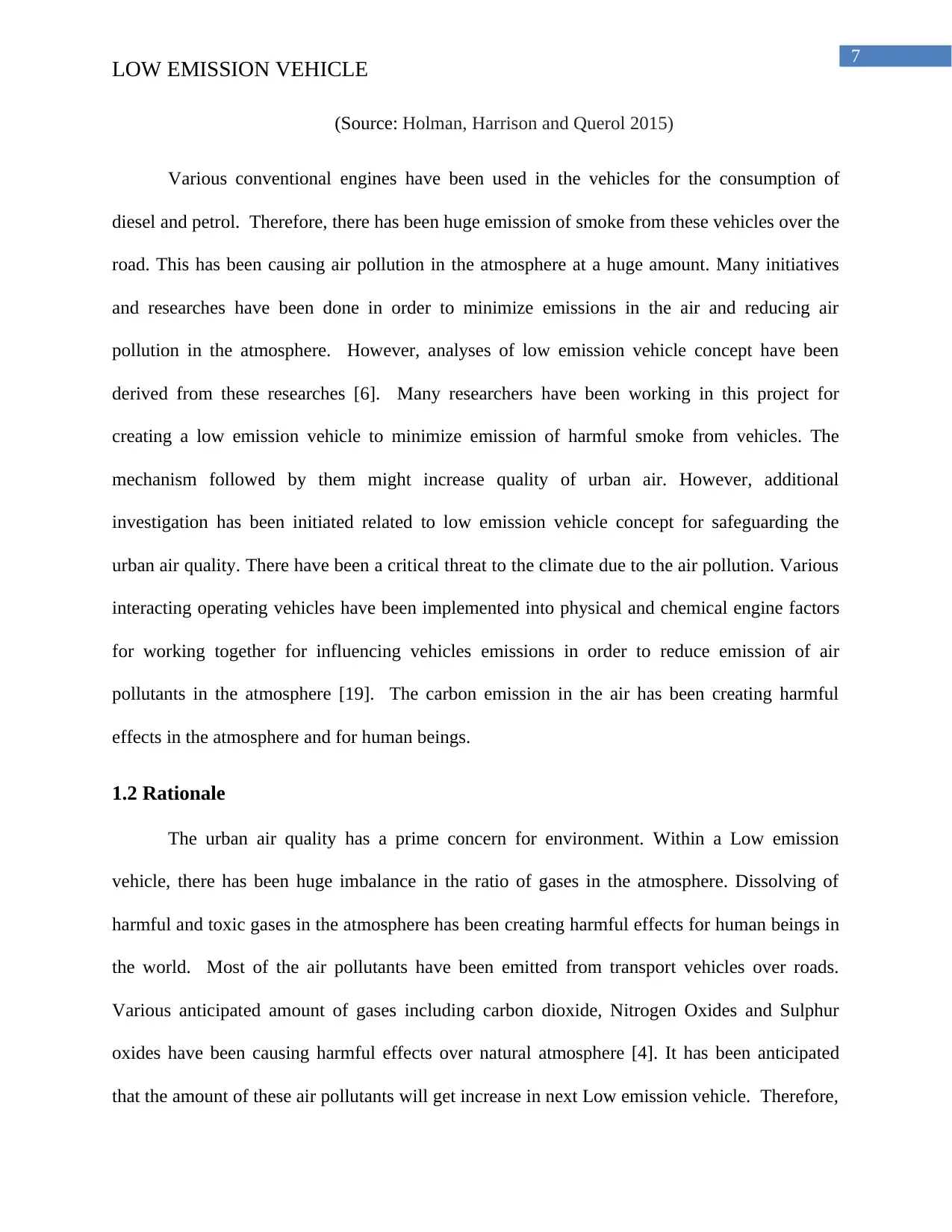
7
LOW EMISSION VEHICLE
(Source: Holman, Harrison and Querol 2015)
Various conventional engines have been used in the vehicles for the consumption of
diesel and petrol. Therefore, there has been huge emission of smoke from these vehicles over the
road. This has been causing air pollution in the atmosphere at a huge amount. Many initiatives
and researches have been done in order to minimize emissions in the air and reducing air
pollution in the atmosphere. However, analyses of low emission vehicle concept have been
derived from these researches [6]. Many researchers have been working in this project for
creating a low emission vehicle to minimize emission of harmful smoke from vehicles. The
mechanism followed by them might increase quality of urban air. However, additional
investigation has been initiated related to low emission vehicle concept for safeguarding the
urban air quality. There have been a critical threat to the climate due to the air pollution. Various
interacting operating vehicles have been implemented into physical and chemical engine factors
for working together for influencing vehicles emissions in order to reduce emission of air
pollutants in the atmosphere [19]. The carbon emission in the air has been creating harmful
effects in the atmosphere and for human beings.
1.2 Rationale
The urban air quality has a prime concern for environment. Within a Low emission
vehicle, there has been huge imbalance in the ratio of gases in the atmosphere. Dissolving of
harmful and toxic gases in the atmosphere has been creating harmful effects for human beings in
the world. Most of the air pollutants have been emitted from transport vehicles over roads.
Various anticipated amount of gases including carbon dioxide, Nitrogen Oxides and Sulphur
oxides have been causing harmful effects over natural atmosphere [4]. It has been anticipated
that the amount of these air pollutants will get increase in next Low emission vehicle. Therefore,
LOW EMISSION VEHICLE
(Source: Holman, Harrison and Querol 2015)
Various conventional engines have been used in the vehicles for the consumption of
diesel and petrol. Therefore, there has been huge emission of smoke from these vehicles over the
road. This has been causing air pollution in the atmosphere at a huge amount. Many initiatives
and researches have been done in order to minimize emissions in the air and reducing air
pollution in the atmosphere. However, analyses of low emission vehicle concept have been
derived from these researches [6]. Many researchers have been working in this project for
creating a low emission vehicle to minimize emission of harmful smoke from vehicles. The
mechanism followed by them might increase quality of urban air. However, additional
investigation has been initiated related to low emission vehicle concept for safeguarding the
urban air quality. There have been a critical threat to the climate due to the air pollution. Various
interacting operating vehicles have been implemented into physical and chemical engine factors
for working together for influencing vehicles emissions in order to reduce emission of air
pollutants in the atmosphere [19]. The carbon emission in the air has been creating harmful
effects in the atmosphere and for human beings.
1.2 Rationale
The urban air quality has a prime concern for environment. Within a Low emission
vehicle, there has been huge imbalance in the ratio of gases in the atmosphere. Dissolving of
harmful and toxic gases in the atmosphere has been creating harmful effects for human beings in
the world. Most of the air pollutants have been emitted from transport vehicles over roads.
Various anticipated amount of gases including carbon dioxide, Nitrogen Oxides and Sulphur
oxides have been causing harmful effects over natural atmosphere [4]. It has been anticipated
that the amount of these air pollutants will get increase in next Low emission vehicle. Therefore,
Paraphrase This Document
Need a fresh take? Get an instant paraphrase of this document with our AI Paraphraser
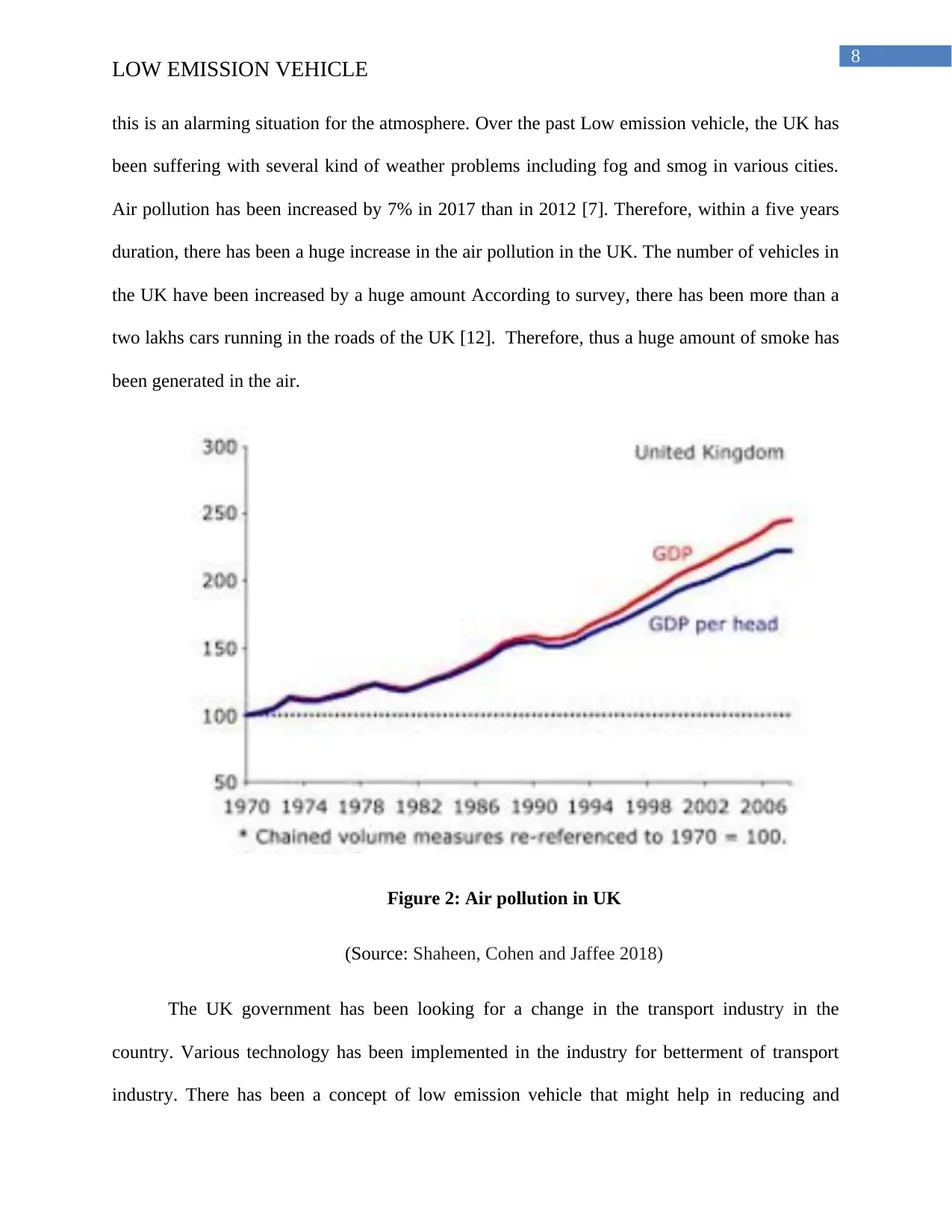
8
LOW EMISSION VEHICLE
this is an alarming situation for the atmosphere. Over the past Low emission vehicle, the UK has
been suffering with several kind of weather problems including fog and smog in various cities.
Air pollution has been increased by 7% in 2017 than in 2012 [7]. Therefore, within a five years
duration, there has been a huge increase in the air pollution in the UK. The number of vehicles in
the UK have been increased by a huge amount According to survey, there has been more than a
two lakhs cars running in the roads of the UK [12]. Therefore, thus a huge amount of smoke has
been generated in the air.
Figure 2: Air pollution in UK
(Source: Shaheen, Cohen and Jaffee 2018)
The UK government has been looking for a change in the transport industry in the
country. Various technology has been implemented in the industry for betterment of transport
industry. There has been a concept of low emission vehicle that might help in reducing and
LOW EMISSION VEHICLE
this is an alarming situation for the atmosphere. Over the past Low emission vehicle, the UK has
been suffering with several kind of weather problems including fog and smog in various cities.
Air pollution has been increased by 7% in 2017 than in 2012 [7]. Therefore, within a five years
duration, there has been a huge increase in the air pollution in the UK. The number of vehicles in
the UK have been increased by a huge amount According to survey, there has been more than a
two lakhs cars running in the roads of the UK [12]. Therefore, thus a huge amount of smoke has
been generated in the air.
Figure 2: Air pollution in UK
(Source: Shaheen, Cohen and Jaffee 2018)
The UK government has been looking for a change in the transport industry in the
country. Various technology has been implemented in the industry for betterment of transport
industry. There has been a concept of low emission vehicle that might help in reducing and
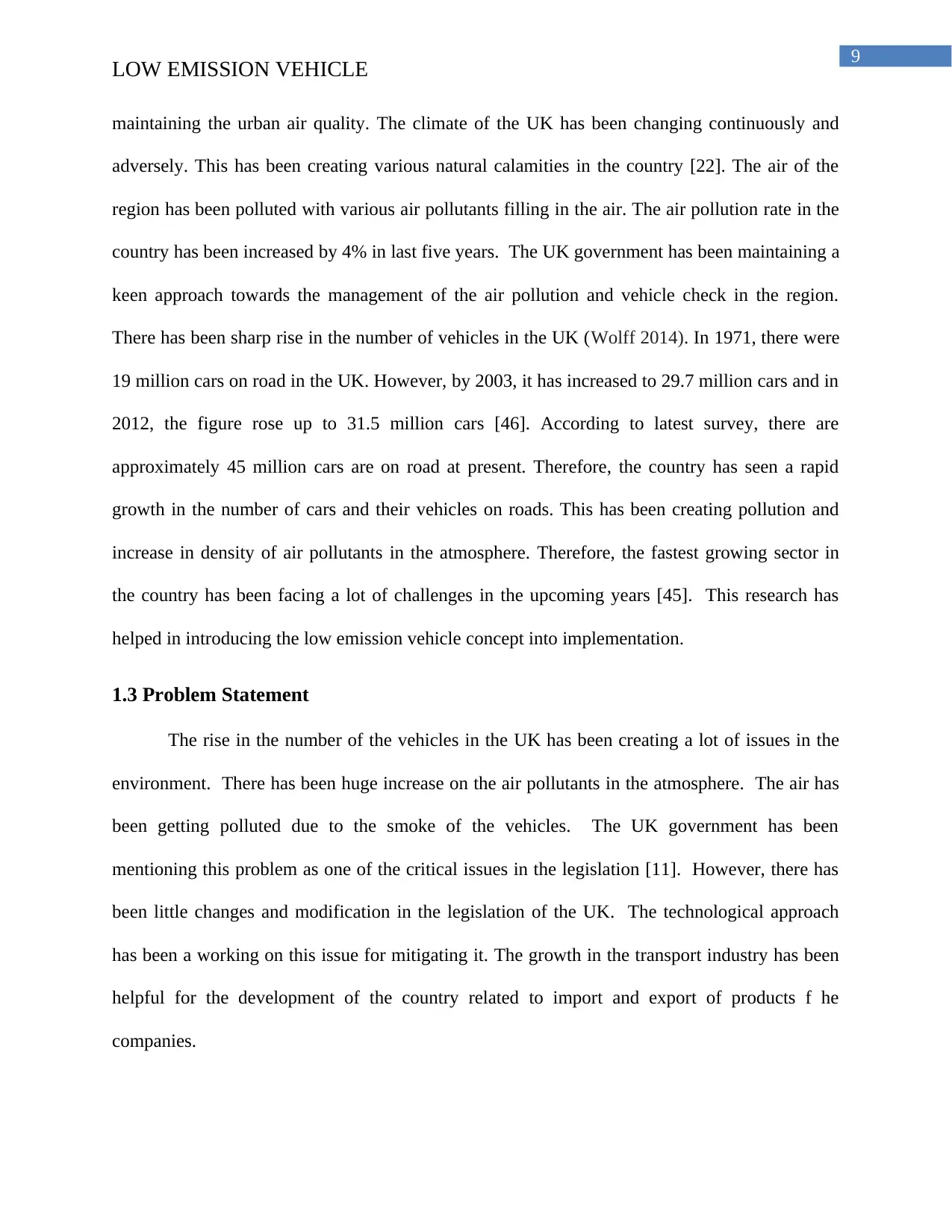
9
LOW EMISSION VEHICLE
maintaining the urban air quality. The climate of the UK has been changing continuously and
adversely. This has been creating various natural calamities in the country [22]. The air of the
region has been polluted with various air pollutants filling in the air. The air pollution rate in the
country has been increased by 4% in last five years. The UK government has been maintaining a
keen approach towards the management of the air pollution and vehicle check in the region.
There has been sharp rise in the number of vehicles in the UK (Wolff 2014). In 1971, there were
19 million cars on road in the UK. However, by 2003, it has increased to 29.7 million cars and in
2012, the figure rose up to 31.5 million cars [46]. According to latest survey, there are
approximately 45 million cars are on road at present. Therefore, the country has seen a rapid
growth in the number of cars and their vehicles on roads. This has been creating pollution and
increase in density of air pollutants in the atmosphere. Therefore, the fastest growing sector in
the country has been facing a lot of challenges in the upcoming years [45]. This research has
helped in introducing the low emission vehicle concept into implementation.
1.3 Problem Statement
The rise in the number of the vehicles in the UK has been creating a lot of issues in the
environment. There has been huge increase on the air pollutants in the atmosphere. The air has
been getting polluted due to the smoke of the vehicles. The UK government has been
mentioning this problem as one of the critical issues in the legislation [11]. However, there has
been little changes and modification in the legislation of the UK. The technological approach
has been a working on this issue for mitigating it. The growth in the transport industry has been
helpful for the development of the country related to import and export of products f he
companies.
LOW EMISSION VEHICLE
maintaining the urban air quality. The climate of the UK has been changing continuously and
adversely. This has been creating various natural calamities in the country [22]. The air of the
region has been polluted with various air pollutants filling in the air. The air pollution rate in the
country has been increased by 4% in last five years. The UK government has been maintaining a
keen approach towards the management of the air pollution and vehicle check in the region.
There has been sharp rise in the number of vehicles in the UK (Wolff 2014). In 1971, there were
19 million cars on road in the UK. However, by 2003, it has increased to 29.7 million cars and in
2012, the figure rose up to 31.5 million cars [46]. According to latest survey, there are
approximately 45 million cars are on road at present. Therefore, the country has seen a rapid
growth in the number of cars and their vehicles on roads. This has been creating pollution and
increase in density of air pollutants in the atmosphere. Therefore, the fastest growing sector in
the country has been facing a lot of challenges in the upcoming years [45]. This research has
helped in introducing the low emission vehicle concept into implementation.
1.3 Problem Statement
The rise in the number of the vehicles in the UK has been creating a lot of issues in the
environment. There has been huge increase on the air pollutants in the atmosphere. The air has
been getting polluted due to the smoke of the vehicles. The UK government has been
mentioning this problem as one of the critical issues in the legislation [11]. However, there has
been little changes and modification in the legislation of the UK. The technological approach
has been a working on this issue for mitigating it. The growth in the transport industry has been
helpful for the development of the country related to import and export of products f he
companies.
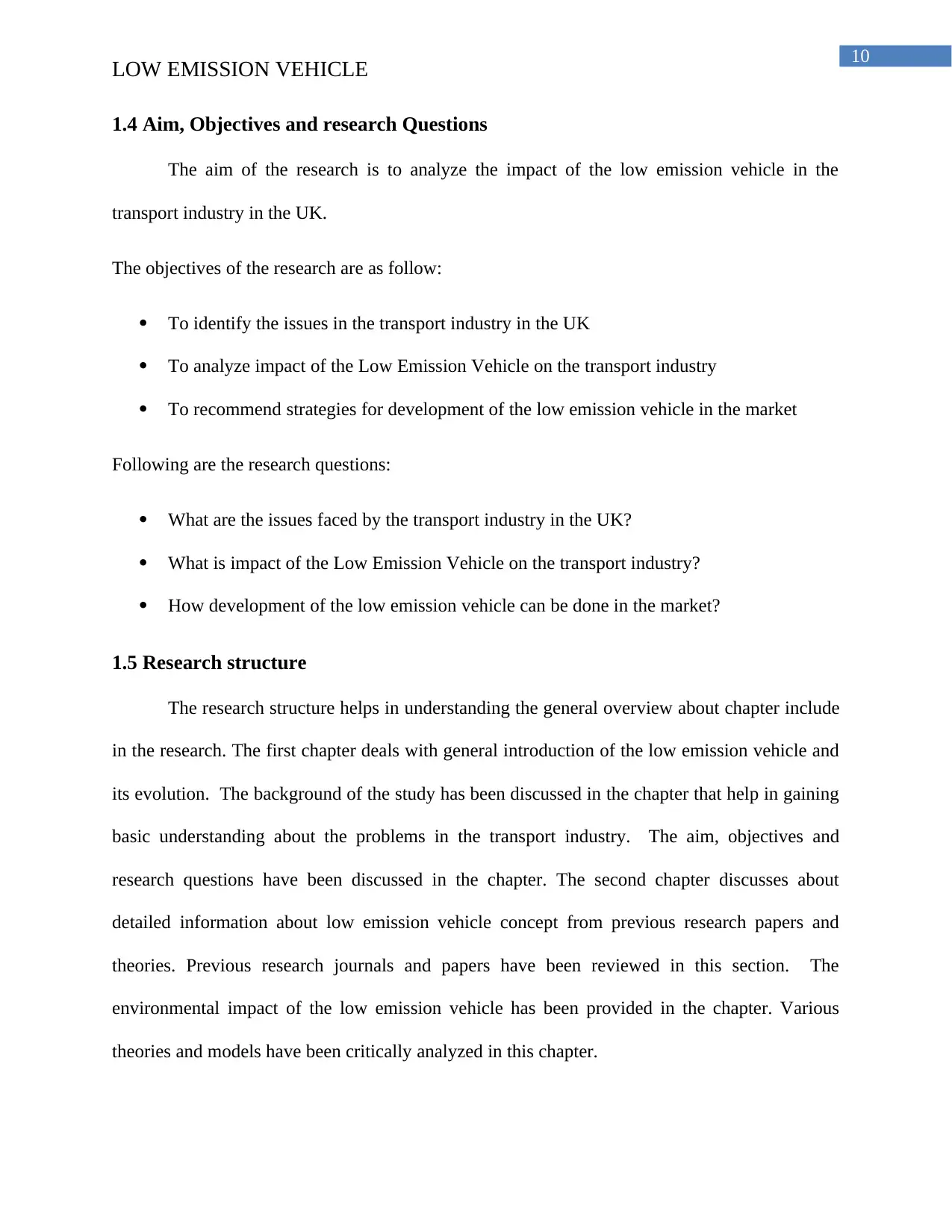
10
LOW EMISSION VEHICLE
1.4 Aim, Objectives and research Questions
The aim of the research is to analyze the impact of the low emission vehicle in the
transport industry in the UK.
The objectives of the research are as follow:
To identify the issues in the transport industry in the UK
To analyze impact of the Low Emission Vehicle on the transport industry
To recommend strategies for development of the low emission vehicle in the market
Following are the research questions:
What are the issues faced by the transport industry in the UK?
What is impact of the Low Emission Vehicle on the transport industry?
How development of the low emission vehicle can be done in the market?
1.5 Research structure
The research structure helps in understanding the general overview about chapter include
in the research. The first chapter deals with general introduction of the low emission vehicle and
its evolution. The background of the study has been discussed in the chapter that help in gaining
basic understanding about the problems in the transport industry. The aim, objectives and
research questions have been discussed in the chapter. The second chapter discusses about
detailed information about low emission vehicle concept from previous research papers and
theories. Previous research journals and papers have been reviewed in this section. The
environmental impact of the low emission vehicle has been provided in the chapter. Various
theories and models have been critically analyzed in this chapter.
LOW EMISSION VEHICLE
1.4 Aim, Objectives and research Questions
The aim of the research is to analyze the impact of the low emission vehicle in the
transport industry in the UK.
The objectives of the research are as follow:
To identify the issues in the transport industry in the UK
To analyze impact of the Low Emission Vehicle on the transport industry
To recommend strategies for development of the low emission vehicle in the market
Following are the research questions:
What are the issues faced by the transport industry in the UK?
What is impact of the Low Emission Vehicle on the transport industry?
How development of the low emission vehicle can be done in the market?
1.5 Research structure
The research structure helps in understanding the general overview about chapter include
in the research. The first chapter deals with general introduction of the low emission vehicle and
its evolution. The background of the study has been discussed in the chapter that help in gaining
basic understanding about the problems in the transport industry. The aim, objectives and
research questions have been discussed in the chapter. The second chapter discusses about
detailed information about low emission vehicle concept from previous research papers and
theories. Previous research journals and papers have been reviewed in this section. The
environmental impact of the low emission vehicle has been provided in the chapter. Various
theories and models have been critically analyzed in this chapter.
Secure Best Marks with AI Grader
Need help grading? Try our AI Grader for instant feedback on your assignments.
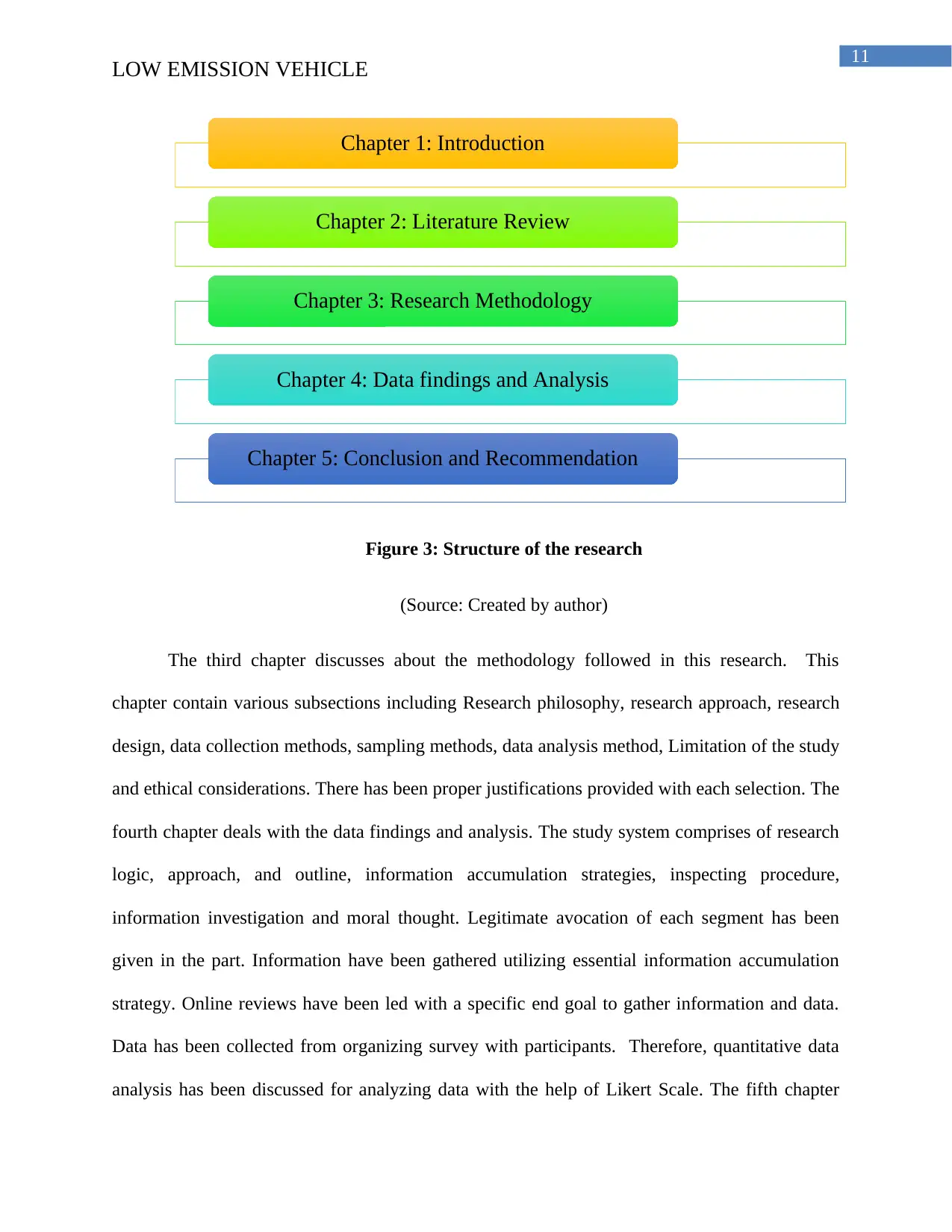
11
LOW EMISSION VEHICLE
Figure 3: Structure of the research
(Source: Created by author)
The third chapter discusses about the methodology followed in this research. This
chapter contain various subsections including Research philosophy, research approach, research
design, data collection methods, sampling methods, data analysis method, Limitation of the study
and ethical considerations. There has been proper justifications provided with each selection. The
fourth chapter deals with the data findings and analysis. The study system comprises of research
logic, approach, and outline, information accumulation strategies, inspecting procedure,
information investigation and moral thought. Legitimate avocation of each segment has been
given in the part. Information have been gathered utilizing essential information accumulation
strategy. Online reviews have been led with a specific end goal to gather information and data.
Data has been collected from organizing survey with participants. Therefore, quantitative data
analysis has been discussed for analyzing data with the help of Likert Scale. The fifth chapter
Chapter 1: Introduction
Chapter 2: Literature Review
Chapter 3: Research Methodology
Chapter 4: Data findings and Analysis
Chapter 5: Conclusion and Recommendation
LOW EMISSION VEHICLE
Figure 3: Structure of the research
(Source: Created by author)
The third chapter discusses about the methodology followed in this research. This
chapter contain various subsections including Research philosophy, research approach, research
design, data collection methods, sampling methods, data analysis method, Limitation of the study
and ethical considerations. There has been proper justifications provided with each selection. The
fourth chapter deals with the data findings and analysis. The study system comprises of research
logic, approach, and outline, information accumulation strategies, inspecting procedure,
information investigation and moral thought. Legitimate avocation of each segment has been
given in the part. Information have been gathered utilizing essential information accumulation
strategy. Online reviews have been led with a specific end goal to gather information and data.
Data has been collected from organizing survey with participants. Therefore, quantitative data
analysis has been discussed for analyzing data with the help of Likert Scale. The fifth chapter
Chapter 1: Introduction
Chapter 2: Literature Review
Chapter 3: Research Methodology
Chapter 4: Data findings and Analysis
Chapter 5: Conclusion and Recommendation

12
LOW EMISSION VEHICLE
focuses on conclusion and recommendations for the research study. The results have been
displayed with the help of charts and graphs. The linking with the objective has been done in
this section. Some recommendations have been provided in order to modify and enhance the
future study in the topic.
LOW EMISSION VEHICLE
focuses on conclusion and recommendations for the research study. The results have been
displayed with the help of charts and graphs. The linking with the objective has been done in
this section. Some recommendations have been provided in order to modify and enhance the
future study in the topic.
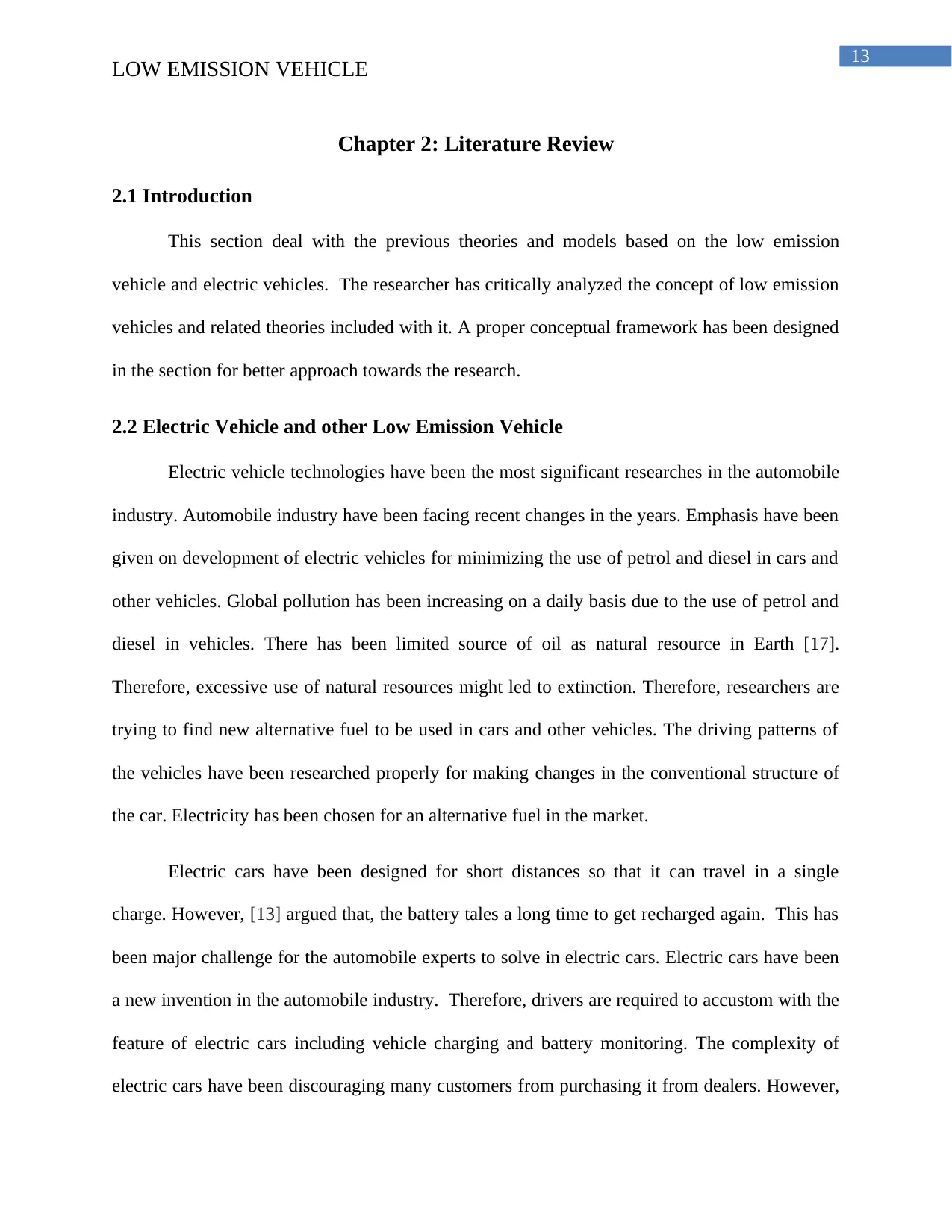
13
LOW EMISSION VEHICLE
Chapter 2: Literature Review
2.1 Introduction
This section deal with the previous theories and models based on the low emission
vehicle and electric vehicles. The researcher has critically analyzed the concept of low emission
vehicles and related theories included with it. A proper conceptual framework has been designed
in the section for better approach towards the research.
2.2 Electric Vehicle and other Low Emission Vehicle
Electric vehicle technologies have been the most significant researches in the automobile
industry. Automobile industry have been facing recent changes in the years. Emphasis have been
given on development of electric vehicles for minimizing the use of petrol and diesel in cars and
other vehicles. Global pollution has been increasing on a daily basis due to the use of petrol and
diesel in vehicles. There has been limited source of oil as natural resource in Earth [17].
Therefore, excessive use of natural resources might led to extinction. Therefore, researchers are
trying to find new alternative fuel to be used in cars and other vehicles. The driving patterns of
the vehicles have been researched properly for making changes in the conventional structure of
the car. Electricity has been chosen for an alternative fuel in the market.
Electric cars have been designed for short distances so that it can travel in a single
charge. However, [13] argued that, the battery tales a long time to get recharged again. This has
been major challenge for the automobile experts to solve in electric cars. Electric cars have been
a new invention in the automobile industry. Therefore, drivers are required to accustom with the
feature of electric cars including vehicle charging and battery monitoring. The complexity of
electric cars have been discouraging many customers from purchasing it from dealers. However,
LOW EMISSION VEHICLE
Chapter 2: Literature Review
2.1 Introduction
This section deal with the previous theories and models based on the low emission
vehicle and electric vehicles. The researcher has critically analyzed the concept of low emission
vehicles and related theories included with it. A proper conceptual framework has been designed
in the section for better approach towards the research.
2.2 Electric Vehicle and other Low Emission Vehicle
Electric vehicle technologies have been the most significant researches in the automobile
industry. Automobile industry have been facing recent changes in the years. Emphasis have been
given on development of electric vehicles for minimizing the use of petrol and diesel in cars and
other vehicles. Global pollution has been increasing on a daily basis due to the use of petrol and
diesel in vehicles. There has been limited source of oil as natural resource in Earth [17].
Therefore, excessive use of natural resources might led to extinction. Therefore, researchers are
trying to find new alternative fuel to be used in cars and other vehicles. The driving patterns of
the vehicles have been researched properly for making changes in the conventional structure of
the car. Electricity has been chosen for an alternative fuel in the market.
Electric cars have been designed for short distances so that it can travel in a single
charge. However, [13] argued that, the battery tales a long time to get recharged again. This has
been major challenge for the automobile experts to solve in electric cars. Electric cars have been
a new invention in the automobile industry. Therefore, drivers are required to accustom with the
feature of electric cars including vehicle charging and battery monitoring. The complexity of
electric cars have been discouraging many customers from purchasing it from dealers. However,
Paraphrase This Document
Need a fresh take? Get an instant paraphrase of this document with our AI Paraphraser
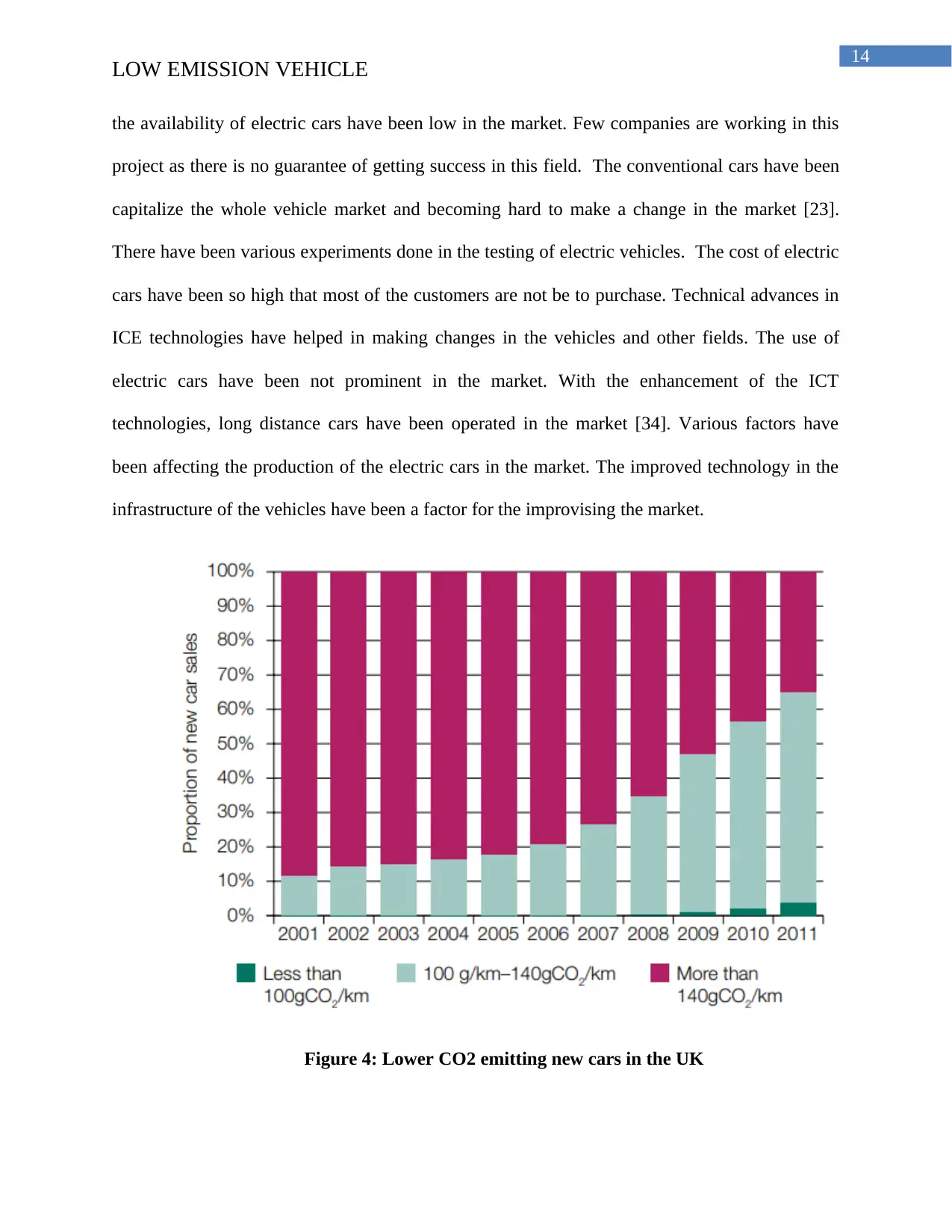
14
LOW EMISSION VEHICLE
the availability of electric cars have been low in the market. Few companies are working in this
project as there is no guarantee of getting success in this field. The conventional cars have been
capitalize the whole vehicle market and becoming hard to make a change in the market [23].
There have been various experiments done in the testing of electric vehicles. The cost of electric
cars have been so high that most of the customers are not be to purchase. Technical advances in
ICE technologies have helped in making changes in the vehicles and other fields. The use of
electric cars have been not prominent in the market. With the enhancement of the ICT
technologies, long distance cars have been operated in the market [34]. Various factors have
been affecting the production of the electric cars in the market. The improved technology in the
infrastructure of the vehicles have been a factor for the improvising the market.
Figure 4: Lower CO2 emitting new cars in the UK
LOW EMISSION VEHICLE
the availability of electric cars have been low in the market. Few companies are working in this
project as there is no guarantee of getting success in this field. The conventional cars have been
capitalize the whole vehicle market and becoming hard to make a change in the market [23].
There have been various experiments done in the testing of electric vehicles. The cost of electric
cars have been so high that most of the customers are not be to purchase. Technical advances in
ICE technologies have helped in making changes in the vehicles and other fields. The use of
electric cars have been not prominent in the market. With the enhancement of the ICT
technologies, long distance cars have been operated in the market [34]. Various factors have
been affecting the production of the electric cars in the market. The improved technology in the
infrastructure of the vehicles have been a factor for the improvising the market.
Figure 4: Lower CO2 emitting new cars in the UK
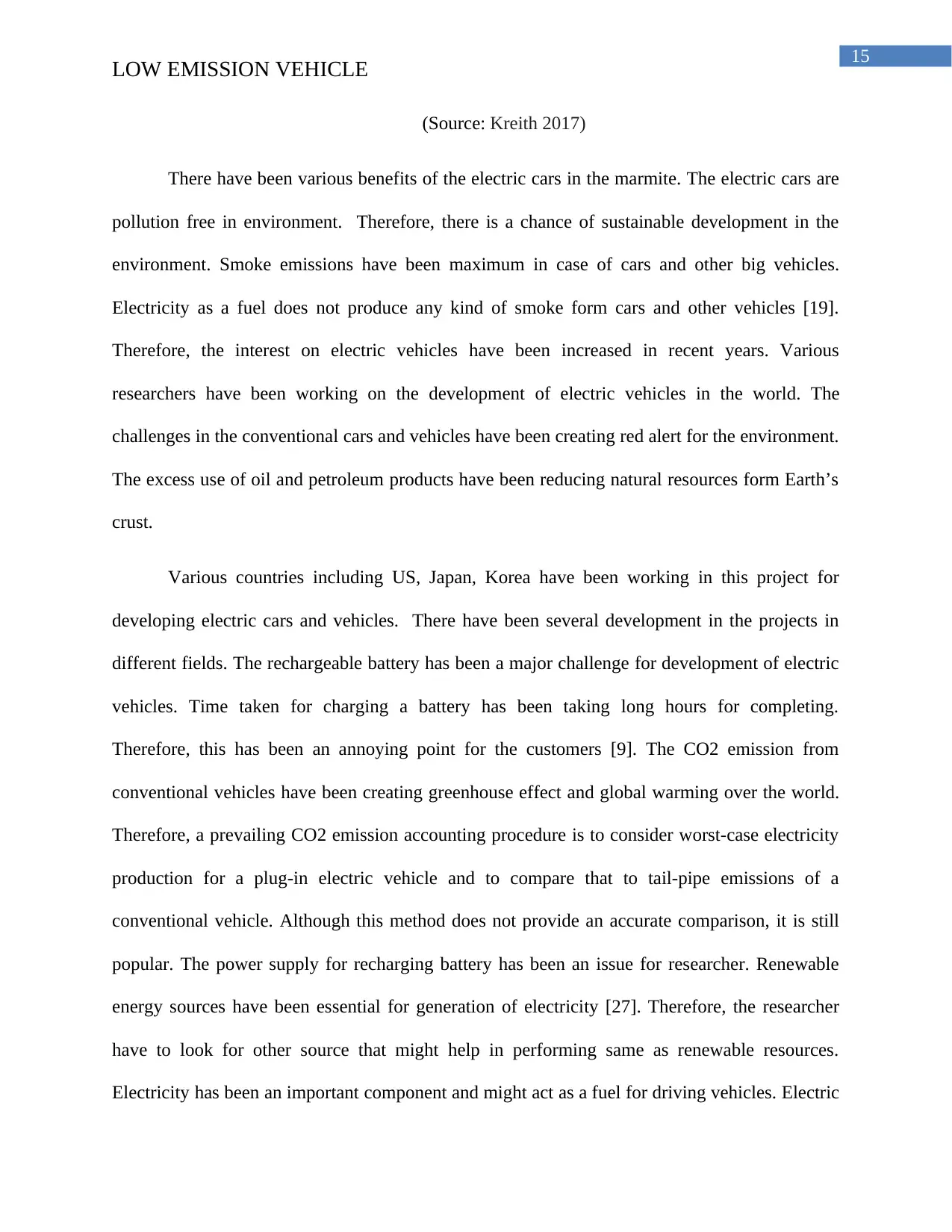
15
LOW EMISSION VEHICLE
(Source: Kreith 2017)
There have been various benefits of the electric cars in the marmite. The electric cars are
pollution free in environment. Therefore, there is a chance of sustainable development in the
environment. Smoke emissions have been maximum in case of cars and other big vehicles.
Electricity as a fuel does not produce any kind of smoke form cars and other vehicles [19].
Therefore, the interest on electric vehicles have been increased in recent years. Various
researchers have been working on the development of electric vehicles in the world. The
challenges in the conventional cars and vehicles have been creating red alert for the environment.
The excess use of oil and petroleum products have been reducing natural resources form Earth’s
crust.
Various countries including US, Japan, Korea have been working in this project for
developing electric cars and vehicles. There have been several development in the projects in
different fields. The rechargeable battery has been a major challenge for development of electric
vehicles. Time taken for charging a battery has been taking long hours for completing.
Therefore, this has been an annoying point for the customers [9]. The CO2 emission from
conventional vehicles have been creating greenhouse effect and global warming over the world.
Therefore, a prevailing CO2 emission accounting procedure is to consider worst-case electricity
production for a plug-in electric vehicle and to compare that to tail-pipe emissions of a
conventional vehicle. Although this method does not provide an accurate comparison, it is still
popular. The power supply for recharging battery has been an issue for researcher. Renewable
energy sources have been essential for generation of electricity [27]. Therefore, the researcher
have to look for other source that might help in performing same as renewable resources.
Electricity has been an important component and might act as a fuel for driving vehicles. Electric
LOW EMISSION VEHICLE
(Source: Kreith 2017)
There have been various benefits of the electric cars in the marmite. The electric cars are
pollution free in environment. Therefore, there is a chance of sustainable development in the
environment. Smoke emissions have been maximum in case of cars and other big vehicles.
Electricity as a fuel does not produce any kind of smoke form cars and other vehicles [19].
Therefore, the interest on electric vehicles have been increased in recent years. Various
researchers have been working on the development of electric vehicles in the world. The
challenges in the conventional cars and vehicles have been creating red alert for the environment.
The excess use of oil and petroleum products have been reducing natural resources form Earth’s
crust.
Various countries including US, Japan, Korea have been working in this project for
developing electric cars and vehicles. There have been several development in the projects in
different fields. The rechargeable battery has been a major challenge for development of electric
vehicles. Time taken for charging a battery has been taking long hours for completing.
Therefore, this has been an annoying point for the customers [9]. The CO2 emission from
conventional vehicles have been creating greenhouse effect and global warming over the world.
Therefore, a prevailing CO2 emission accounting procedure is to consider worst-case electricity
production for a plug-in electric vehicle and to compare that to tail-pipe emissions of a
conventional vehicle. Although this method does not provide an accurate comparison, it is still
popular. The power supply for recharging battery has been an issue for researcher. Renewable
energy sources have been essential for generation of electricity [27]. Therefore, the researcher
have to look for other source that might help in performing same as renewable resources.
Electricity has been an important component and might act as a fuel for driving vehicles. Electric
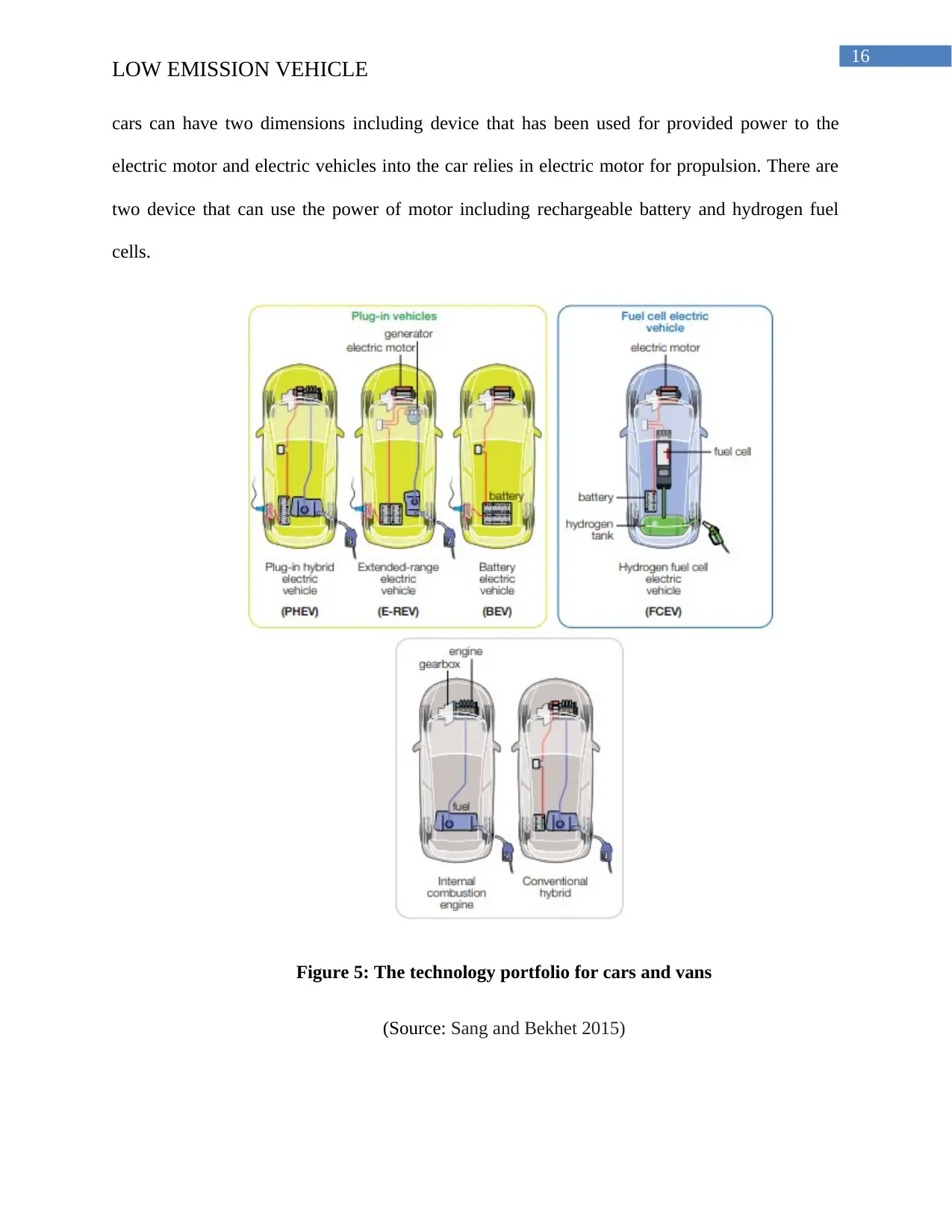
16
LOW EMISSION VEHICLE
cars can have two dimensions including device that has been used for provided power to the
electric motor and electric vehicles into the car relies in electric motor for propulsion. There are
two device that can use the power of motor including rechargeable battery and hydrogen fuel
cells.
Figure 5: The technology portfolio for cars and vans
(Source: Sang and Bekhet 2015)
LOW EMISSION VEHICLE
cars can have two dimensions including device that has been used for provided power to the
electric motor and electric vehicles into the car relies in electric motor for propulsion. There are
two device that can use the power of motor including rechargeable battery and hydrogen fuel
cells.
Figure 5: The technology portfolio for cars and vans
(Source: Sang and Bekhet 2015)
Secure Best Marks with AI Grader
Need help grading? Try our AI Grader for instant feedback on your assignments.
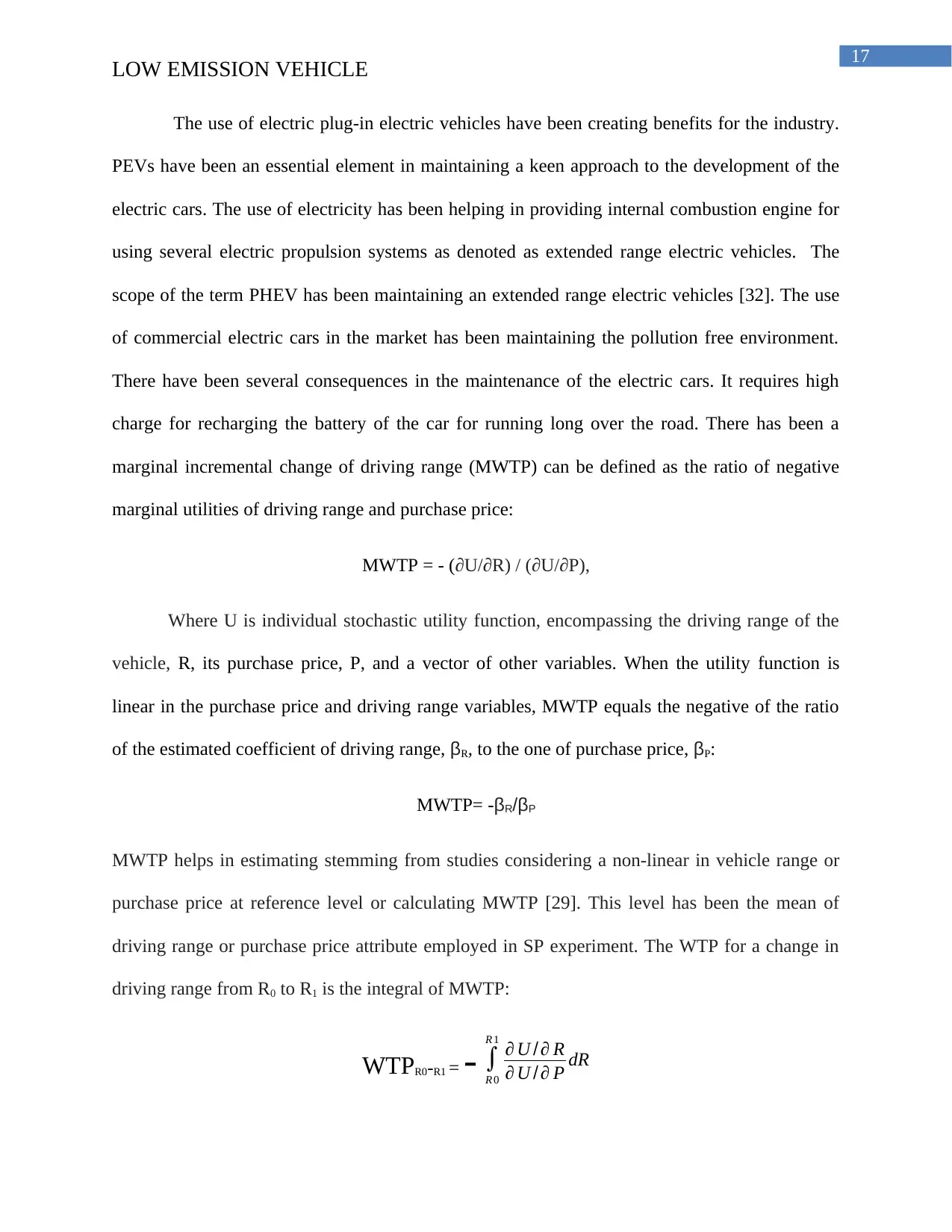
17
LOW EMISSION VEHICLE
The use of electric plug-in electric vehicles have been creating benefits for the industry.
PEVs have been an essential element in maintaining a keen approach to the development of the
electric cars. The use of electricity has been helping in providing internal combustion engine for
using several electric propulsion systems as denoted as extended range electric vehicles. The
scope of the term PHEV has been maintaining an extended range electric vehicles [32]. The use
of commercial electric cars in the market has been maintaining the pollution free environment.
There have been several consequences in the maintenance of the electric cars. It requires high
charge for recharging the battery of the car for running long over the road. There has been a
marginal incremental change of driving range (MWTP) can be defined as the ratio of negative
marginal utilities of driving range and purchase price:
MWTP = - (∂U/∂R) / (∂U/∂P),
Where U is individual stochastic utility function, encompassing the driving range of the
vehicle, R, its purchase price, P, and a vector of other variables. When the utility function is
linear in the purchase price and driving range variables, MWTP equals the negative of the ratio
of the estimated coefficient of driving range, βR, to the one of purchase price, βP:
MWTP= -βR/βP
MWTP helps in estimating stemming from studies considering a non-linear in vehicle range or
purchase price at reference level or calculating MWTP [29]. This level has been the mean of
driving range or purchase price attribute employed in SP experiment. The WTP for a change in
driving range from R0 to R1 is the integral of MWTP:
WTPR0-R1 = - ∫
R 0
R 1
∂ U / ∂ R
∂ U / ∂ P dR
LOW EMISSION VEHICLE
The use of electric plug-in electric vehicles have been creating benefits for the industry.
PEVs have been an essential element in maintaining a keen approach to the development of the
electric cars. The use of electricity has been helping in providing internal combustion engine for
using several electric propulsion systems as denoted as extended range electric vehicles. The
scope of the term PHEV has been maintaining an extended range electric vehicles [32]. The use
of commercial electric cars in the market has been maintaining the pollution free environment.
There have been several consequences in the maintenance of the electric cars. It requires high
charge for recharging the battery of the car for running long over the road. There has been a
marginal incremental change of driving range (MWTP) can be defined as the ratio of negative
marginal utilities of driving range and purchase price:
MWTP = - (∂U/∂R) / (∂U/∂P),
Where U is individual stochastic utility function, encompassing the driving range of the
vehicle, R, its purchase price, P, and a vector of other variables. When the utility function is
linear in the purchase price and driving range variables, MWTP equals the negative of the ratio
of the estimated coefficient of driving range, βR, to the one of purchase price, βP:
MWTP= -βR/βP
MWTP helps in estimating stemming from studies considering a non-linear in vehicle range or
purchase price at reference level or calculating MWTP [29]. This level has been the mean of
driving range or purchase price attribute employed in SP experiment. The WTP for a change in
driving range from R0 to R1 is the integral of MWTP:
WTPR0-R1 = - ∫
R 0
R 1
∂ U / ∂ R
∂ U / ∂ P dR
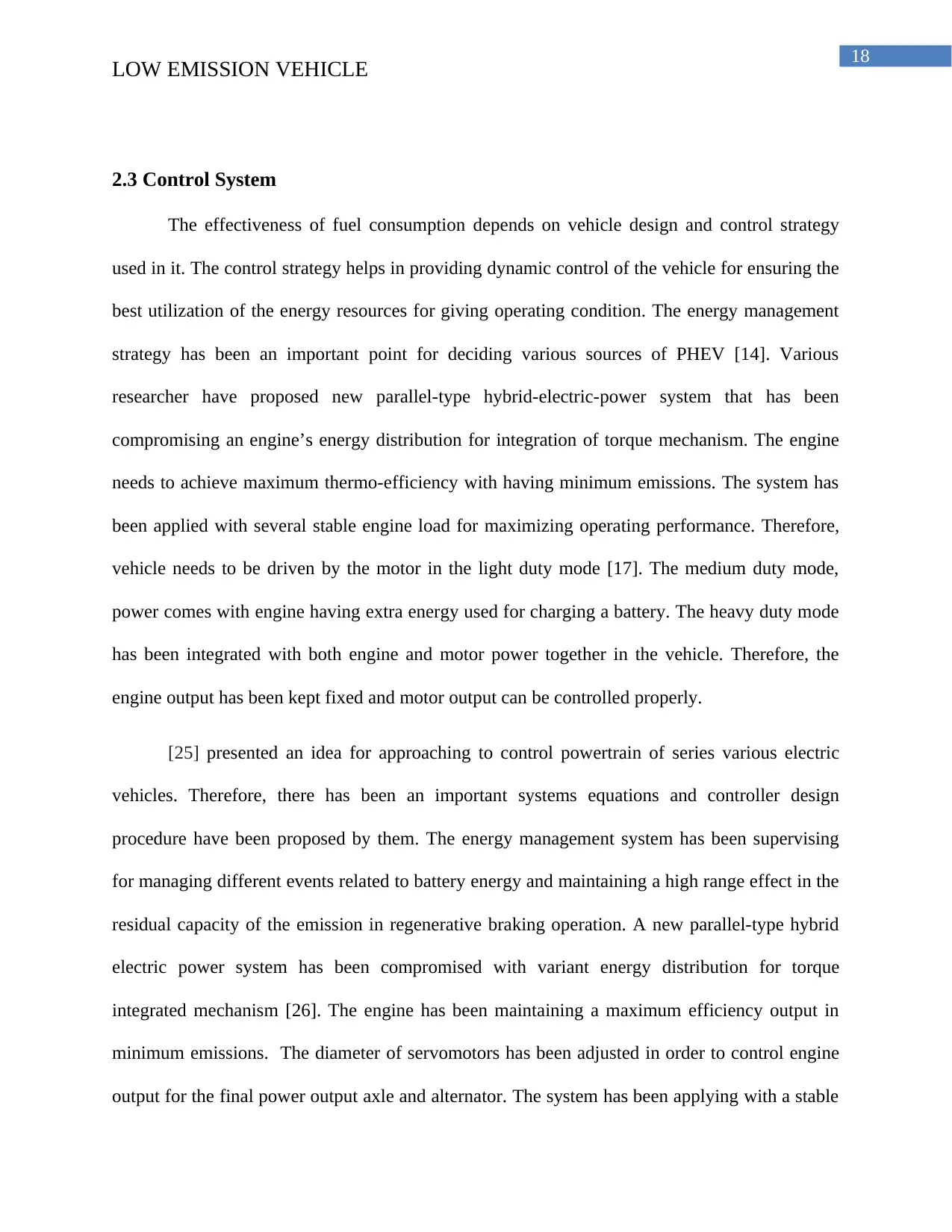
18
LOW EMISSION VEHICLE
2.3 Control System
The effectiveness of fuel consumption depends on vehicle design and control strategy
used in it. The control strategy helps in providing dynamic control of the vehicle for ensuring the
best utilization of the energy resources for giving operating condition. The energy management
strategy has been an important point for deciding various sources of PHEV [14]. Various
researcher have proposed new parallel-type hybrid-electric-power system that has been
compromising an engine’s energy distribution for integration of torque mechanism. The engine
needs to achieve maximum thermo-efficiency with having minimum emissions. The system has
been applied with several stable engine load for maximizing operating performance. Therefore,
vehicle needs to be driven by the motor in the light duty mode [17]. The medium duty mode,
power comes with engine having extra energy used for charging a battery. The heavy duty mode
has been integrated with both engine and motor power together in the vehicle. Therefore, the
engine output has been kept fixed and motor output can be controlled properly.
[25] presented an idea for approaching to control powertrain of series various electric
vehicles. Therefore, there has been an important systems equations and controller design
procedure have been proposed by them. The energy management system has been supervising
for managing different events related to battery energy and maintaining a high range effect in the
residual capacity of the emission in regenerative braking operation. A new parallel-type hybrid
electric power system has been compromised with variant energy distribution for torque
integrated mechanism [26]. The engine has been maintaining a maximum efficiency output in
minimum emissions. The diameter of servomotors has been adjusted in order to control engine
output for the final power output axle and alternator. The system has been applying with a stable
LOW EMISSION VEHICLE
2.3 Control System
The effectiveness of fuel consumption depends on vehicle design and control strategy
used in it. The control strategy helps in providing dynamic control of the vehicle for ensuring the
best utilization of the energy resources for giving operating condition. The energy management
strategy has been an important point for deciding various sources of PHEV [14]. Various
researcher have proposed new parallel-type hybrid-electric-power system that has been
compromising an engine’s energy distribution for integration of torque mechanism. The engine
needs to achieve maximum thermo-efficiency with having minimum emissions. The system has
been applied with several stable engine load for maximizing operating performance. Therefore,
vehicle needs to be driven by the motor in the light duty mode [17]. The medium duty mode,
power comes with engine having extra energy used for charging a battery. The heavy duty mode
has been integrated with both engine and motor power together in the vehicle. Therefore, the
engine output has been kept fixed and motor output can be controlled properly.
[25] presented an idea for approaching to control powertrain of series various electric
vehicles. Therefore, there has been an important systems equations and controller design
procedure have been proposed by them. The energy management system has been supervising
for managing different events related to battery energy and maintaining a high range effect in the
residual capacity of the emission in regenerative braking operation. A new parallel-type hybrid
electric power system has been compromised with variant energy distribution for torque
integrated mechanism [26]. The engine has been maintaining a maximum efficiency output in
minimum emissions. The diameter of servomotors has been adjusted in order to control engine
output for the final power output axle and alternator. The system has been applying with a stable
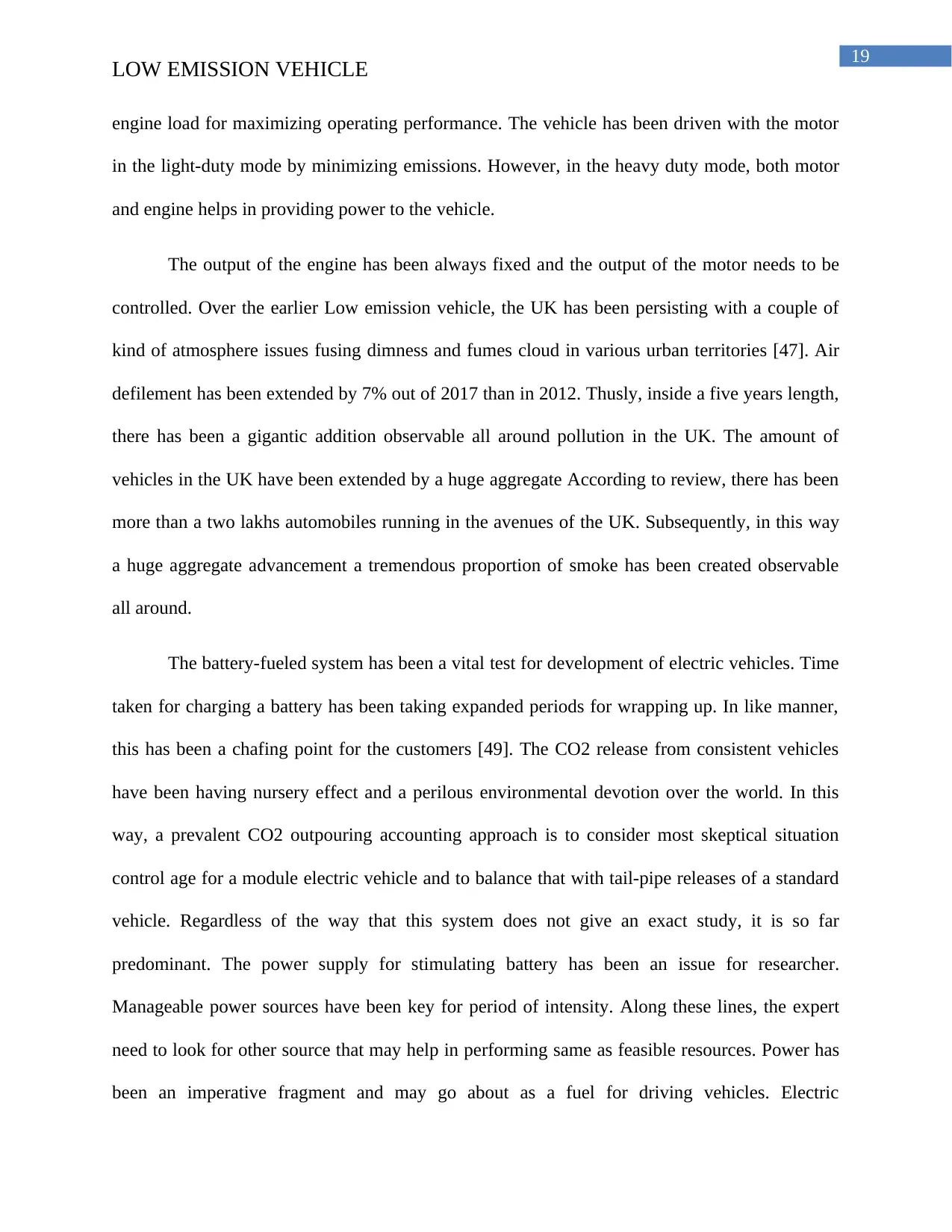
19
LOW EMISSION VEHICLE
engine load for maximizing operating performance. The vehicle has been driven with the motor
in the light-duty mode by minimizing emissions. However, in the heavy duty mode, both motor
and engine helps in providing power to the vehicle.
The output of the engine has been always fixed and the output of the motor needs to be
controlled. Over the earlier Low emission vehicle, the UK has been persisting with a couple of
kind of atmosphere issues fusing dimness and fumes cloud in various urban territories [47]. Air
defilement has been extended by 7% out of 2017 than in 2012. Thusly, inside a five years length,
there has been a gigantic addition observable all around pollution in the UK. The amount of
vehicles in the UK have been extended by a huge aggregate According to review, there has been
more than a two lakhs automobiles running in the avenues of the UK. Subsequently, in this way
a huge aggregate advancement a tremendous proportion of smoke has been created observable
all around.
The battery-fueled system has been a vital test for development of electric vehicles. Time
taken for charging a battery has been taking expanded periods for wrapping up. In like manner,
this has been a chafing point for the customers [49]. The CO2 release from consistent vehicles
have been having nursery effect and a perilous environmental devotion over the world. In this
way, a prevalent CO2 outpouring accounting approach is to consider most skeptical situation
control age for a module electric vehicle and to balance that with tail-pipe releases of a standard
vehicle. Regardless of the way that this system does not give an exact study, it is so far
predominant. The power supply for stimulating battery has been an issue for researcher.
Manageable power sources have been key for period of intensity. Along these lines, the expert
need to look for other source that may help in performing same as feasible resources. Power has
been an imperative fragment and may go about as a fuel for driving vehicles. Electric
LOW EMISSION VEHICLE
engine load for maximizing operating performance. The vehicle has been driven with the motor
in the light-duty mode by minimizing emissions. However, in the heavy duty mode, both motor
and engine helps in providing power to the vehicle.
The output of the engine has been always fixed and the output of the motor needs to be
controlled. Over the earlier Low emission vehicle, the UK has been persisting with a couple of
kind of atmosphere issues fusing dimness and fumes cloud in various urban territories [47]. Air
defilement has been extended by 7% out of 2017 than in 2012. Thusly, inside a five years length,
there has been a gigantic addition observable all around pollution in the UK. The amount of
vehicles in the UK have been extended by a huge aggregate According to review, there has been
more than a two lakhs automobiles running in the avenues of the UK. Subsequently, in this way
a huge aggregate advancement a tremendous proportion of smoke has been created observable
all around.
The battery-fueled system has been a vital test for development of electric vehicles. Time
taken for charging a battery has been taking expanded periods for wrapping up. In like manner,
this has been a chafing point for the customers [49]. The CO2 release from consistent vehicles
have been having nursery effect and a perilous environmental devotion over the world. In this
way, a prevalent CO2 outpouring accounting approach is to consider most skeptical situation
control age for a module electric vehicle and to balance that with tail-pipe releases of a standard
vehicle. Regardless of the way that this system does not give an exact study, it is so far
predominant. The power supply for stimulating battery has been an issue for researcher.
Manageable power sources have been key for period of intensity. Along these lines, the expert
need to look for other source that may help in performing same as feasible resources. Power has
been an imperative fragment and may go about as a fuel for driving vehicles. Electric
Paraphrase This Document
Need a fresh take? Get an instant paraphrase of this document with our AI Paraphraser

20
LOW EMISSION VEHICLE
automobiles can have two estimations including device that has been used for offered ability to
the electric motor and electric vehicles into the auto depends in electric motor for drive [31].
There are two device that can use the force of motor including battery-controlled battery and
hydrogen vitality segments.
The use of electric module electric vehicles have been making benefits for the business.
PEVs have been a principal segment in keeping up a sharp method to manage the change of the
electric automobiles. The use of intensity has been helping in giving inside consuming engine to
using a couple of electric stimulus systems as implied as expanded run electric vehicles [28]. The
degree of the term PHEV has been keeping up an extended territory electric vehicles. The use of
business electric cars in the market has been keeping up the defilement free condition. There
have been a couple of results in the help of the electric cars. It requires high charge for
stimulating the battery of the auto for running long over the road.
The formulation of equations of the system has been controlling overall design of the
power converter in the system. A new switching algorithm has been developed in order to
maintain a keen approach to the development of low emission engine in motor vehicles. Speed
and torque coupling has been hybrid drivetrain in nature. This help in providing control in
emission of gases from vehicles. Several simulations have been showing that the fuel economy
have been maintaining in the urban highway driving cycles for improving it. A mechanical type
rubber V-belt and continuously-variable transmission (CVT) has been chaining drives for
combining power of sources [21]. A gasoline engine and hybrid power system have been more
effective than a normal diesel engine. The output frequency of these engines have been efficient
to produce more power in the engine. Kinematic analyses and design have been helping in
obtaining each component of motors. The battery power and energy for the grid-charged parallel
LOW EMISSION VEHICLE
automobiles can have two estimations including device that has been used for offered ability to
the electric motor and electric vehicles into the auto depends in electric motor for drive [31].
There are two device that can use the force of motor including battery-controlled battery and
hydrogen vitality segments.
The use of electric module electric vehicles have been making benefits for the business.
PEVs have been a principal segment in keeping up a sharp method to manage the change of the
electric automobiles. The use of intensity has been helping in giving inside consuming engine to
using a couple of electric stimulus systems as implied as expanded run electric vehicles [28]. The
degree of the term PHEV has been keeping up an extended territory electric vehicles. The use of
business electric cars in the market has been keeping up the defilement free condition. There
have been a couple of results in the help of the electric cars. It requires high charge for
stimulating the battery of the auto for running long over the road.
The formulation of equations of the system has been controlling overall design of the
power converter in the system. A new switching algorithm has been developed in order to
maintain a keen approach to the development of low emission engine in motor vehicles. Speed
and torque coupling has been hybrid drivetrain in nature. This help in providing control in
emission of gases from vehicles. Several simulations have been showing that the fuel economy
have been maintaining in the urban highway driving cycles for improving it. A mechanical type
rubber V-belt and continuously-variable transmission (CVT) has been chaining drives for
combining power of sources [21]. A gasoline engine and hybrid power system have been more
effective than a normal diesel engine. The output frequency of these engines have been efficient
to produce more power in the engine. Kinematic analyses and design have been helping in
obtaining each component of motors. The battery power and energy for the grid-charged parallel
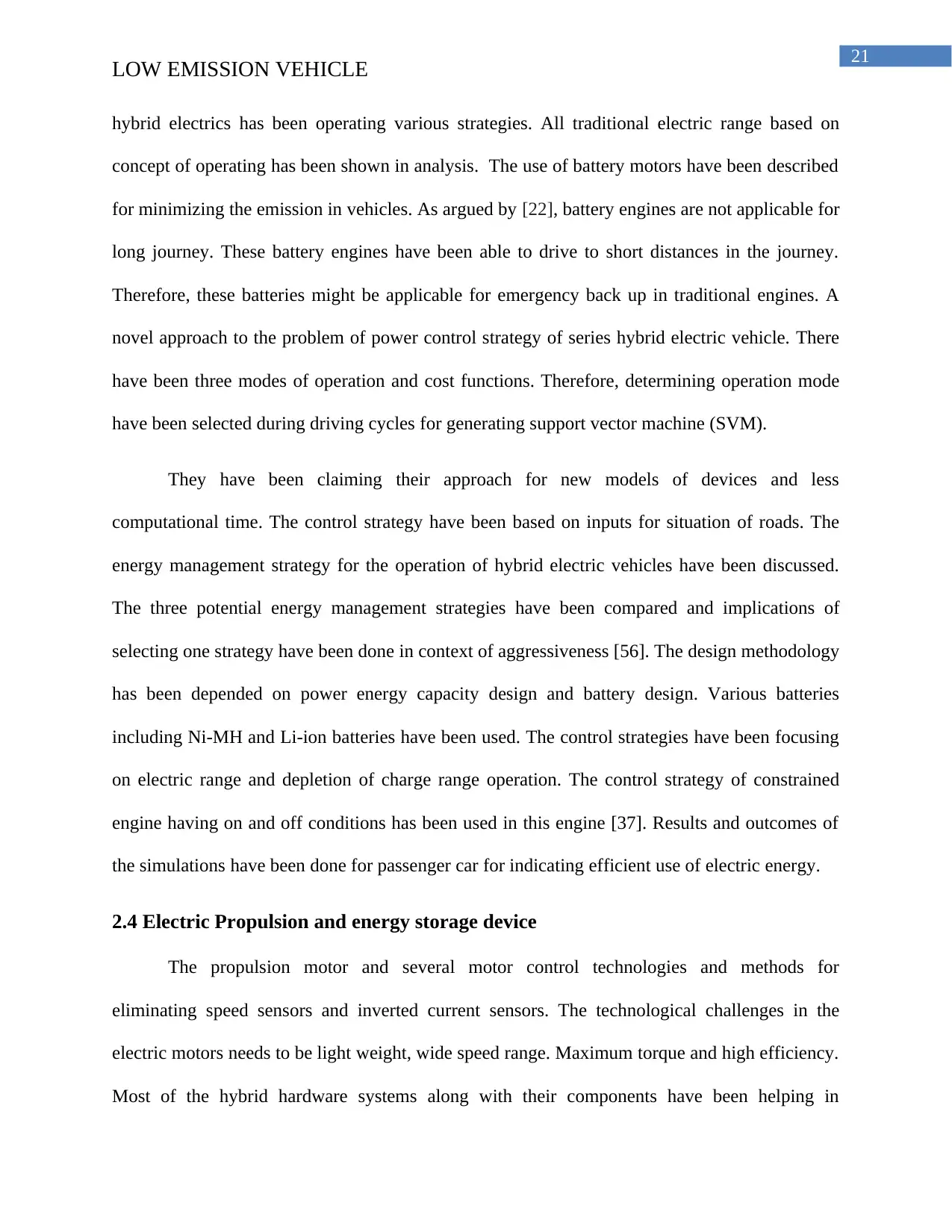
21
LOW EMISSION VEHICLE
hybrid electrics has been operating various strategies. All traditional electric range based on
concept of operating has been shown in analysis. The use of battery motors have been described
for minimizing the emission in vehicles. As argued by [22], battery engines are not applicable for
long journey. These battery engines have been able to drive to short distances in the journey.
Therefore, these batteries might be applicable for emergency back up in traditional engines. A
novel approach to the problem of power control strategy of series hybrid electric vehicle. There
have been three modes of operation and cost functions. Therefore, determining operation mode
have been selected during driving cycles for generating support vector machine (SVM).
They have been claiming their approach for new models of devices and less
computational time. The control strategy have been based on inputs for situation of roads. The
energy management strategy for the operation of hybrid electric vehicles have been discussed.
The three potential energy management strategies have been compared and implications of
selecting one strategy have been done in context of aggressiveness [56]. The design methodology
has been depended on power energy capacity design and battery design. Various batteries
including Ni-MH and Li-ion batteries have been used. The control strategies have been focusing
on electric range and depletion of charge range operation. The control strategy of constrained
engine having on and off conditions has been used in this engine [37]. Results and outcomes of
the simulations have been done for passenger car for indicating efficient use of electric energy.
2.4 Electric Propulsion and energy storage device
The propulsion motor and several motor control technologies and methods for
eliminating speed sensors and inverted current sensors. The technological challenges in the
electric motors needs to be light weight, wide speed range. Maximum torque and high efficiency.
Most of the hybrid hardware systems along with their components have been helping in
LOW EMISSION VEHICLE
hybrid electrics has been operating various strategies. All traditional electric range based on
concept of operating has been shown in analysis. The use of battery motors have been described
for minimizing the emission in vehicles. As argued by [22], battery engines are not applicable for
long journey. These battery engines have been able to drive to short distances in the journey.
Therefore, these batteries might be applicable for emergency back up in traditional engines. A
novel approach to the problem of power control strategy of series hybrid electric vehicle. There
have been three modes of operation and cost functions. Therefore, determining operation mode
have been selected during driving cycles for generating support vector machine (SVM).
They have been claiming their approach for new models of devices and less
computational time. The control strategy have been based on inputs for situation of roads. The
energy management strategy for the operation of hybrid electric vehicles have been discussed.
The three potential energy management strategies have been compared and implications of
selecting one strategy have been done in context of aggressiveness [56]. The design methodology
has been depended on power energy capacity design and battery design. Various batteries
including Ni-MH and Li-ion batteries have been used. The control strategies have been focusing
on electric range and depletion of charge range operation. The control strategy of constrained
engine having on and off conditions has been used in this engine [37]. Results and outcomes of
the simulations have been done for passenger car for indicating efficient use of electric energy.
2.4 Electric Propulsion and energy storage device
The propulsion motor and several motor control technologies and methods for
eliminating speed sensors and inverted current sensors. The technological challenges in the
electric motors needs to be light weight, wide speed range. Maximum torque and high efficiency.
Most of the hybrid hardware systems along with their components have been helping in
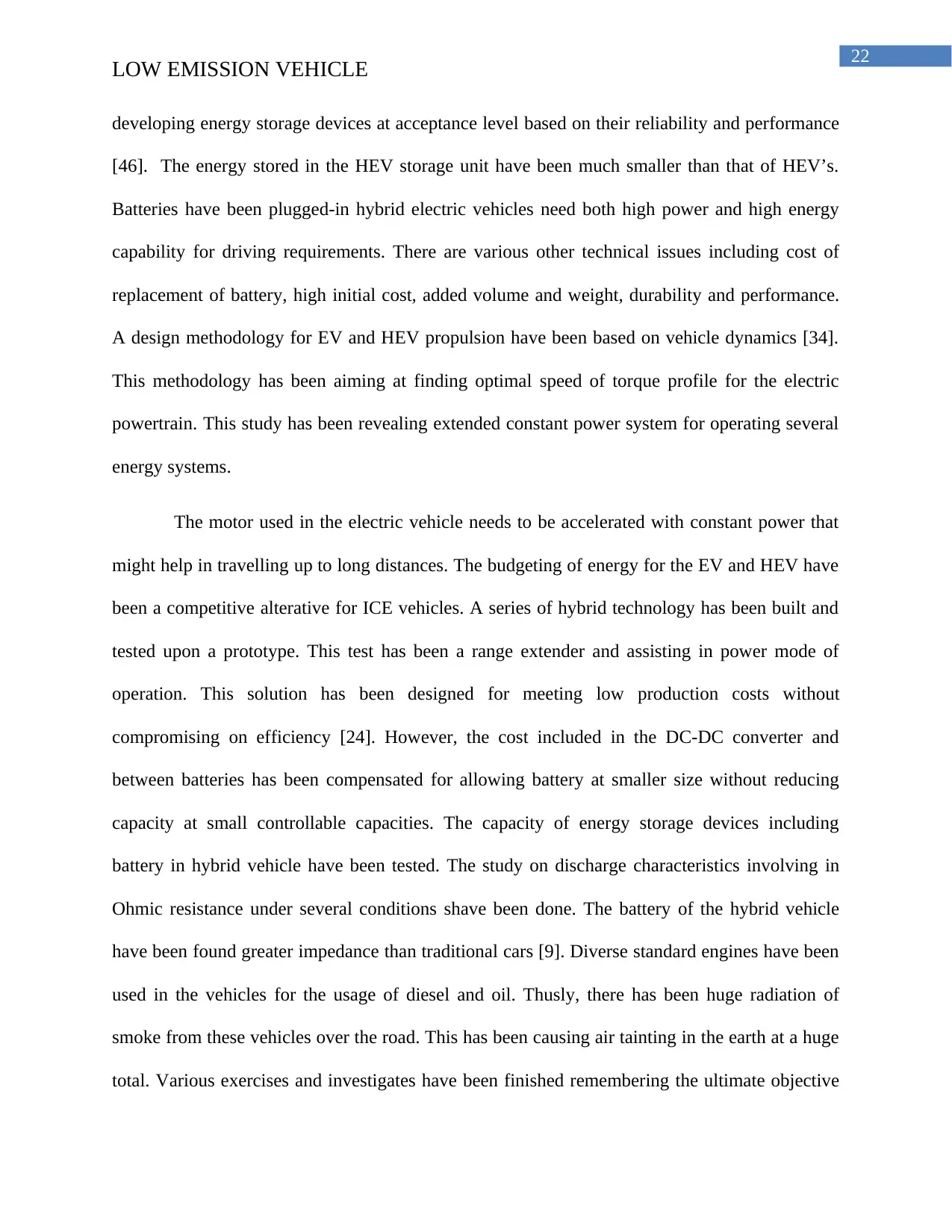
22
LOW EMISSION VEHICLE
developing energy storage devices at acceptance level based on their reliability and performance
[46]. The energy stored in the HEV storage unit have been much smaller than that of HEV’s.
Batteries have been plugged-in hybrid electric vehicles need both high power and high energy
capability for driving requirements. There are various other technical issues including cost of
replacement of battery, high initial cost, added volume and weight, durability and performance.
A design methodology for EV and HEV propulsion have been based on vehicle dynamics [34].
This methodology has been aiming at finding optimal speed of torque profile for the electric
powertrain. This study has been revealing extended constant power system for operating several
energy systems.
The motor used in the electric vehicle needs to be accelerated with constant power that
might help in travelling up to long distances. The budgeting of energy for the EV and HEV have
been a competitive alterative for ICE vehicles. A series of hybrid technology has been built and
tested upon a prototype. This test has been a range extender and assisting in power mode of
operation. This solution has been designed for meeting low production costs without
compromising on efficiency [24]. However, the cost included in the DC-DC converter and
between batteries has been compensated for allowing battery at smaller size without reducing
capacity at small controllable capacities. The capacity of energy storage devices including
battery in hybrid vehicle have been tested. The study on discharge characteristics involving in
Ohmic resistance under several conditions shave been done. The battery of the hybrid vehicle
have been found greater impedance than traditional cars [9]. Diverse standard engines have been
used in the vehicles for the usage of diesel and oil. Thusly, there has been huge radiation of
smoke from these vehicles over the road. This has been causing air tainting in the earth at a huge
total. Various exercises and investigates have been finished remembering the ultimate objective
LOW EMISSION VEHICLE
developing energy storage devices at acceptance level based on their reliability and performance
[46]. The energy stored in the HEV storage unit have been much smaller than that of HEV’s.
Batteries have been plugged-in hybrid electric vehicles need both high power and high energy
capability for driving requirements. There are various other technical issues including cost of
replacement of battery, high initial cost, added volume and weight, durability and performance.
A design methodology for EV and HEV propulsion have been based on vehicle dynamics [34].
This methodology has been aiming at finding optimal speed of torque profile for the electric
powertrain. This study has been revealing extended constant power system for operating several
energy systems.
The motor used in the electric vehicle needs to be accelerated with constant power that
might help in travelling up to long distances. The budgeting of energy for the EV and HEV have
been a competitive alterative for ICE vehicles. A series of hybrid technology has been built and
tested upon a prototype. This test has been a range extender and assisting in power mode of
operation. This solution has been designed for meeting low production costs without
compromising on efficiency [24]. However, the cost included in the DC-DC converter and
between batteries has been compensated for allowing battery at smaller size without reducing
capacity at small controllable capacities. The capacity of energy storage devices including
battery in hybrid vehicle have been tested. The study on discharge characteristics involving in
Ohmic resistance under several conditions shave been done. The battery of the hybrid vehicle
have been found greater impedance than traditional cars [9]. Diverse standard engines have been
used in the vehicles for the usage of diesel and oil. Thusly, there has been huge radiation of
smoke from these vehicles over the road. This has been causing air tainting in the earth at a huge
total. Various exercises and investigates have been finished remembering the ultimate objective
Secure Best Marks with AI Grader
Need help grading? Try our AI Grader for instant feedback on your assignments.

23
LOW EMISSION VEHICLE
to confine outpourings discernible all around and decreasing air defilement in the atmosphere. In
any case, study of low release vehicle thought have been gotten from these asks about. Various
researchers have been working in this wander for making a low transmission vehicle to restrain
release of pernicious smoke from vehicles [18]. The framework taken after by them may
assemble nature of urban air. In any case, additional study has been begun related to low release
vehicle thought for ensuring the urban air quality. There have been an essential risk to the air on
account of the air defilement. Diverse collaborating working vehicles have been executed into
physical and compound engine components for participating for influencing vehicles radiations
remembering the true objective to reduce outpouring of air pollutions in the atmosphere. The
carbon surge discernible the sum total of what around has been having damaging effects in the
atmosphere and for people.
The urban air quality has a prime stress for condition. Inside 10 years, there has been
huge ponderousness in the extent of gases in the earth. Dissolving of pernicious and noxious
gases noticeable all around has been having dangerous effects for individuals on the planet [29].
A substantial bit of the air harms have been delivered from transport vehicles over boulevards.
Diverse predicted proportion of gases including carbon dioxide, Nitrogen Oxides and Sulfur
oxides have been causing dangerous effects over customary condition. It has been anticipated
that the proportion of these air poisons will get increase in multi Low emission vehicle from
now. Thusly, this is aggravating for the atmosphere.
The driving examples of the vehicles have been investigated legitimately to make
changes in the traditional structure of the auto. Power has been decided for an elective fuel in the
market. Electric cars have been intended for short separations with the goal that it can go in a
solitary charge. In any case, [13] contended that, the battery stories quite a while to get revived
LOW EMISSION VEHICLE
to confine outpourings discernible all around and decreasing air defilement in the atmosphere. In
any case, study of low release vehicle thought have been gotten from these asks about. Various
researchers have been working in this wander for making a low transmission vehicle to restrain
release of pernicious smoke from vehicles [18]. The framework taken after by them may
assemble nature of urban air. In any case, additional study has been begun related to low release
vehicle thought for ensuring the urban air quality. There have been an essential risk to the air on
account of the air defilement. Diverse collaborating working vehicles have been executed into
physical and compound engine components for participating for influencing vehicles radiations
remembering the true objective to reduce outpouring of air pollutions in the atmosphere. The
carbon surge discernible the sum total of what around has been having damaging effects in the
atmosphere and for people.
The urban air quality has a prime stress for condition. Inside 10 years, there has been
huge ponderousness in the extent of gases in the earth. Dissolving of pernicious and noxious
gases noticeable all around has been having dangerous effects for individuals on the planet [29].
A substantial bit of the air harms have been delivered from transport vehicles over boulevards.
Diverse predicted proportion of gases including carbon dioxide, Nitrogen Oxides and Sulfur
oxides have been causing dangerous effects over customary condition. It has been anticipated
that the proportion of these air poisons will get increase in multi Low emission vehicle from
now. Thusly, this is aggravating for the atmosphere.
The driving examples of the vehicles have been investigated legitimately to make
changes in the traditional structure of the auto. Power has been decided for an elective fuel in the
market. Electric cars have been intended for short separations with the goal that it can go in a
solitary charge. In any case, [13] contended that, the battery stories quite a while to get revived

24
LOW EMISSION VEHICLE
once more. This has been significant test for the car researchers to understand in electric cars.
Electric cars have been another innovation in the car business. Consequently, drivers are required
to familiarize with the element of electric cars including vehicle charging and battery observing.
The unpredictability of electric cars have been disheartening numerous clients from buying it
from merchants. However, the accessibility of electric cars have been low in the market. Barely
any organizations are working in this venture as there is no certification of getting
accomplishment in this field. The traditional cars have been underwrite the entire vehicle
advertise and winding up hard to roll out an improvement in the market [45]. There have been
different investigations done in the testing of electric vehicles. The cost of electric cars have been
high to the point that the majority of the clients are not be to buy. Specialized advances in ICE
innovations have helped in rolling out improvements in the vehicles and different fields. The
utilization of electric cars have been not noticeable in the market. With the upgrade of the ICT
advancements, long separation cars have been worked in the market. Different variables have
been influencing the creation of the electric cars in the market. The enhanced innovation in the
framework of the vehicles have been a factor for the extemporizing the market.
There have been different advantages of the electric cars in the market. The electric cars
are without contamination in condition. Hence, there is a shot of supportable improvement in
nature. Smoke outflows have been greatest if there should be an occurrence of cars and other
huge vehicles. Power as a fuel does not create any sort of smoke shape cars and different
vehicles [57]. Thusly, the enthusiasm on electric vehicles have been expanded as of late.
Different researchers have been chipping away at the improvement of electric vehicles on the
planet. The difficulties in the regular cars and vehicles have been making red caution for nature.
The overabundance utilization of oil and oil based commodities have been lessening common
LOW EMISSION VEHICLE
once more. This has been significant test for the car researchers to understand in electric cars.
Electric cars have been another innovation in the car business. Consequently, drivers are required
to familiarize with the element of electric cars including vehicle charging and battery observing.
The unpredictability of electric cars have been disheartening numerous clients from buying it
from merchants. However, the accessibility of electric cars have been low in the market. Barely
any organizations are working in this venture as there is no certification of getting
accomplishment in this field. The traditional cars have been underwrite the entire vehicle
advertise and winding up hard to roll out an improvement in the market [45]. There have been
different investigations done in the testing of electric vehicles. The cost of electric cars have been
high to the point that the majority of the clients are not be to buy. Specialized advances in ICE
innovations have helped in rolling out improvements in the vehicles and different fields. The
utilization of electric cars have been not noticeable in the market. With the upgrade of the ICT
advancements, long separation cars have been worked in the market. Different variables have
been influencing the creation of the electric cars in the market. The enhanced innovation in the
framework of the vehicles have been a factor for the extemporizing the market.
There have been different advantages of the electric cars in the market. The electric cars
are without contamination in condition. Hence, there is a shot of supportable improvement in
nature. Smoke outflows have been greatest if there should be an occurrence of cars and other
huge vehicles. Power as a fuel does not create any sort of smoke shape cars and different
vehicles [57]. Thusly, the enthusiasm on electric vehicles have been expanded as of late.
Different researchers have been chipping away at the improvement of electric vehicles on the
planet. The difficulties in the regular cars and vehicles have been making red caution for nature.
The overabundance utilization of oil and oil based commodities have been lessening common

25
LOW EMISSION VEHICLE
assets shape Earth's outside layer. Different nations including US, Japan, Korea have been
working in this task for creating electric cars and vehicles [59]. There have been a few
improvement in the activities in various fields. The battery-powered battery has been a
noteworthy test for improvement of electric vehicles. Time taken for charging a battery has been
taking extended periods for finishing. Along these lines, this has been an irritating point for the
clients.
The CO2 emanation from customary vehicles have been making nursery impact and an
Earth-wide temperature boost over the world. Hence, a predominant CO2 emanation
bookkeeping system is to consider most pessimistic scenario power creation for a module
electric vehicle and to contrast that with tail-pipe discharges of a traditional vehicle [43]. In spite
of the fact that this technique does not give an exact correlation, it is as yet well known. The
power supply for reviving battery has been an issue for researcher. Sustainable power sources
have been basic for age of power. Hence, the researcher need to search for other source that may
help in performing same as inexhaustible assets. Power has been an essential part and may go
about as a fuel for driving vehicles. Electric cars can have two measurements including gadget
that has been utilized for given capacity to the electric engine and electric vehicles into the auto
depends in electric engine for drive [65]. There are two gadget that can utilize the intensity of
engine including battery-powered battery and hydrogen energy components.
PEVs have been a basic component in keeping up a sharp way to deal with the
improvement of the electric cars. The utilization of power has been helping in giving inward
burning motor to utilizing a few electric impetus frameworks as signified as expanded range
electric vehicles. The extent of the term PHEV has been keeping up a broadened extend electric
vehicles [66]. The utilization of business electric cars in the market has been keeping up the
LOW EMISSION VEHICLE
assets shape Earth's outside layer. Different nations including US, Japan, Korea have been
working in this task for creating electric cars and vehicles [59]. There have been a few
improvement in the activities in various fields. The battery-powered battery has been a
noteworthy test for improvement of electric vehicles. Time taken for charging a battery has been
taking extended periods for finishing. Along these lines, this has been an irritating point for the
clients.
The CO2 emanation from customary vehicles have been making nursery impact and an
Earth-wide temperature boost over the world. Hence, a predominant CO2 emanation
bookkeeping system is to consider most pessimistic scenario power creation for a module
electric vehicle and to contrast that with tail-pipe discharges of a traditional vehicle [43]. In spite
of the fact that this technique does not give an exact correlation, it is as yet well known. The
power supply for reviving battery has been an issue for researcher. Sustainable power sources
have been basic for age of power. Hence, the researcher need to search for other source that may
help in performing same as inexhaustible assets. Power has been an essential part and may go
about as a fuel for driving vehicles. Electric cars can have two measurements including gadget
that has been utilized for given capacity to the electric engine and electric vehicles into the auto
depends in electric engine for drive [65]. There are two gadget that can utilize the intensity of
engine including battery-powered battery and hydrogen energy components.
PEVs have been a basic component in keeping up a sharp way to deal with the
improvement of the electric cars. The utilization of power has been helping in giving inward
burning motor to utilizing a few electric impetus frameworks as signified as expanded range
electric vehicles. The extent of the term PHEV has been keeping up a broadened extend electric
vehicles [66]. The utilization of business electric cars in the market has been keeping up the
Paraphrase This Document
Need a fresh take? Get an instant paraphrase of this document with our AI Paraphraser
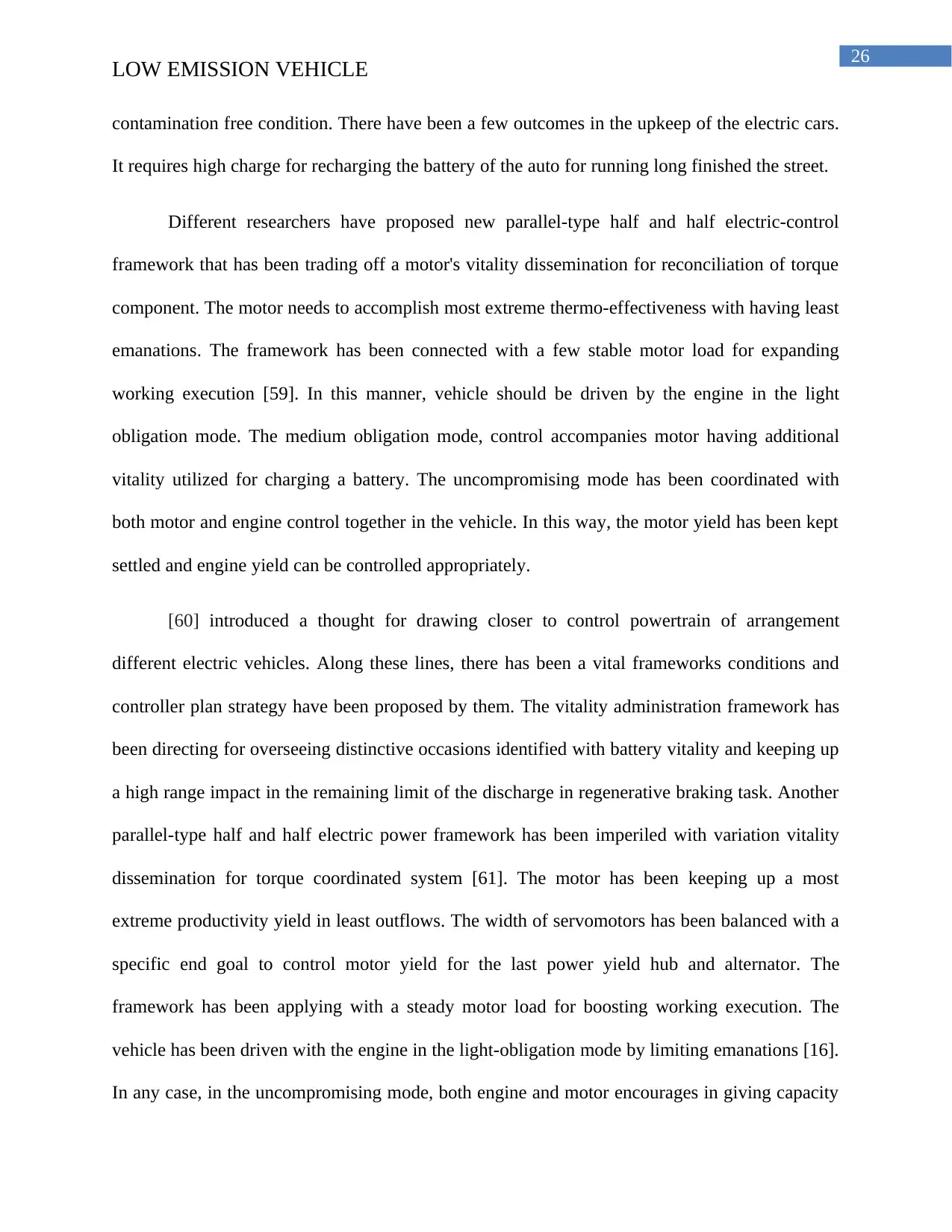
26
LOW EMISSION VEHICLE
contamination free condition. There have been a few outcomes in the upkeep of the electric cars.
It requires high charge for recharging the battery of the auto for running long finished the street.
Different researchers have proposed new parallel-type half and half electric-control
framework that has been trading off a motor's vitality dissemination for reconciliation of torque
component. The motor needs to accomplish most extreme thermo-effectiveness with having least
emanations. The framework has been connected with a few stable motor load for expanding
working execution [59]. In this manner, vehicle should be driven by the engine in the light
obligation mode. The medium obligation mode, control accompanies motor having additional
vitality utilized for charging a battery. The uncompromising mode has been coordinated with
both motor and engine control together in the vehicle. In this way, the motor yield has been kept
settled and engine yield can be controlled appropriately.
[60] introduced a thought for drawing closer to control powertrain of arrangement
different electric vehicles. Along these lines, there has been a vital frameworks conditions and
controller plan strategy have been proposed by them. The vitality administration framework has
been directing for overseeing distinctive occasions identified with battery vitality and keeping up
a high range impact in the remaining limit of the discharge in regenerative braking task. Another
parallel-type half and half electric power framework has been imperiled with variation vitality
dissemination for torque coordinated system [61]. The motor has been keeping up a most
extreme productivity yield in least outflows. The width of servomotors has been balanced with a
specific end goal to control motor yield for the last power yield hub and alternator. The
framework has been applying with a steady motor load for boosting working execution. The
vehicle has been driven with the engine in the light-obligation mode by limiting emanations [16].
In any case, in the uncompromising mode, both engine and motor encourages in giving capacity
LOW EMISSION VEHICLE
contamination free condition. There have been a few outcomes in the upkeep of the electric cars.
It requires high charge for recharging the battery of the auto for running long finished the street.
Different researchers have proposed new parallel-type half and half electric-control
framework that has been trading off a motor's vitality dissemination for reconciliation of torque
component. The motor needs to accomplish most extreme thermo-effectiveness with having least
emanations. The framework has been connected with a few stable motor load for expanding
working execution [59]. In this manner, vehicle should be driven by the engine in the light
obligation mode. The medium obligation mode, control accompanies motor having additional
vitality utilized for charging a battery. The uncompromising mode has been coordinated with
both motor and engine control together in the vehicle. In this way, the motor yield has been kept
settled and engine yield can be controlled appropriately.
[60] introduced a thought for drawing closer to control powertrain of arrangement
different electric vehicles. Along these lines, there has been a vital frameworks conditions and
controller plan strategy have been proposed by them. The vitality administration framework has
been directing for overseeing distinctive occasions identified with battery vitality and keeping up
a high range impact in the remaining limit of the discharge in regenerative braking task. Another
parallel-type half and half electric power framework has been imperiled with variation vitality
dissemination for torque coordinated system [61]. The motor has been keeping up a most
extreme productivity yield in least outflows. The width of servomotors has been balanced with a
specific end goal to control motor yield for the last power yield hub and alternator. The
framework has been applying with a steady motor load for boosting working execution. The
vehicle has been driven with the engine in the light-obligation mode by limiting emanations [16].
In any case, in the uncompromising mode, both engine and motor encourages in giving capacity
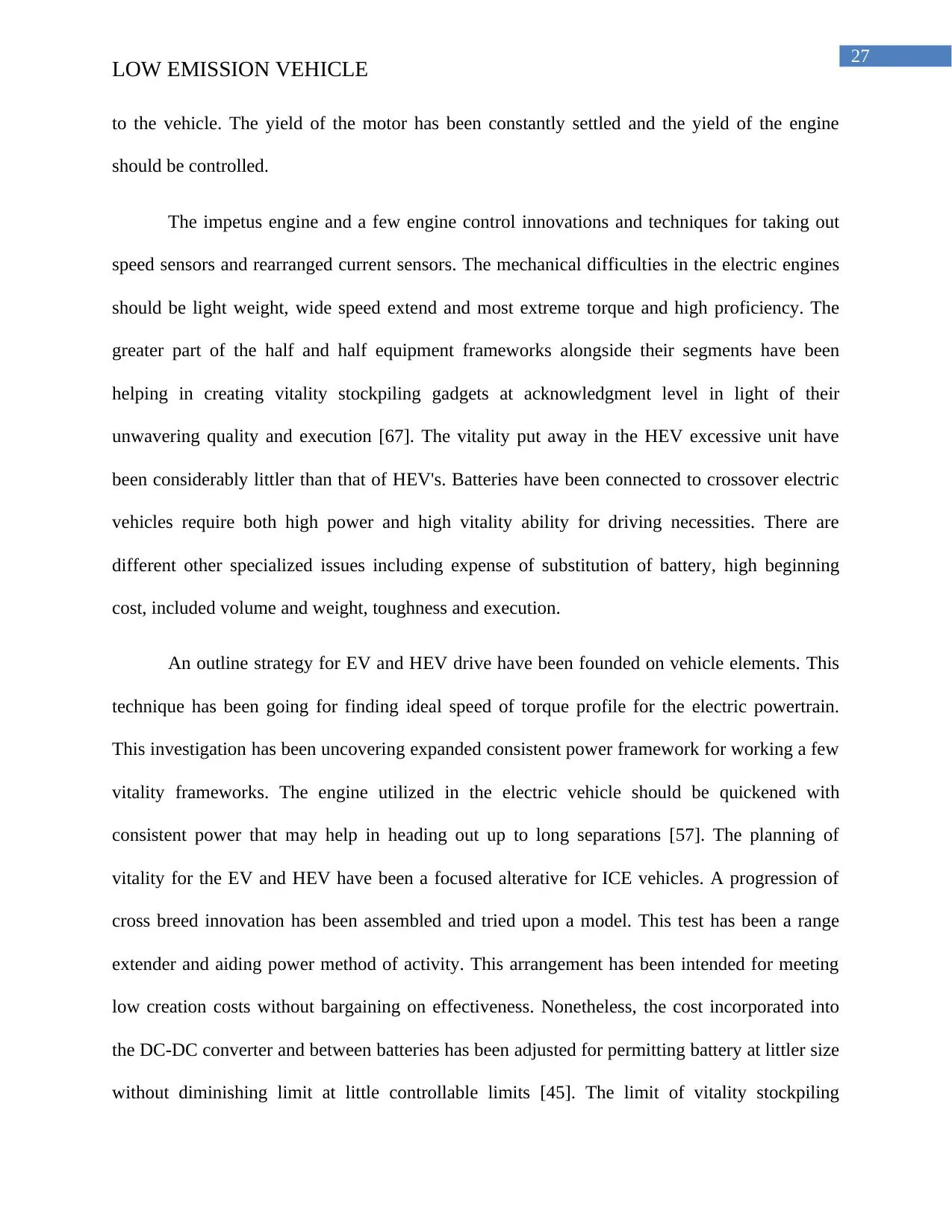
27
LOW EMISSION VEHICLE
to the vehicle. The yield of the motor has been constantly settled and the yield of the engine
should be controlled.
The impetus engine and a few engine control innovations and techniques for taking out
speed sensors and rearranged current sensors. The mechanical difficulties in the electric engines
should be light weight, wide speed extend and most extreme torque and high proficiency. The
greater part of the half and half equipment frameworks alongside their segments have been
helping in creating vitality stockpiling gadgets at acknowledgment level in light of their
unwavering quality and execution [67]. The vitality put away in the HEV excessive unit have
been considerably littler than that of HEV's. Batteries have been connected to crossover electric
vehicles require both high power and high vitality ability for driving necessities. There are
different other specialized issues including expense of substitution of battery, high beginning
cost, included volume and weight, toughness and execution.
An outline strategy for EV and HEV drive have been founded on vehicle elements. This
technique has been going for finding ideal speed of torque profile for the electric powertrain.
This investigation has been uncovering expanded consistent power framework for working a few
vitality frameworks. The engine utilized in the electric vehicle should be quickened with
consistent power that may help in heading out up to long separations [57]. The planning of
vitality for the EV and HEV have been a focused alterative for ICE vehicles. A progression of
cross breed innovation has been assembled and tried upon a model. This test has been a range
extender and aiding power method of activity. This arrangement has been intended for meeting
low creation costs without bargaining on effectiveness. Nonetheless, the cost incorporated into
the DC-DC converter and between batteries has been adjusted for permitting battery at littler size
without diminishing limit at little controllable limits [45]. The limit of vitality stockpiling
LOW EMISSION VEHICLE
to the vehicle. The yield of the motor has been constantly settled and the yield of the engine
should be controlled.
The impetus engine and a few engine control innovations and techniques for taking out
speed sensors and rearranged current sensors. The mechanical difficulties in the electric engines
should be light weight, wide speed extend and most extreme torque and high proficiency. The
greater part of the half and half equipment frameworks alongside their segments have been
helping in creating vitality stockpiling gadgets at acknowledgment level in light of their
unwavering quality and execution [67]. The vitality put away in the HEV excessive unit have
been considerably littler than that of HEV's. Batteries have been connected to crossover electric
vehicles require both high power and high vitality ability for driving necessities. There are
different other specialized issues including expense of substitution of battery, high beginning
cost, included volume and weight, toughness and execution.
An outline strategy for EV and HEV drive have been founded on vehicle elements. This
technique has been going for finding ideal speed of torque profile for the electric powertrain.
This investigation has been uncovering expanded consistent power framework for working a few
vitality frameworks. The engine utilized in the electric vehicle should be quickened with
consistent power that may help in heading out up to long separations [57]. The planning of
vitality for the EV and HEV have been a focused alterative for ICE vehicles. A progression of
cross breed innovation has been assembled and tried upon a model. This test has been a range
extender and aiding power method of activity. This arrangement has been intended for meeting
low creation costs without bargaining on effectiveness. Nonetheless, the cost incorporated into
the DC-DC converter and between batteries has been adjusted for permitting battery at littler size
without diminishing limit at little controllable limits [45]. The limit of vitality stockpiling
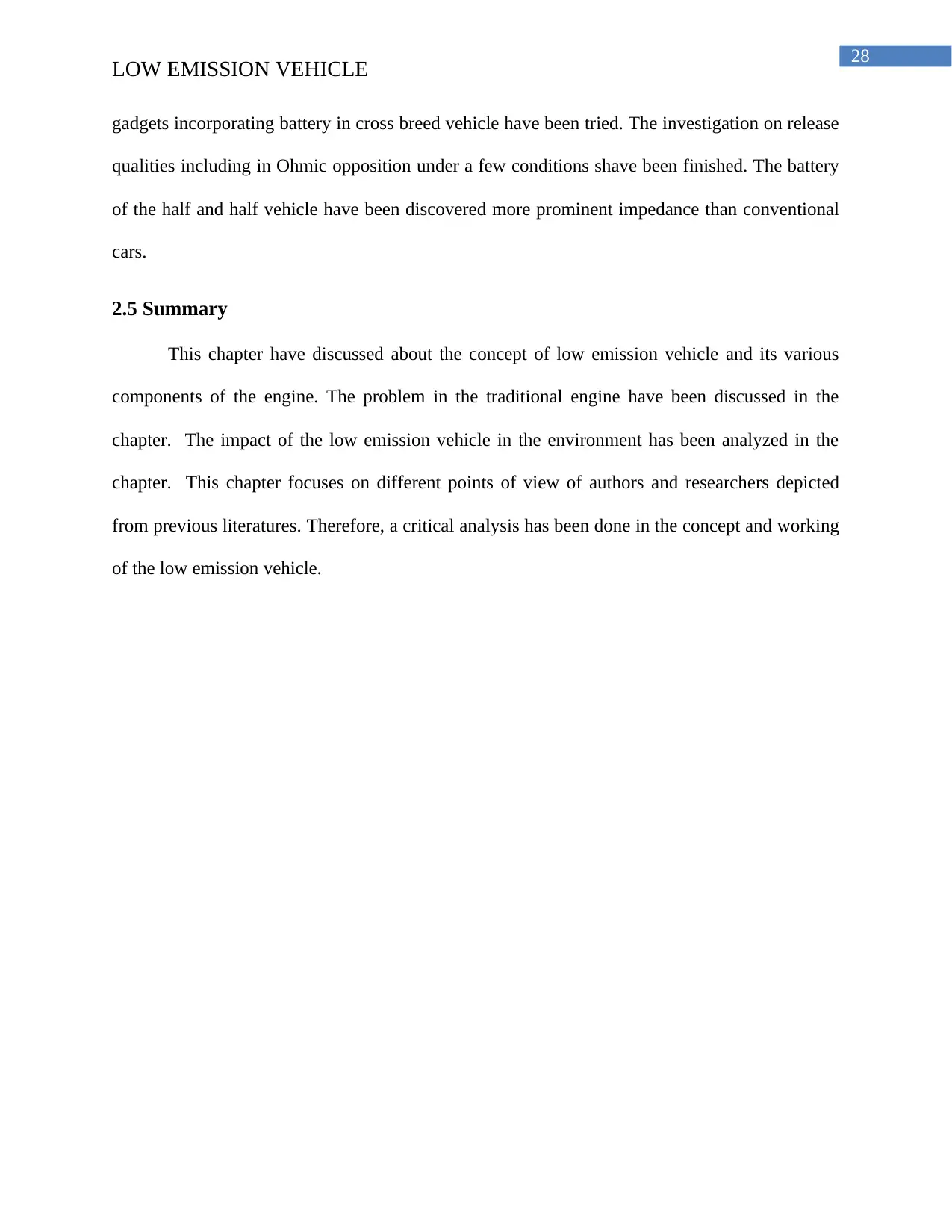
28
LOW EMISSION VEHICLE
gadgets incorporating battery in cross breed vehicle have been tried. The investigation on release
qualities including in Ohmic opposition under a few conditions shave been finished. The battery
of the half and half vehicle have been discovered more prominent impedance than conventional
cars.
2.5 Summary
This chapter have discussed about the concept of low emission vehicle and its various
components of the engine. The problem in the traditional engine have been discussed in the
chapter. The impact of the low emission vehicle in the environment has been analyzed in the
chapter. This chapter focuses on different points of view of authors and researchers depicted
from previous literatures. Therefore, a critical analysis has been done in the concept and working
of the low emission vehicle.
LOW EMISSION VEHICLE
gadgets incorporating battery in cross breed vehicle have been tried. The investigation on release
qualities including in Ohmic opposition under a few conditions shave been finished. The battery
of the half and half vehicle have been discovered more prominent impedance than conventional
cars.
2.5 Summary
This chapter have discussed about the concept of low emission vehicle and its various
components of the engine. The problem in the traditional engine have been discussed in the
chapter. The impact of the low emission vehicle in the environment has been analyzed in the
chapter. This chapter focuses on different points of view of authors and researchers depicted
from previous literatures. Therefore, a critical analysis has been done in the concept and working
of the low emission vehicle.
Secure Best Marks with AI Grader
Need help grading? Try our AI Grader for instant feedback on your assignments.
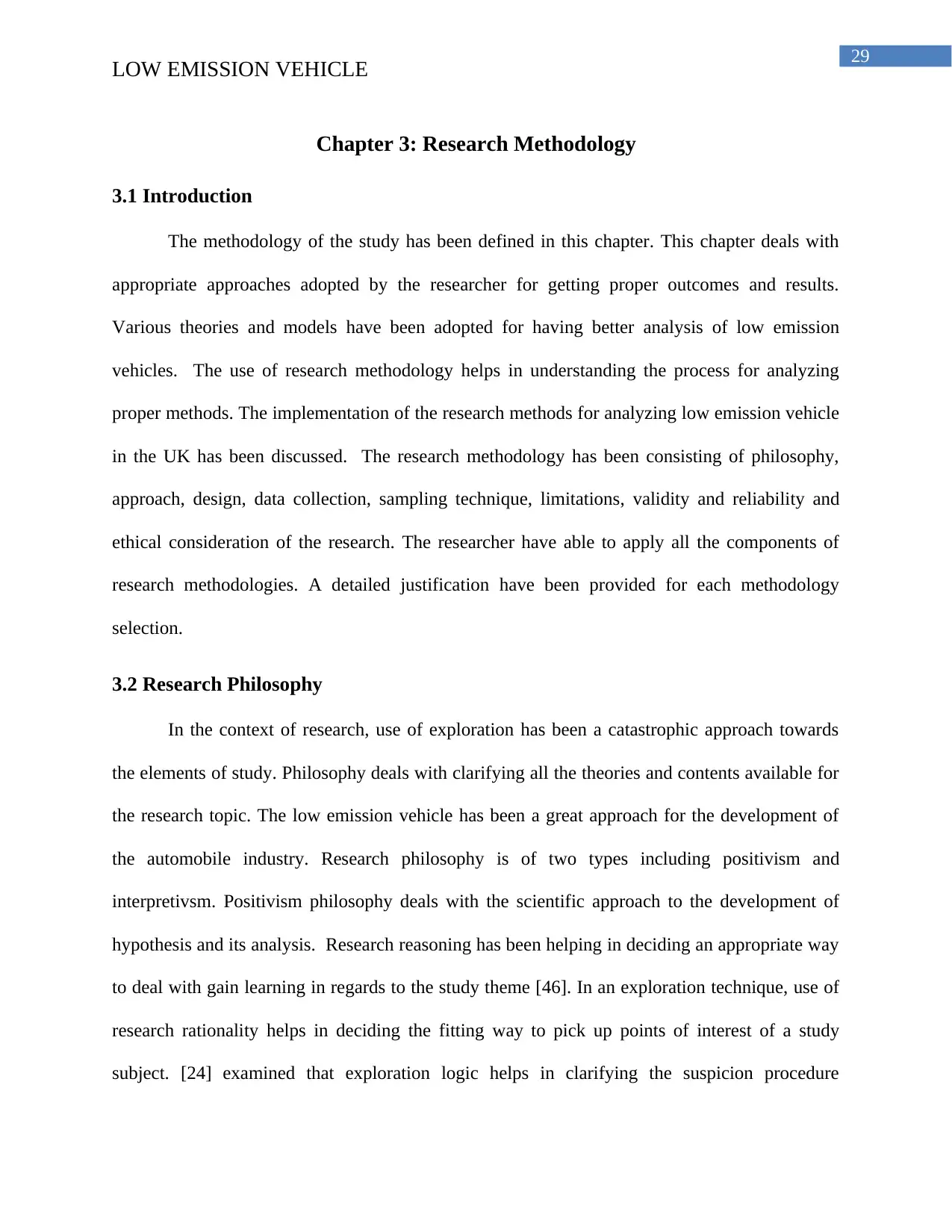
29
LOW EMISSION VEHICLE
Chapter 3: Research Methodology
3.1 Introduction
The methodology of the study has been defined in this chapter. This chapter deals with
appropriate approaches adopted by the researcher for getting proper outcomes and results.
Various theories and models have been adopted for having better analysis of low emission
vehicles. The use of research methodology helps in understanding the process for analyzing
proper methods. The implementation of the research methods for analyzing low emission vehicle
in the UK has been discussed. The research methodology has been consisting of philosophy,
approach, design, data collection, sampling technique, limitations, validity and reliability and
ethical consideration of the research. The researcher have able to apply all the components of
research methodologies. A detailed justification have been provided for each methodology
selection.
3.2 Research Philosophy
In the context of research, use of exploration has been a catastrophic approach towards
the elements of study. Philosophy deals with clarifying all the theories and contents available for
the research topic. The low emission vehicle has been a great approach for the development of
the automobile industry. Research philosophy is of two types including positivism and
interpretivsm. Positivism philosophy deals with the scientific approach to the development of
hypothesis and its analysis. Research reasoning has been helping in deciding an appropriate way
to deal with gain learning in regards to the study theme [46]. In an exploration technique, use of
research rationality helps in deciding the fitting way to pick up points of interest of a study
subject. [24] examined that exploration logic helps in clarifying the suspicion procedure
LOW EMISSION VEHICLE
Chapter 3: Research Methodology
3.1 Introduction
The methodology of the study has been defined in this chapter. This chapter deals with
appropriate approaches adopted by the researcher for getting proper outcomes and results.
Various theories and models have been adopted for having better analysis of low emission
vehicles. The use of research methodology helps in understanding the process for analyzing
proper methods. The implementation of the research methods for analyzing low emission vehicle
in the UK has been discussed. The research methodology has been consisting of philosophy,
approach, design, data collection, sampling technique, limitations, validity and reliability and
ethical consideration of the research. The researcher have able to apply all the components of
research methodologies. A detailed justification have been provided for each methodology
selection.
3.2 Research Philosophy
In the context of research, use of exploration has been a catastrophic approach towards
the elements of study. Philosophy deals with clarifying all the theories and contents available for
the research topic. The low emission vehicle has been a great approach for the development of
the automobile industry. Research philosophy is of two types including positivism and
interpretivsm. Positivism philosophy deals with the scientific approach to the development of
hypothesis and its analysis. Research reasoning has been helping in deciding an appropriate way
to deal with gain learning in regards to the study theme [46]. In an exploration technique, use of
research rationality helps in deciding the fitting way to pick up points of interest of a study
subject. [24] examined that exploration logic helps in clarifying the suspicion procedure
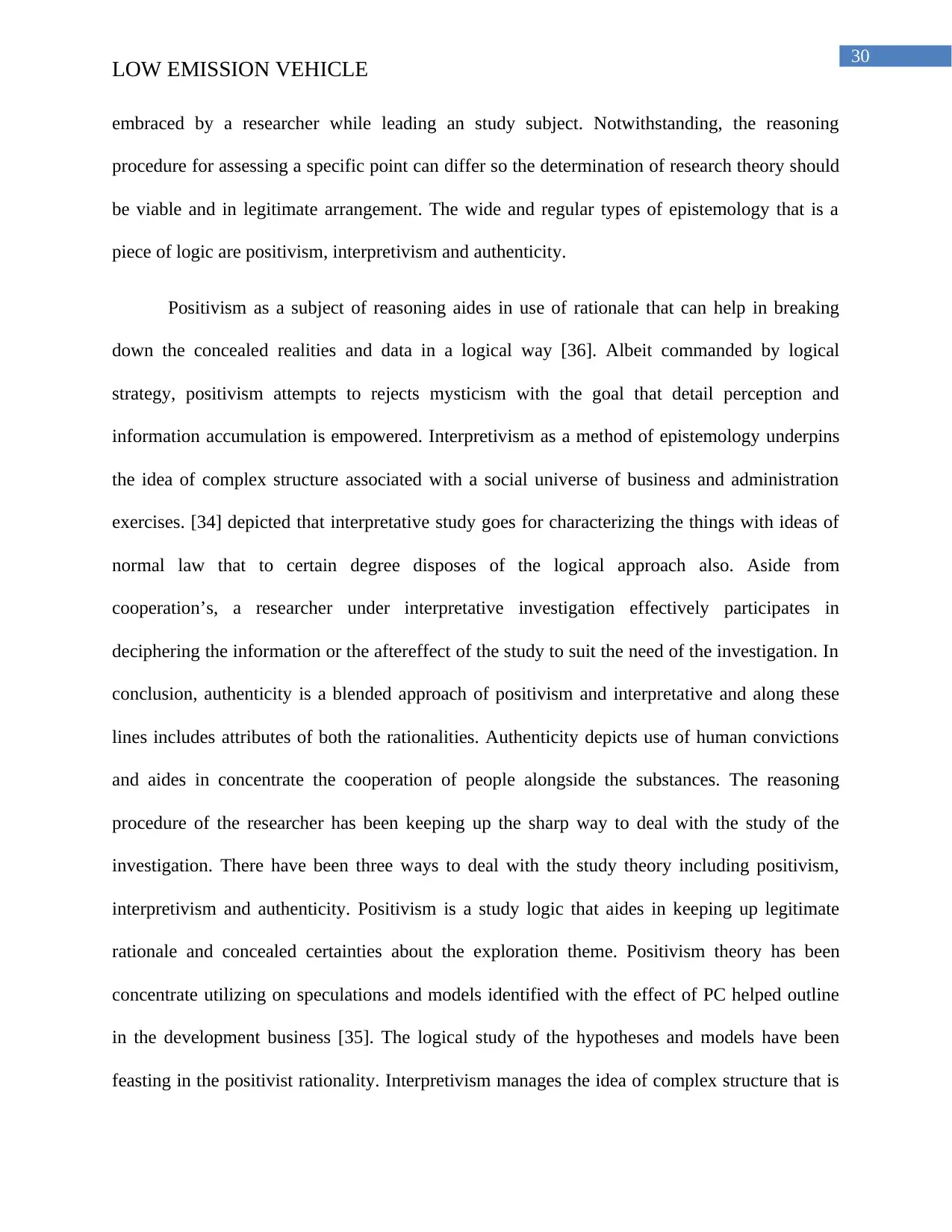
30
LOW EMISSION VEHICLE
embraced by a researcher while leading an study subject. Notwithstanding, the reasoning
procedure for assessing a specific point can differ so the determination of research theory should
be viable and in legitimate arrangement. The wide and regular types of epistemology that is a
piece of logic are positivism, interpretivism and authenticity.
Positivism as a subject of reasoning aides in use of rationale that can help in breaking
down the concealed realities and data in a logical way [36]. Albeit commanded by logical
strategy, positivism attempts to rejects mysticism with the goal that detail perception and
information accumulation is empowered. Interpretivism as a method of epistemology underpins
the idea of complex structure associated with a social universe of business and administration
exercises. [34] depicted that interpretative study goes for characterizing the things with ideas of
normal law that to certain degree disposes of the logical approach also. Aside from
cooperation’s, a researcher under interpretative investigation effectively participates in
deciphering the information or the aftereffect of the study to suit the need of the investigation. In
conclusion, authenticity is a blended approach of positivism and interpretative and along these
lines includes attributes of both the rationalities. Authenticity depicts use of human convictions
and aides in concentrate the cooperation of people alongside the substances. The reasoning
procedure of the researcher has been keeping up the sharp way to deal with the study of the
investigation. There have been three ways to deal with the study theory including positivism,
interpretivism and authenticity. Positivism is a study logic that aides in keeping up legitimate
rationale and concealed certainties about the exploration theme. Positivism theory has been
concentrate utilizing on speculations and models identified with the effect of PC helped outline
in the development business [35]. The logical study of the hypotheses and models have been
feasting in the positivist rationality. Interpretivism manages the idea of complex structure that is
LOW EMISSION VEHICLE
embraced by a researcher while leading an study subject. Notwithstanding, the reasoning
procedure for assessing a specific point can differ so the determination of research theory should
be viable and in legitimate arrangement. The wide and regular types of epistemology that is a
piece of logic are positivism, interpretivism and authenticity.
Positivism as a subject of reasoning aides in use of rationale that can help in breaking
down the concealed realities and data in a logical way [36]. Albeit commanded by logical
strategy, positivism attempts to rejects mysticism with the goal that detail perception and
information accumulation is empowered. Interpretivism as a method of epistemology underpins
the idea of complex structure associated with a social universe of business and administration
exercises. [34] depicted that interpretative study goes for characterizing the things with ideas of
normal law that to certain degree disposes of the logical approach also. Aside from
cooperation’s, a researcher under interpretative investigation effectively participates in
deciphering the information or the aftereffect of the study to suit the need of the investigation. In
conclusion, authenticity is a blended approach of positivism and interpretative and along these
lines includes attributes of both the rationalities. Authenticity depicts use of human convictions
and aides in concentrate the cooperation of people alongside the substances. The reasoning
procedure of the researcher has been keeping up the sharp way to deal with the study of the
investigation. There have been three ways to deal with the study theory including positivism,
interpretivism and authenticity. Positivism is a study logic that aides in keeping up legitimate
rationale and concealed certainties about the exploration theme. Positivism theory has been
concentrate utilizing on speculations and models identified with the effect of PC helped outline
in the development business [35]. The logical study of the hypotheses and models have been
feasting in the positivist rationality. Interpretivism manages the idea of complex structure that is
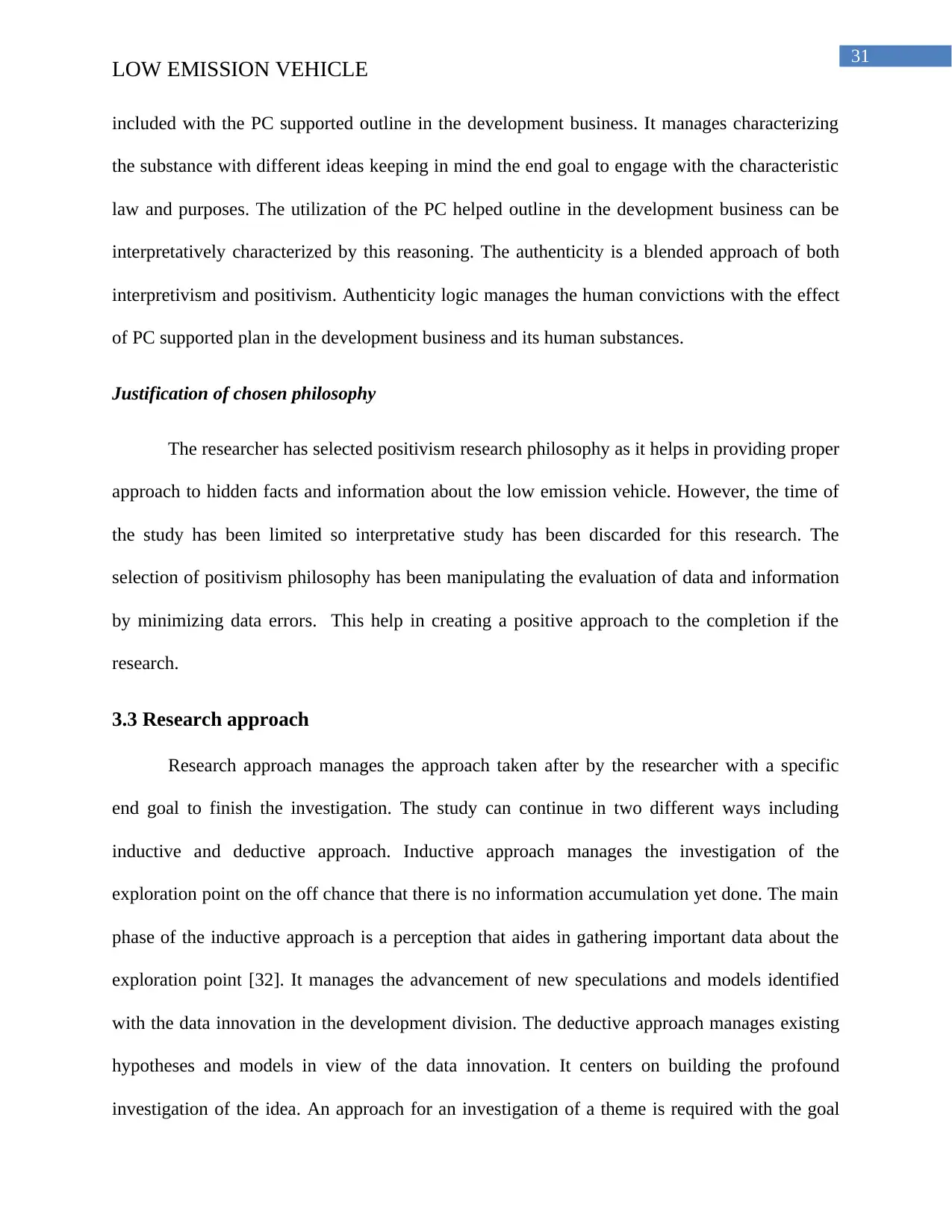
31
LOW EMISSION VEHICLE
included with the PC supported outline in the development business. It manages characterizing
the substance with different ideas keeping in mind the end goal to engage with the characteristic
law and purposes. The utilization of the PC helped outline in the development business can be
interpretatively characterized by this reasoning. The authenticity is a blended approach of both
interpretivism and positivism. Authenticity logic manages the human convictions with the effect
of PC supported plan in the development business and its human substances.
Justification of chosen philosophy
The researcher has selected positivism research philosophy as it helps in providing proper
approach to hidden facts and information about the low emission vehicle. However, the time of
the study has been limited so interpretative study has been discarded for this research. The
selection of positivism philosophy has been manipulating the evaluation of data and information
by minimizing data errors. This help in creating a positive approach to the completion if the
research.
3.3 Research approach
Research approach manages the approach taken after by the researcher with a specific
end goal to finish the investigation. The study can continue in two different ways including
inductive and deductive approach. Inductive approach manages the investigation of the
exploration point on the off chance that there is no information accumulation yet done. The main
phase of the inductive approach is a perception that aides in gathering important data about the
exploration point [32]. It manages the advancement of new speculations and models identified
with the data innovation in the development division. The deductive approach manages existing
hypotheses and models in view of the data innovation. It centers on building the profound
investigation of the idea. An approach for an investigation of a theme is required with the goal
LOW EMISSION VEHICLE
included with the PC supported outline in the development business. It manages characterizing
the substance with different ideas keeping in mind the end goal to engage with the characteristic
law and purposes. The utilization of the PC helped outline in the development business can be
interpretatively characterized by this reasoning. The authenticity is a blended approach of both
interpretivism and positivism. Authenticity logic manages the human convictions with the effect
of PC supported plan in the development business and its human substances.
Justification of chosen philosophy
The researcher has selected positivism research philosophy as it helps in providing proper
approach to hidden facts and information about the low emission vehicle. However, the time of
the study has been limited so interpretative study has been discarded for this research. The
selection of positivism philosophy has been manipulating the evaluation of data and information
by minimizing data errors. This help in creating a positive approach to the completion if the
research.
3.3 Research approach
Research approach manages the approach taken after by the researcher with a specific
end goal to finish the investigation. The study can continue in two different ways including
inductive and deductive approach. Inductive approach manages the investigation of the
exploration point on the off chance that there is no information accumulation yet done. The main
phase of the inductive approach is a perception that aides in gathering important data about the
exploration point [32]. It manages the advancement of new speculations and models identified
with the data innovation in the development division. The deductive approach manages existing
hypotheses and models in view of the data innovation. It centers on building the profound
investigation of the idea. An approach for an investigation of a theme is required with the goal
Paraphrase This Document
Need a fresh take? Get an instant paraphrase of this document with our AI Paraphraser
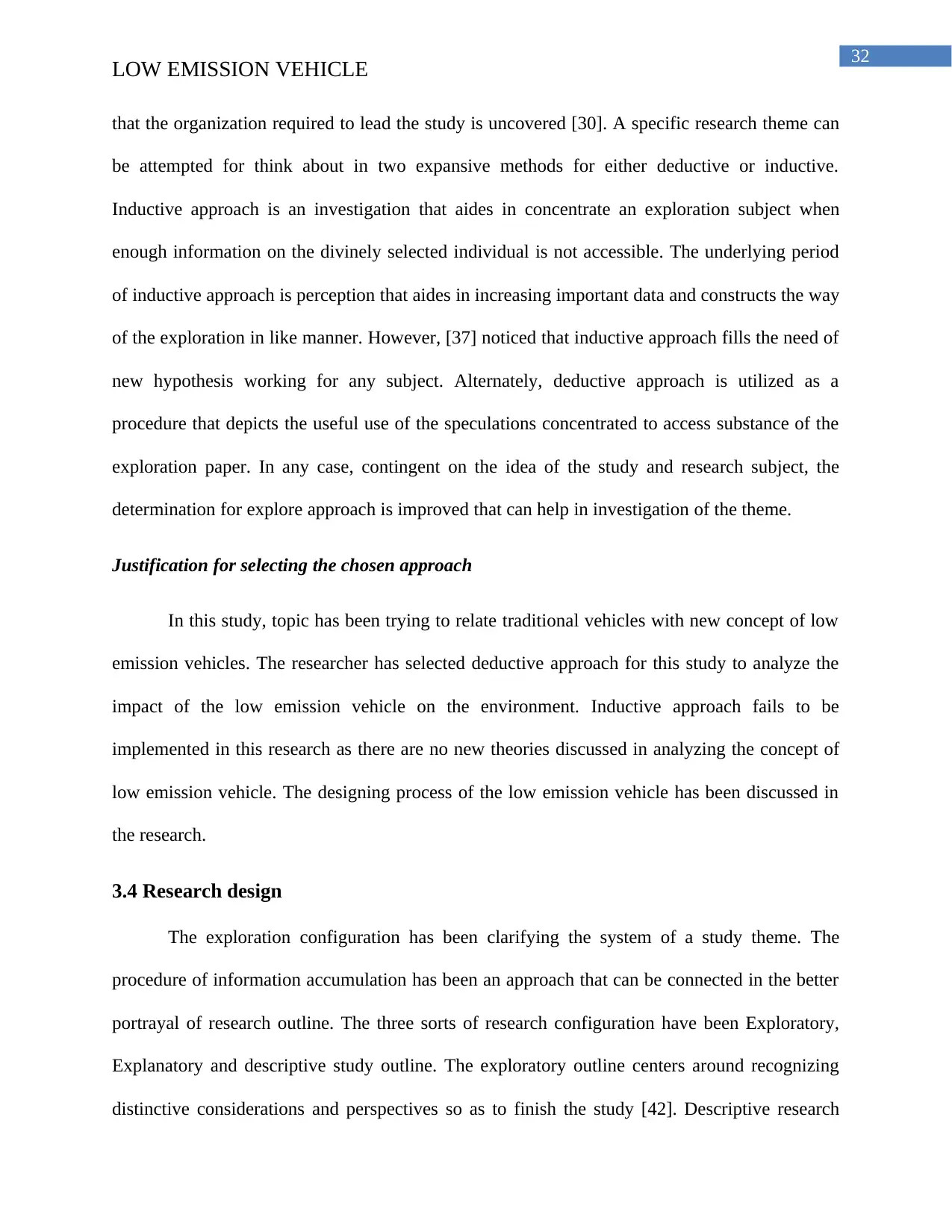
32
LOW EMISSION VEHICLE
that the organization required to lead the study is uncovered [30]. A specific research theme can
be attempted for think about in two expansive methods for either deductive or inductive.
Inductive approach is an investigation that aides in concentrate an exploration subject when
enough information on the divinely selected individual is not accessible. The underlying period
of inductive approach is perception that aides in increasing important data and constructs the way
of the exploration in like manner. However, [37] noticed that inductive approach fills the need of
new hypothesis working for any subject. Alternately, deductive approach is utilized as a
procedure that depicts the useful use of the speculations concentrated to access substance of the
exploration paper. In any case, contingent on the idea of the study and research subject, the
determination for explore approach is improved that can help in investigation of the theme.
Justification for selecting the chosen approach
In this study, topic has been trying to relate traditional vehicles with new concept of low
emission vehicles. The researcher has selected deductive approach for this study to analyze the
impact of the low emission vehicle on the environment. Inductive approach fails to be
implemented in this research as there are no new theories discussed in analyzing the concept of
low emission vehicle. The designing process of the low emission vehicle has been discussed in
the research.
3.4 Research design
The exploration configuration has been clarifying the system of a study theme. The
procedure of information accumulation has been an approach that can be connected in the better
portrayal of research outline. The three sorts of research configuration have been Exploratory,
Explanatory and descriptive study outline. The exploratory outline centers around recognizing
distinctive considerations and perspectives so as to finish the study [42]. Descriptive research
LOW EMISSION VEHICLE
that the organization required to lead the study is uncovered [30]. A specific research theme can
be attempted for think about in two expansive methods for either deductive or inductive.
Inductive approach is an investigation that aides in concentrate an exploration subject when
enough information on the divinely selected individual is not accessible. The underlying period
of inductive approach is perception that aides in increasing important data and constructs the way
of the exploration in like manner. However, [37] noticed that inductive approach fills the need of
new hypothesis working for any subject. Alternately, deductive approach is utilized as a
procedure that depicts the useful use of the speculations concentrated to access substance of the
exploration paper. In any case, contingent on the idea of the study and research subject, the
determination for explore approach is improved that can help in investigation of the theme.
Justification for selecting the chosen approach
In this study, topic has been trying to relate traditional vehicles with new concept of low
emission vehicles. The researcher has selected deductive approach for this study to analyze the
impact of the low emission vehicle on the environment. Inductive approach fails to be
implemented in this research as there are no new theories discussed in analyzing the concept of
low emission vehicle. The designing process of the low emission vehicle has been discussed in
the research.
3.4 Research design
The exploration configuration has been clarifying the system of a study theme. The
procedure of information accumulation has been an approach that can be connected in the better
portrayal of research outline. The three sorts of research configuration have been Exploratory,
Explanatory and descriptive study outline. The exploratory outline centers around recognizing
distinctive considerations and perspectives so as to finish the study [42]. Descriptive research

33
LOW EMISSION VEHICLE
design helps in giving the event of different occurrences that are influencing the utilization of
data innovation in the development business. Exploratory research design alludes to achieving
insights about all segments of research and its characteristics.
In the generic approach, task, pattern and spillage emanations from utilization of power
are ascertained in light of the amount of power devoured, a discharge factor for power age and a
factor to represent transmission misfortunes, as follows:
PE EC,y
= ∑ECPJ, j,y
× EFEL, j,y
× (1+ TDL j,y
) (1)
j
BE EC,y
= ∑ECBL,k, y
× EFEL,k, y
× (1+ TDLk,y
) (2)
k
LE EC,y
= ∑ECLE,l,y
× EFEL,l,y
× (1+ TDLl,y
) (3)
l
Where:
= Project emissions from electricity consumption in year y (tCO2/yr)PEEC,y
BEEC,y = Baseline emissions from electricity consumption in year y (tCO2/yr)
LEEC,y = Leakage emissions from electricity consumption in year y (tCO2/yr)
ECPJ,j,y = Quantity of electricity consumed by the project electricity consumption source j in year y
(MWh/yr)
ECBL,k,y = Quantity of electricity that would be consumed by the baseline electricity consumption
source k in year y (MWh/yr)
ECLE,l,y = Net increase in electricity consumption of source l in year y as a result of leakage2
(MWh/yr)
EFEL,j,y = Emission factor for electricity generation for source j in year y (tCO2/MWh)
EFEL,k,y = Emission factor for electricity generation for source k in year y (tCO2/MWh)
EFEL,l,y = Emission factor for electricity generation for source l in year y (tCO2/MWh)
TDLj,y = Average technical transmission and distribution losses for providing electricity to source j
LOW EMISSION VEHICLE
design helps in giving the event of different occurrences that are influencing the utilization of
data innovation in the development business. Exploratory research design alludes to achieving
insights about all segments of research and its characteristics.
In the generic approach, task, pattern and spillage emanations from utilization of power
are ascertained in light of the amount of power devoured, a discharge factor for power age and a
factor to represent transmission misfortunes, as follows:
PE EC,y
= ∑ECPJ, j,y
× EFEL, j,y
× (1+ TDL j,y
) (1)
j
BE EC,y
= ∑ECBL,k, y
× EFEL,k, y
× (1+ TDLk,y
) (2)
k
LE EC,y
= ∑ECLE,l,y
× EFEL,l,y
× (1+ TDLl,y
) (3)
l
Where:
= Project emissions from electricity consumption in year y (tCO2/yr)PEEC,y
BEEC,y = Baseline emissions from electricity consumption in year y (tCO2/yr)
LEEC,y = Leakage emissions from electricity consumption in year y (tCO2/yr)
ECPJ,j,y = Quantity of electricity consumed by the project electricity consumption source j in year y
(MWh/yr)
ECBL,k,y = Quantity of electricity that would be consumed by the baseline electricity consumption
source k in year y (MWh/yr)
ECLE,l,y = Net increase in electricity consumption of source l in year y as a result of leakage2
(MWh/yr)
EFEL,j,y = Emission factor for electricity generation for source j in year y (tCO2/MWh)
EFEL,k,y = Emission factor for electricity generation for source k in year y (tCO2/MWh)
EFEL,l,y = Emission factor for electricity generation for source l in year y (tCO2/MWh)
TDLj,y = Average technical transmission and distribution losses for providing electricity to source j
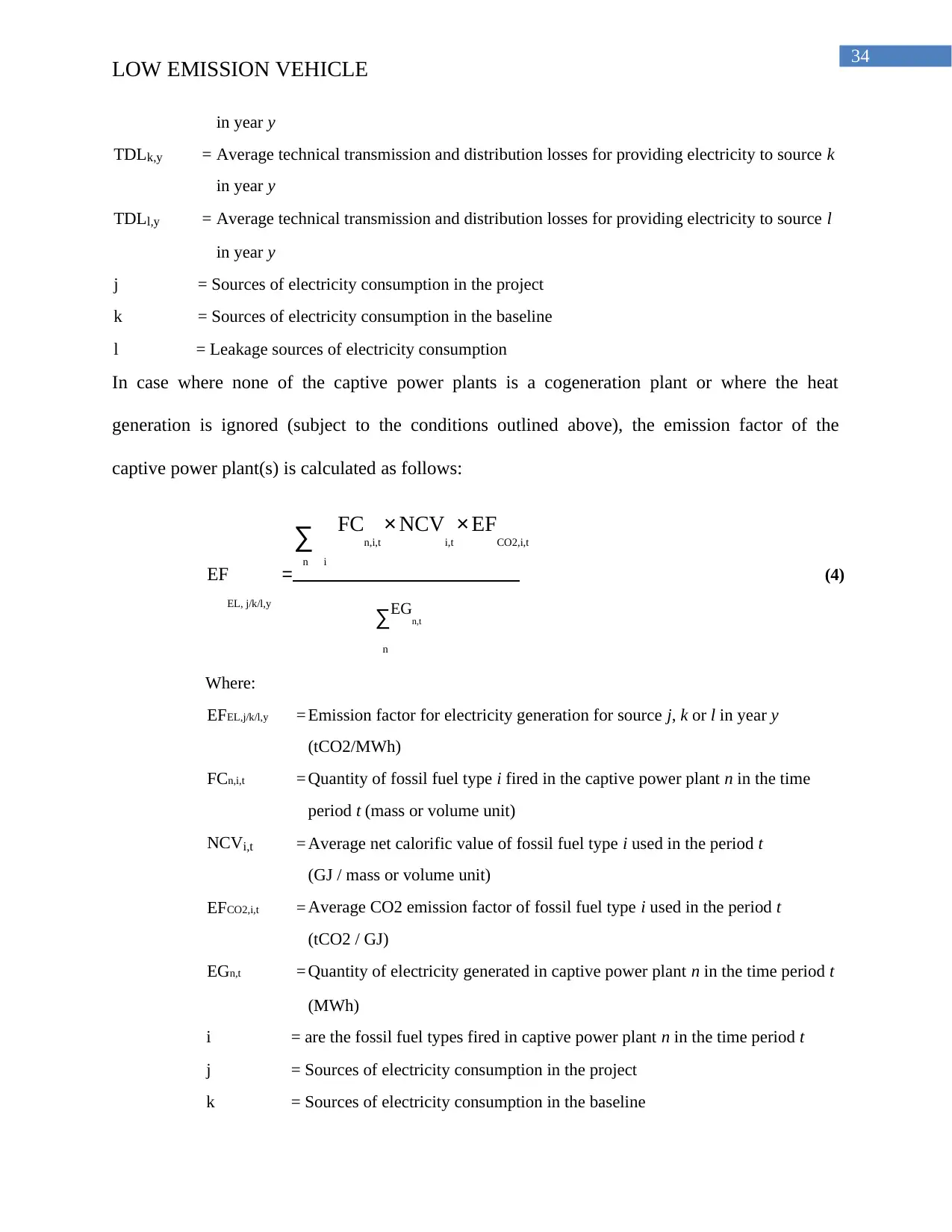
34
LOW EMISSION VEHICLE
in year y
TDLk,y = Average technical transmission and distribution losses for providing electricity to source k
in year y
TDLl,y = Average technical transmission and distribution losses for providing electricity to source l
in year y
j = Sources of electricity consumption in the project
k = Sources of electricity consumption in the baseline
l = Leakage sources of electricity consumption
In case where none of the captive power plants is a cogeneration plant or where the heat
generation is ignored (subject to the conditions outlined above), the emission factor of the
captive power plant(s) is calculated as follows:
∑ FCn,i,t
× NCVi,t
× EFCO2,i,t
EF = n i
(4)
∑EGn,t
EL, j/k/l,y
n
Where:
= Emission factor for electricity generation for source j, k or l in year yEFEL,j/k/l,y
(tCO2/MWh)
FCn,i,t = Quantity of fossil fuel type i fired in the captive power plant n in the time
period t (mass or volume unit)
NCVi,t = Average net calorific value of fossil fuel type i used in the period t
(GJ / mass or volume unit)
EFCO2,i,t = Average CO2 emission factor of fossil fuel type i used in the period t
(tCO2 / GJ)
EGn,t = Quantity of electricity generated in captive power plant n in the time period t
(MWh)
i = are the fossil fuel types fired in captive power plant n in the time period t
j = Sources of electricity consumption in the project
k = Sources of electricity consumption in the baseline
LOW EMISSION VEHICLE
in year y
TDLk,y = Average technical transmission and distribution losses for providing electricity to source k
in year y
TDLl,y = Average technical transmission and distribution losses for providing electricity to source l
in year y
j = Sources of electricity consumption in the project
k = Sources of electricity consumption in the baseline
l = Leakage sources of electricity consumption
In case where none of the captive power plants is a cogeneration plant or where the heat
generation is ignored (subject to the conditions outlined above), the emission factor of the
captive power plant(s) is calculated as follows:
∑ FCn,i,t
× NCVi,t
× EFCO2,i,t
EF = n i
(4)
∑EGn,t
EL, j/k/l,y
n
Where:
= Emission factor for electricity generation for source j, k or l in year yEFEL,j/k/l,y
(tCO2/MWh)
FCn,i,t = Quantity of fossil fuel type i fired in the captive power plant n in the time
period t (mass or volume unit)
NCVi,t = Average net calorific value of fossil fuel type i used in the period t
(GJ / mass or volume unit)
EFCO2,i,t = Average CO2 emission factor of fossil fuel type i used in the period t
(tCO2 / GJ)
EGn,t = Quantity of electricity generated in captive power plant n in the time period t
(MWh)
i = are the fossil fuel types fired in captive power plant n in the time period t
j = Sources of electricity consumption in the project
k = Sources of electricity consumption in the baseline
Secure Best Marks with AI Grader
Need help grading? Try our AI Grader for instant feedback on your assignments.
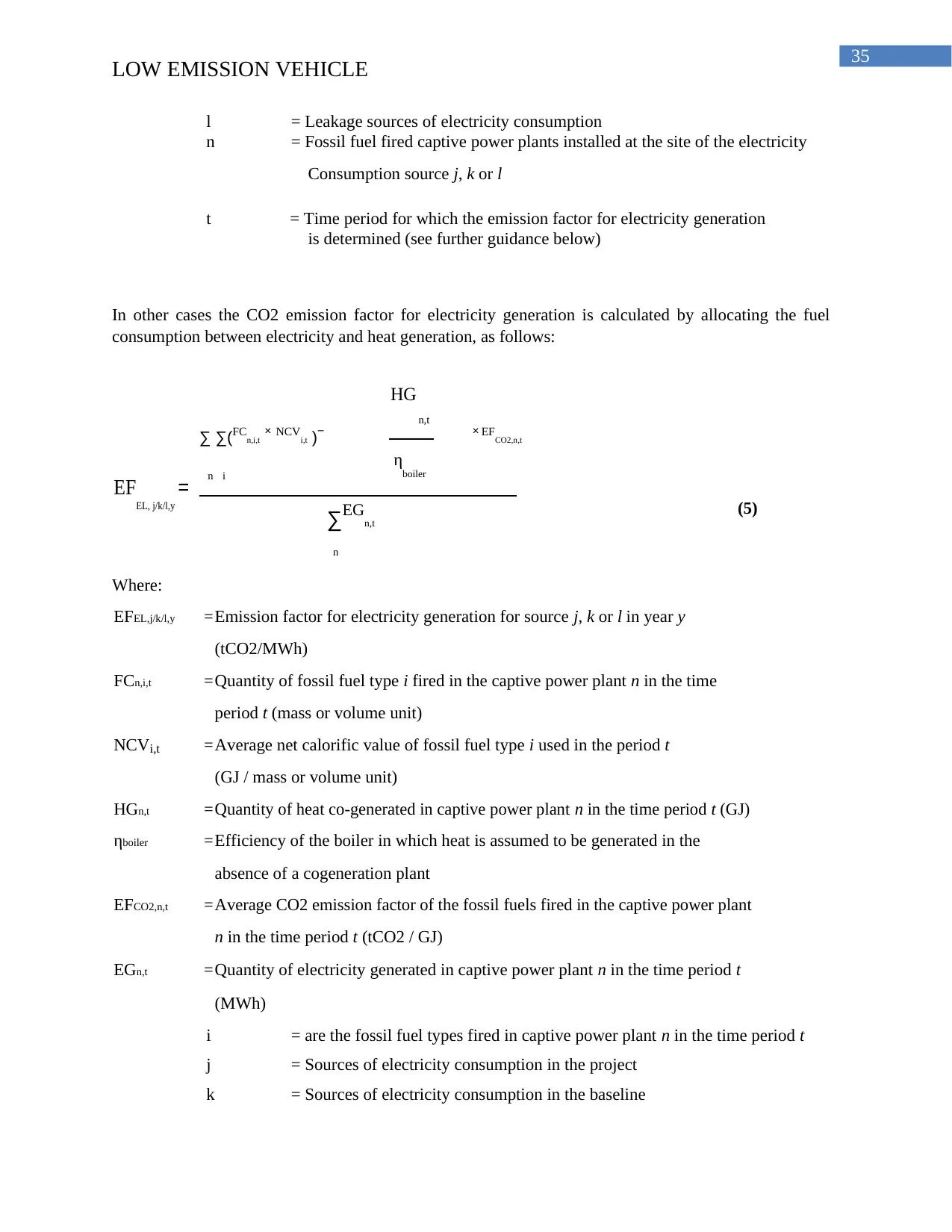
35
LOW EMISSION VEHICLE
l = Leakage sources of electricity consumption
n = Fossil fuel fired captive power plants installed at the site of the electricity
Consumption source j, k or l
t = Time period for which the emission factor for electricity generation
is determined (see further guidance below)
In other cases the CO2 emission factor for electricity generation is calculated by allocating the fuel
consumption between electricity and heat generation, as follows:
HG
n,t
∑ ∑(FCn,i,t × NCVi,t )− × EFCO2,n,t
ηboiler
EF
EL, j/k/l,y
= n i
(5)
∑EGn,t
n
Where:
=Emission factor for electricity generation for source j, k or l in year yEFEL,j/k/l,y
(tCO2/MWh)
FCn,i,t =Quantity of fossil fuel type i fired in the captive power plant n in the time
period t (mass or volume unit)
NCVi,t =Average net calorific value of fossil fuel type i used in the period t
(GJ / mass or volume unit)
HGn,t = Quantity of heat co-generated in captive power plant n in the time period t (GJ)
ηboiler =Efficiency of the boiler in which heat is assumed to be generated in the
absence of a cogeneration plant
EFCO2,n,t = Average CO2 emission factor of the fossil fuels fired in the captive power plant
n in the time period t (tCO2 / GJ)
EGn,t =Quantity of electricity generated in captive power plant n in the time period t
(MWh)
i = are the fossil fuel types fired in captive power plant n in the time period t
j = Sources of electricity consumption in the project
k = Sources of electricity consumption in the baseline
LOW EMISSION VEHICLE
l = Leakage sources of electricity consumption
n = Fossil fuel fired captive power plants installed at the site of the electricity
Consumption source j, k or l
t = Time period for which the emission factor for electricity generation
is determined (see further guidance below)
In other cases the CO2 emission factor for electricity generation is calculated by allocating the fuel
consumption between electricity and heat generation, as follows:
HG
n,t
∑ ∑(FCn,i,t × NCVi,t )− × EFCO2,n,t
ηboiler
EF
EL, j/k/l,y
= n i
(5)
∑EGn,t
n
Where:
=Emission factor for electricity generation for source j, k or l in year yEFEL,j/k/l,y
(tCO2/MWh)
FCn,i,t =Quantity of fossil fuel type i fired in the captive power plant n in the time
period t (mass or volume unit)
NCVi,t =Average net calorific value of fossil fuel type i used in the period t
(GJ / mass or volume unit)
HGn,t = Quantity of heat co-generated in captive power plant n in the time period t (GJ)
ηboiler =Efficiency of the boiler in which heat is assumed to be generated in the
absence of a cogeneration plant
EFCO2,n,t = Average CO2 emission factor of the fossil fuels fired in the captive power plant
n in the time period t (tCO2 / GJ)
EGn,t =Quantity of electricity generated in captive power plant n in the time period t
(MWh)
i = are the fossil fuel types fired in captive power plant n in the time period t
j = Sources of electricity consumption in the project
k = Sources of electricity consumption in the baseline
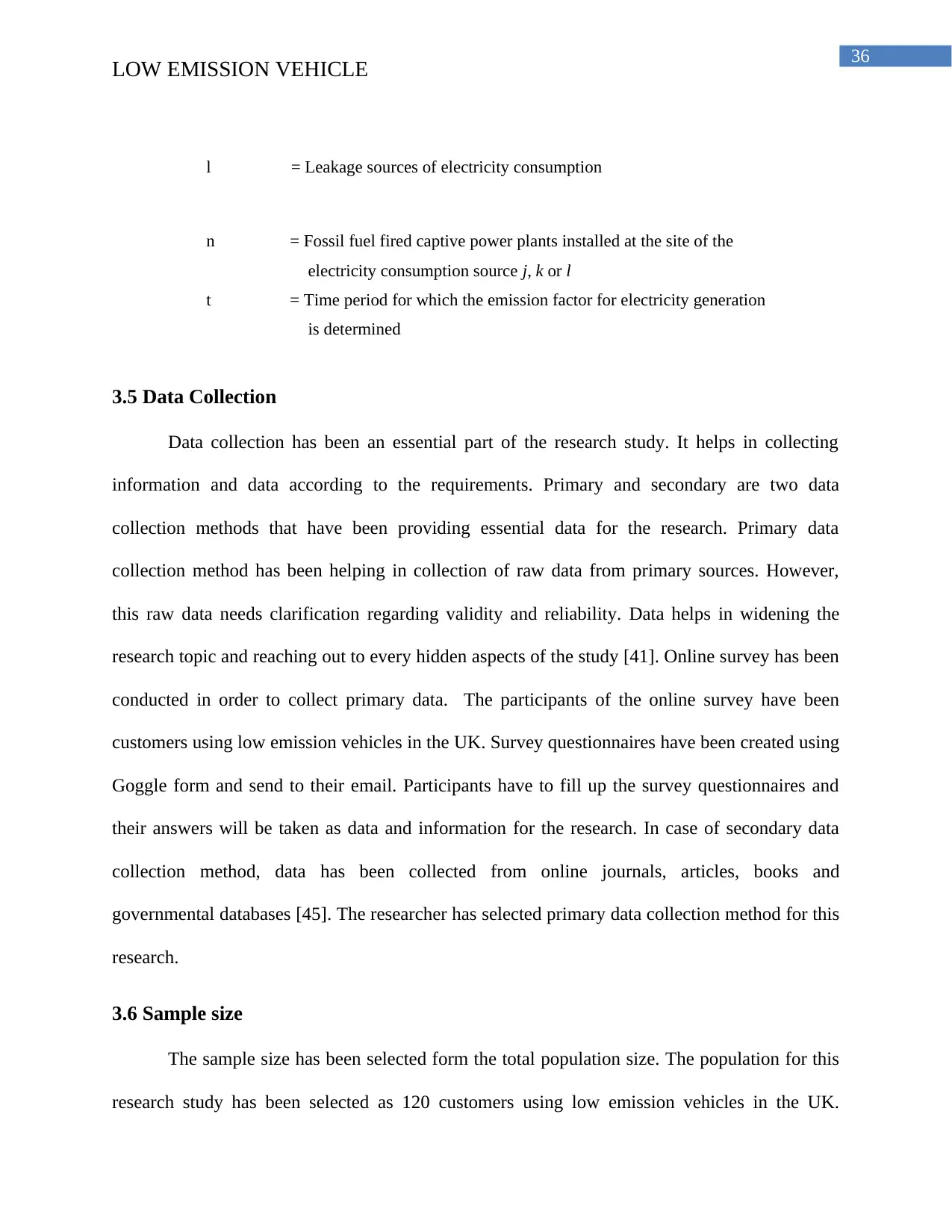
36
LOW EMISSION VEHICLE
l = Leakage sources of electricity consumption
n = Fossil fuel fired captive power plants installed at the site of the
electricity consumption source j, k or l
t = Time period for which the emission factor for electricity generation
is determined
3.5 Data Collection
Data collection has been an essential part of the research study. It helps in collecting
information and data according to the requirements. Primary and secondary are two data
collection methods that have been providing essential data for the research. Primary data
collection method has been helping in collection of raw data from primary sources. However,
this raw data needs clarification regarding validity and reliability. Data helps in widening the
research topic and reaching out to every hidden aspects of the study [41]. Online survey has been
conducted in order to collect primary data. The participants of the online survey have been
customers using low emission vehicles in the UK. Survey questionnaires have been created using
Goggle form and send to their email. Participants have to fill up the survey questionnaires and
their answers will be taken as data and information for the research. In case of secondary data
collection method, data has been collected from online journals, articles, books and
governmental databases [45]. The researcher has selected primary data collection method for this
research.
3.6 Sample size
The sample size has been selected form the total population size. The population for this
research study has been selected as 120 customers using low emission vehicles in the UK.
LOW EMISSION VEHICLE
l = Leakage sources of electricity consumption
n = Fossil fuel fired captive power plants installed at the site of the
electricity consumption source j, k or l
t = Time period for which the emission factor for electricity generation
is determined
3.5 Data Collection
Data collection has been an essential part of the research study. It helps in collecting
information and data according to the requirements. Primary and secondary are two data
collection methods that have been providing essential data for the research. Primary data
collection method has been helping in collection of raw data from primary sources. However,
this raw data needs clarification regarding validity and reliability. Data helps in widening the
research topic and reaching out to every hidden aspects of the study [41]. Online survey has been
conducted in order to collect primary data. The participants of the online survey have been
customers using low emission vehicles in the UK. Survey questionnaires have been created using
Goggle form and send to their email. Participants have to fill up the survey questionnaires and
their answers will be taken as data and information for the research. In case of secondary data
collection method, data has been collected from online journals, articles, books and
governmental databases [45]. The researcher has selected primary data collection method for this
research.
3.6 Sample size
The sample size has been selected form the total population size. The population for this
research study has been selected as 120 customers using low emission vehicles in the UK.
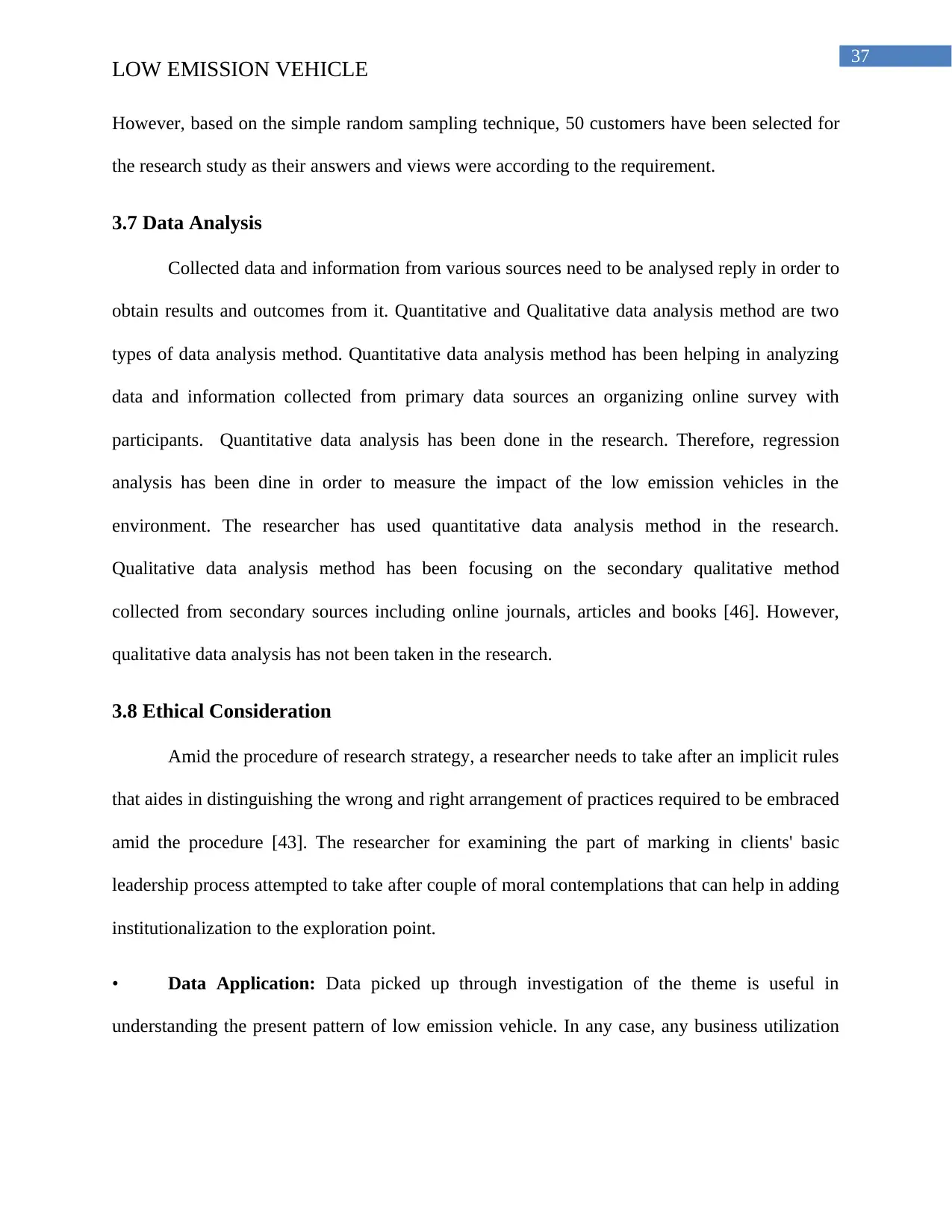
37
LOW EMISSION VEHICLE
However, based on the simple random sampling technique, 50 customers have been selected for
the research study as their answers and views were according to the requirement.
3.7 Data Analysis
Collected data and information from various sources need to be analysed reply in order to
obtain results and outcomes from it. Quantitative and Qualitative data analysis method are two
types of data analysis method. Quantitative data analysis method has been helping in analyzing
data and information collected from primary data sources an organizing online survey with
participants. Quantitative data analysis has been done in the research. Therefore, regression
analysis has been dine in order to measure the impact of the low emission vehicles in the
environment. The researcher has used quantitative data analysis method in the research.
Qualitative data analysis method has been focusing on the secondary qualitative method
collected from secondary sources including online journals, articles and books [46]. However,
qualitative data analysis has not been taken in the research.
3.8 Ethical Consideration
Amid the procedure of research strategy, a researcher needs to take after an implicit rules
that aides in distinguishing the wrong and right arrangement of practices required to be embraced
amid the procedure [43]. The researcher for examining the part of marking in clients' basic
leadership process attempted to take after couple of moral contemplations that can help in adding
institutionalization to the exploration point.
• Data Application: Data picked up through investigation of the theme is useful in
understanding the present pattern of low emission vehicle. In any case, any business utilization
LOW EMISSION VEHICLE
However, based on the simple random sampling technique, 50 customers have been selected for
the research study as their answers and views were according to the requirement.
3.7 Data Analysis
Collected data and information from various sources need to be analysed reply in order to
obtain results and outcomes from it. Quantitative and Qualitative data analysis method are two
types of data analysis method. Quantitative data analysis method has been helping in analyzing
data and information collected from primary data sources an organizing online survey with
participants. Quantitative data analysis has been done in the research. Therefore, regression
analysis has been dine in order to measure the impact of the low emission vehicles in the
environment. The researcher has used quantitative data analysis method in the research.
Qualitative data analysis method has been focusing on the secondary qualitative method
collected from secondary sources including online journals, articles and books [46]. However,
qualitative data analysis has not been taken in the research.
3.8 Ethical Consideration
Amid the procedure of research strategy, a researcher needs to take after an implicit rules
that aides in distinguishing the wrong and right arrangement of practices required to be embraced
amid the procedure [43]. The researcher for examining the part of marking in clients' basic
leadership process attempted to take after couple of moral contemplations that can help in adding
institutionalization to the exploration point.
• Data Application: Data picked up through investigation of the theme is useful in
understanding the present pattern of low emission vehicle. In any case, any business utilization
Paraphrase This Document
Need a fresh take? Get an instant paraphrase of this document with our AI Paraphraser
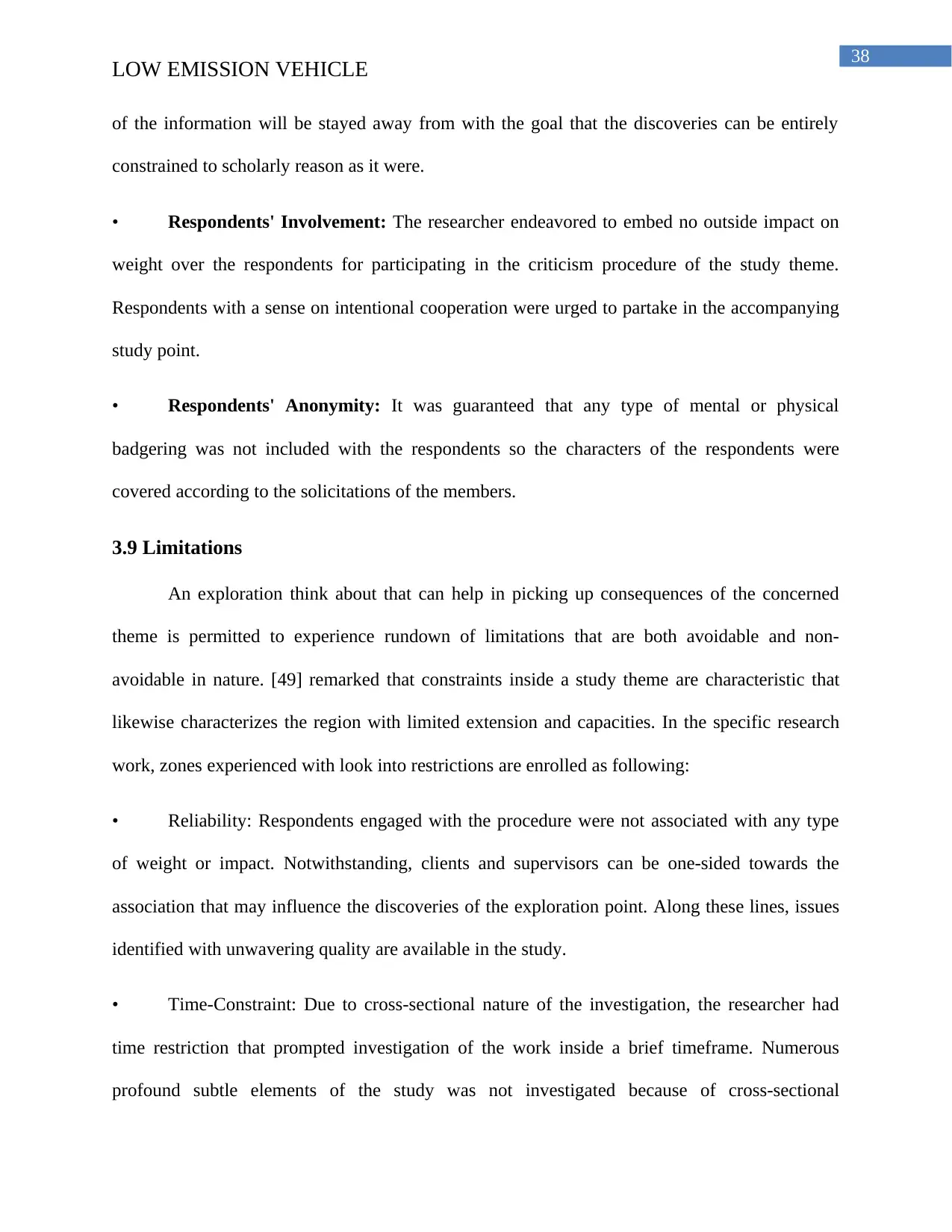
38
LOW EMISSION VEHICLE
of the information will be stayed away from with the goal that the discoveries can be entirely
constrained to scholarly reason as it were.
• Respondents' Involvement: The researcher endeavored to embed no outside impact on
weight over the respondents for participating in the criticism procedure of the study theme.
Respondents with a sense on intentional cooperation were urged to partake in the accompanying
study point.
• Respondents' Anonymity: It was guaranteed that any type of mental or physical
badgering was not included with the respondents so the characters of the respondents were
covered according to the solicitations of the members.
3.9 Limitations
An exploration think about that can help in picking up consequences of the concerned
theme is permitted to experience rundown of limitations that are both avoidable and non-
avoidable in nature. [49] remarked that constraints inside a study theme are characteristic that
likewise characterizes the region with limited extension and capacities. In the specific research
work, zones experienced with look into restrictions are enrolled as following:
• Reliability: Respondents engaged with the procedure were not associated with any type
of weight or impact. Notwithstanding, clients and supervisors can be one-sided towards the
association that may influence the discoveries of the exploration point. Along these lines, issues
identified with unwavering quality are available in the study.
• Time-Constraint: Due to cross-sectional nature of the investigation, the researcher had
time restriction that prompted investigation of the work inside a brief timeframe. Numerous
profound subtle elements of the study was not investigated because of cross-sectional
LOW EMISSION VEHICLE
of the information will be stayed away from with the goal that the discoveries can be entirely
constrained to scholarly reason as it were.
• Respondents' Involvement: The researcher endeavored to embed no outside impact on
weight over the respondents for participating in the criticism procedure of the study theme.
Respondents with a sense on intentional cooperation were urged to partake in the accompanying
study point.
• Respondents' Anonymity: It was guaranteed that any type of mental or physical
badgering was not included with the respondents so the characters of the respondents were
covered according to the solicitations of the members.
3.9 Limitations
An exploration think about that can help in picking up consequences of the concerned
theme is permitted to experience rundown of limitations that are both avoidable and non-
avoidable in nature. [49] remarked that constraints inside a study theme are characteristic that
likewise characterizes the region with limited extension and capacities. In the specific research
work, zones experienced with look into restrictions are enrolled as following:
• Reliability: Respondents engaged with the procedure were not associated with any type
of weight or impact. Notwithstanding, clients and supervisors can be one-sided towards the
association that may influence the discoveries of the exploration point. Along these lines, issues
identified with unwavering quality are available in the study.
• Time-Constraint: Due to cross-sectional nature of the investigation, the researcher had
time restriction that prompted investigation of the work inside a brief timeframe. Numerous
profound subtle elements of the study was not investigated because of cross-sectional
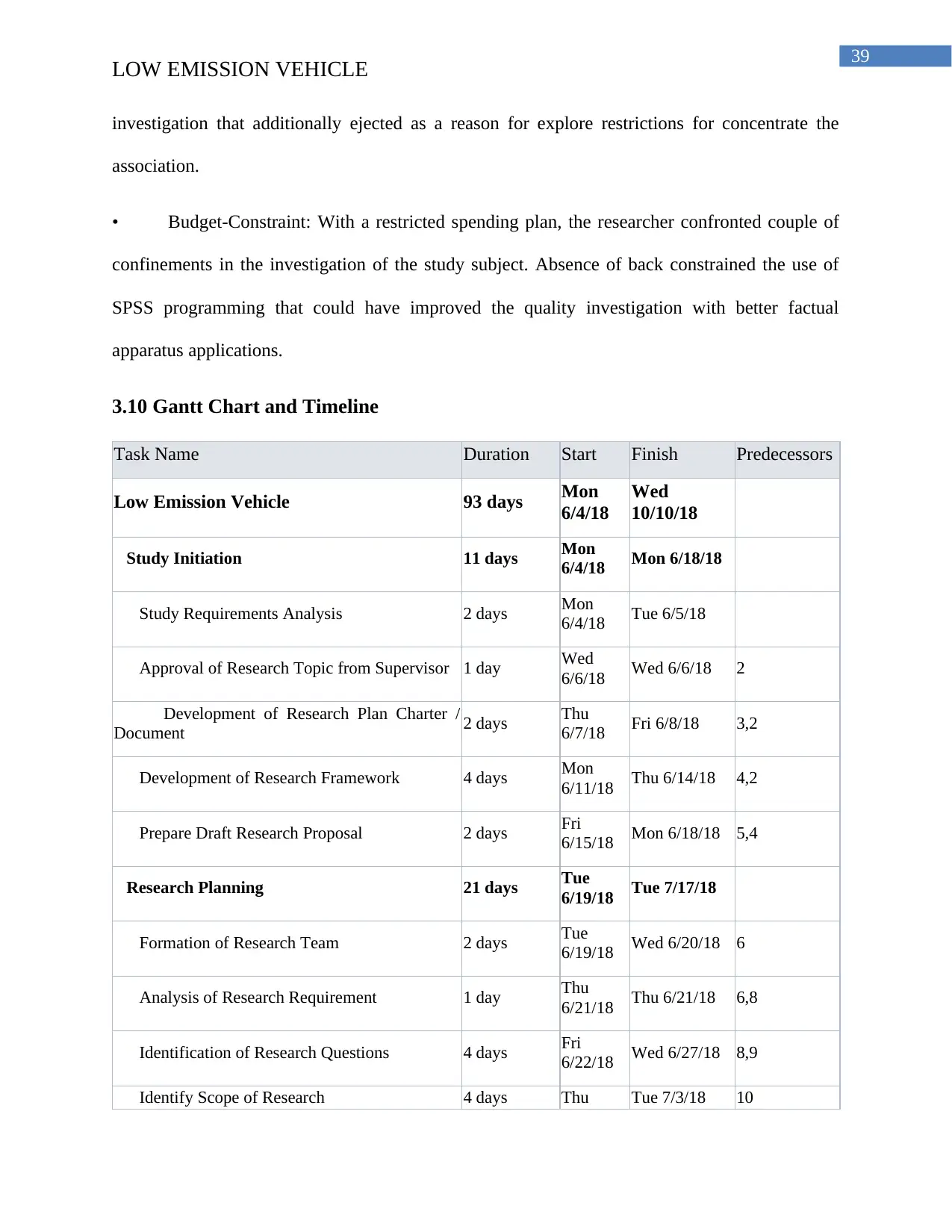
39
LOW EMISSION VEHICLE
investigation that additionally ejected as a reason for explore restrictions for concentrate the
association.
• Budget-Constraint: With a restricted spending plan, the researcher confronted couple of
confinements in the investigation of the study subject. Absence of back constrained the use of
SPSS programming that could have improved the quality investigation with better factual
apparatus applications.
3.10 Gantt Chart and Timeline
Task Name Duration Start Finish Predecessors
Low Emission Vehicle 93 days Mon
6/4/18
Wed
10/10/18
Study Initiation 11 days Mon
6/4/18 Mon 6/18/18
Study Requirements Analysis 2 days Mon
6/4/18 Tue 6/5/18
Approval of Research Topic from Supervisor 1 day Wed
6/6/18 Wed 6/6/18 2
Development of Research Plan Charter /
Document 2 days Thu
6/7/18 Fri 6/8/18 3,2
Development of Research Framework 4 days Mon
6/11/18 Thu 6/14/18 4,2
Prepare Draft Research Proposal 2 days Fri
6/15/18 Mon 6/18/18 5,4
Research Planning 21 days Tue
6/19/18 Tue 7/17/18
Formation of Research Team 2 days Tue
6/19/18 Wed 6/20/18 6
Analysis of Research Requirement 1 day Thu
6/21/18 Thu 6/21/18 6,8
Identification of Research Questions 4 days Fri
6/22/18 Wed 6/27/18 8,9
Identify Scope of Research 4 days Thu Tue 7/3/18 10
LOW EMISSION VEHICLE
investigation that additionally ejected as a reason for explore restrictions for concentrate the
association.
• Budget-Constraint: With a restricted spending plan, the researcher confronted couple of
confinements in the investigation of the study subject. Absence of back constrained the use of
SPSS programming that could have improved the quality investigation with better factual
apparatus applications.
3.10 Gantt Chart and Timeline
Task Name Duration Start Finish Predecessors
Low Emission Vehicle 93 days Mon
6/4/18
Wed
10/10/18
Study Initiation 11 days Mon
6/4/18 Mon 6/18/18
Study Requirements Analysis 2 days Mon
6/4/18 Tue 6/5/18
Approval of Research Topic from Supervisor 1 day Wed
6/6/18 Wed 6/6/18 2
Development of Research Plan Charter /
Document 2 days Thu
6/7/18 Fri 6/8/18 3,2
Development of Research Framework 4 days Mon
6/11/18 Thu 6/14/18 4,2
Prepare Draft Research Proposal 2 days Fri
6/15/18 Mon 6/18/18 5,4
Research Planning 21 days Tue
6/19/18 Tue 7/17/18
Formation of Research Team 2 days Tue
6/19/18 Wed 6/20/18 6
Analysis of Research Requirement 1 day Thu
6/21/18 Thu 6/21/18 6,8
Identification of Research Questions 4 days Fri
6/22/18 Wed 6/27/18 8,9
Identify Scope of Research 4 days Thu Tue 7/3/18 10
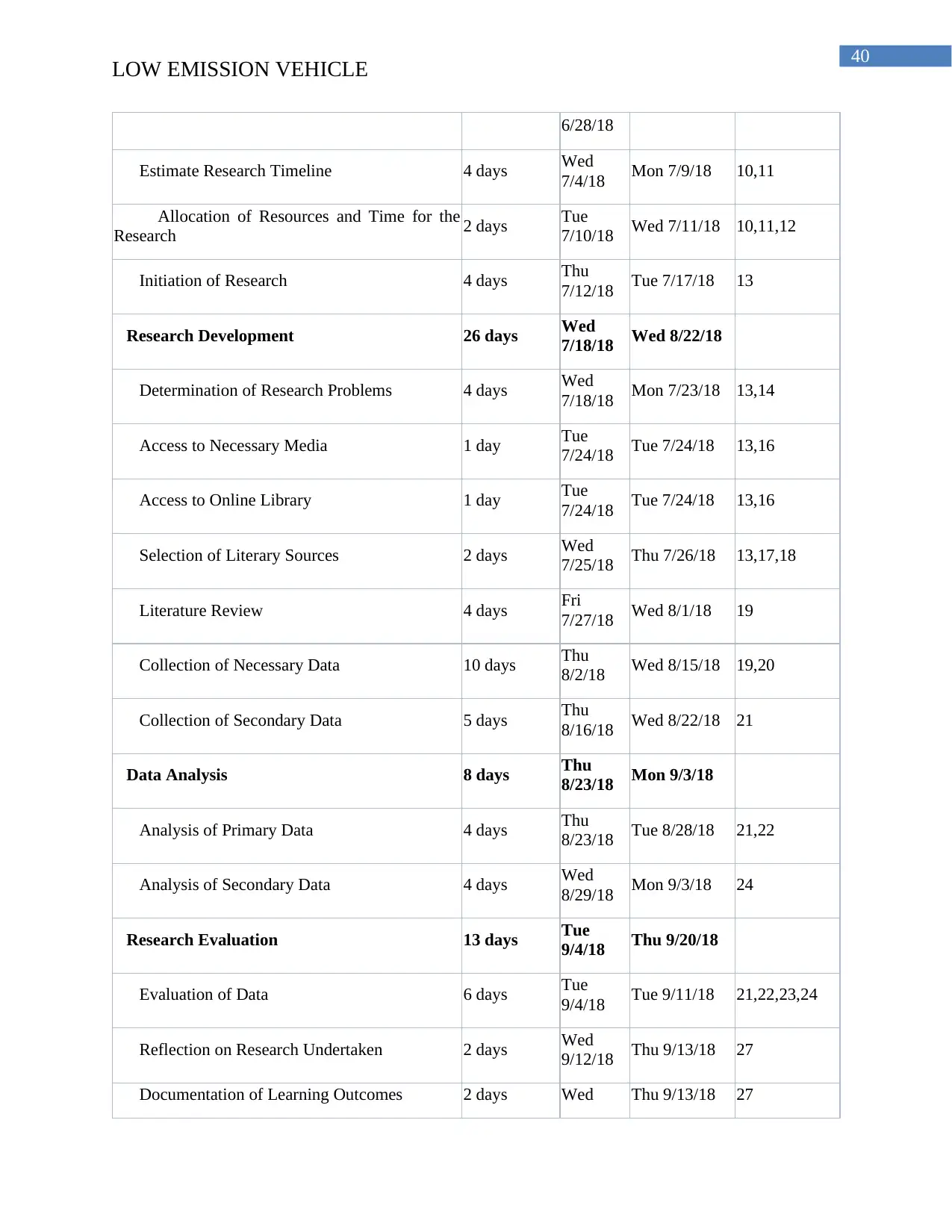
40
LOW EMISSION VEHICLE
6/28/18
Estimate Research Timeline 4 days Wed
7/4/18 Mon 7/9/18 10,11
Allocation of Resources and Time for the
Research 2 days Tue
7/10/18 Wed 7/11/18 10,11,12
Initiation of Research 4 days Thu
7/12/18 Tue 7/17/18 13
Research Development 26 days Wed
7/18/18 Wed 8/22/18
Determination of Research Problems 4 days Wed
7/18/18 Mon 7/23/18 13,14
Access to Necessary Media 1 day Tue
7/24/18 Tue 7/24/18 13,16
Access to Online Library 1 day Tue
7/24/18 Tue 7/24/18 13,16
Selection of Literary Sources 2 days Wed
7/25/18 Thu 7/26/18 13,17,18
Literature Review 4 days Fri
7/27/18 Wed 8/1/18 19
Collection of Necessary Data 10 days Thu
8/2/18 Wed 8/15/18 19,20
Collection of Secondary Data 5 days Thu
8/16/18 Wed 8/22/18 21
Data Analysis 8 days Thu
8/23/18 Mon 9/3/18
Analysis of Primary Data 4 days Thu
8/23/18 Tue 8/28/18 21,22
Analysis of Secondary Data 4 days Wed
8/29/18 Mon 9/3/18 24
Research Evaluation 13 days Tue
9/4/18 Thu 9/20/18
Evaluation of Data 6 days Tue
9/4/18 Tue 9/11/18 21,22,23,24
Reflection on Research Undertaken 2 days Wed
9/12/18 Thu 9/13/18 27
Documentation of Learning Outcomes 2 days Wed Thu 9/13/18 27
LOW EMISSION VEHICLE
6/28/18
Estimate Research Timeline 4 days Wed
7/4/18 Mon 7/9/18 10,11
Allocation of Resources and Time for the
Research 2 days Tue
7/10/18 Wed 7/11/18 10,11,12
Initiation of Research 4 days Thu
7/12/18 Tue 7/17/18 13
Research Development 26 days Wed
7/18/18 Wed 8/22/18
Determination of Research Problems 4 days Wed
7/18/18 Mon 7/23/18 13,14
Access to Necessary Media 1 day Tue
7/24/18 Tue 7/24/18 13,16
Access to Online Library 1 day Tue
7/24/18 Tue 7/24/18 13,16
Selection of Literary Sources 2 days Wed
7/25/18 Thu 7/26/18 13,17,18
Literature Review 4 days Fri
7/27/18 Wed 8/1/18 19
Collection of Necessary Data 10 days Thu
8/2/18 Wed 8/15/18 19,20
Collection of Secondary Data 5 days Thu
8/16/18 Wed 8/22/18 21
Data Analysis 8 days Thu
8/23/18 Mon 9/3/18
Analysis of Primary Data 4 days Thu
8/23/18 Tue 8/28/18 21,22
Analysis of Secondary Data 4 days Wed
8/29/18 Mon 9/3/18 24
Research Evaluation 13 days Tue
9/4/18 Thu 9/20/18
Evaluation of Data 6 days Tue
9/4/18 Tue 9/11/18 21,22,23,24
Reflection on Research Undertaken 2 days Wed
9/12/18 Thu 9/13/18 27
Documentation of Learning Outcomes 2 days Wed Thu 9/13/18 27
Secure Best Marks with AI Grader
Need help grading? Try our AI Grader for instant feedback on your assignments.
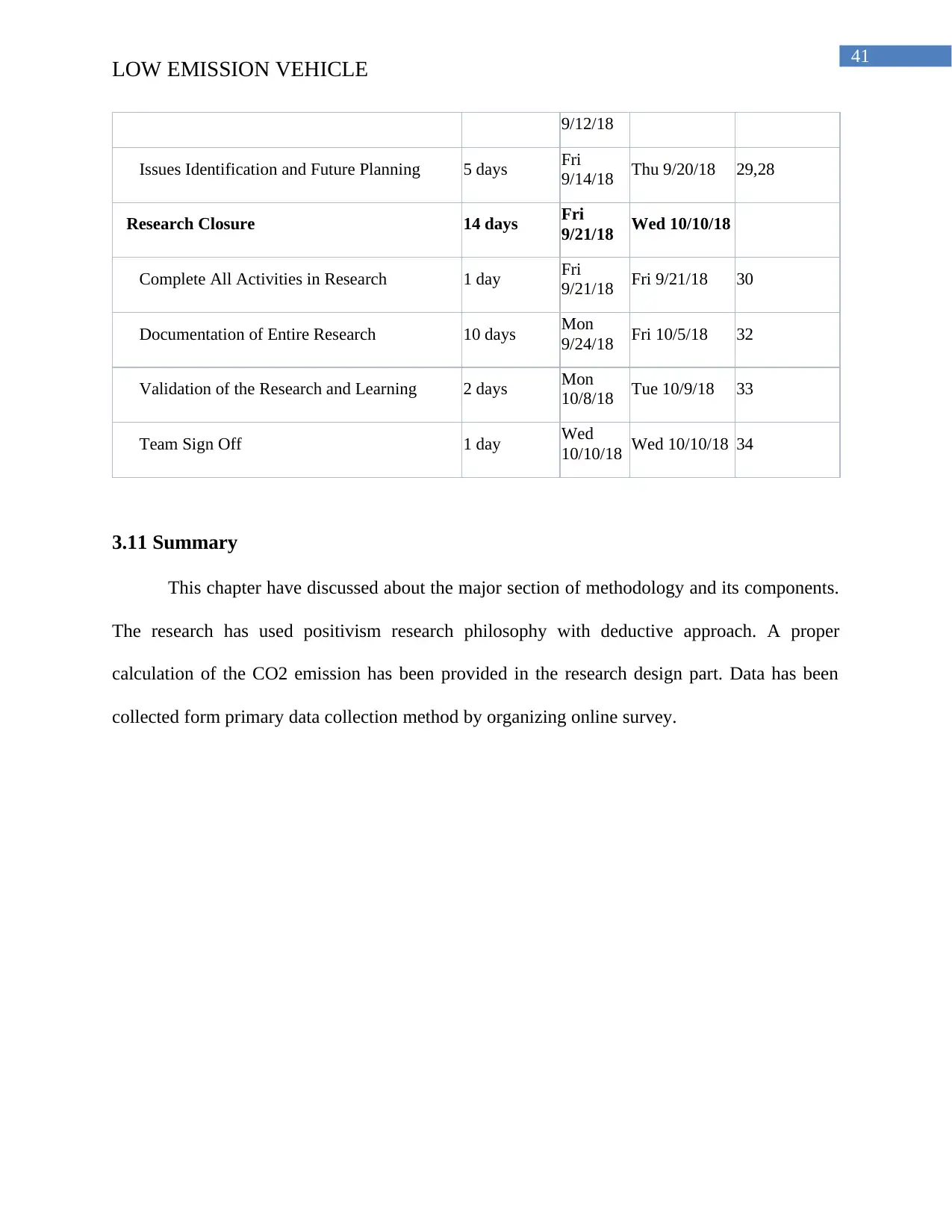
41
LOW EMISSION VEHICLE
9/12/18
Issues Identification and Future Planning 5 days Fri
9/14/18 Thu 9/20/18 29,28
Research Closure 14 days Fri
9/21/18 Wed 10/10/18
Complete All Activities in Research 1 day Fri
9/21/18 Fri 9/21/18 30
Documentation of Entire Research 10 days Mon
9/24/18 Fri 10/5/18 32
Validation of the Research and Learning 2 days Mon
10/8/18 Tue 10/9/18 33
Team Sign Off 1 day Wed
10/10/18 Wed 10/10/18 34
3.11 Summary
This chapter have discussed about the major section of methodology and its components.
The research has used positivism research philosophy with deductive approach. A proper
calculation of the CO2 emission has been provided in the research design part. Data has been
collected form primary data collection method by organizing online survey.
LOW EMISSION VEHICLE
9/12/18
Issues Identification and Future Planning 5 days Fri
9/14/18 Thu 9/20/18 29,28
Research Closure 14 days Fri
9/21/18 Wed 10/10/18
Complete All Activities in Research 1 day Fri
9/21/18 Fri 9/21/18 30
Documentation of Entire Research 10 days Mon
9/24/18 Fri 10/5/18 32
Validation of the Research and Learning 2 days Mon
10/8/18 Tue 10/9/18 33
Team Sign Off 1 day Wed
10/10/18 Wed 10/10/18 34
3.11 Summary
This chapter have discussed about the major section of methodology and its components.
The research has used positivism research philosophy with deductive approach. A proper
calculation of the CO2 emission has been provided in the research design part. Data has been
collected form primary data collection method by organizing online survey.
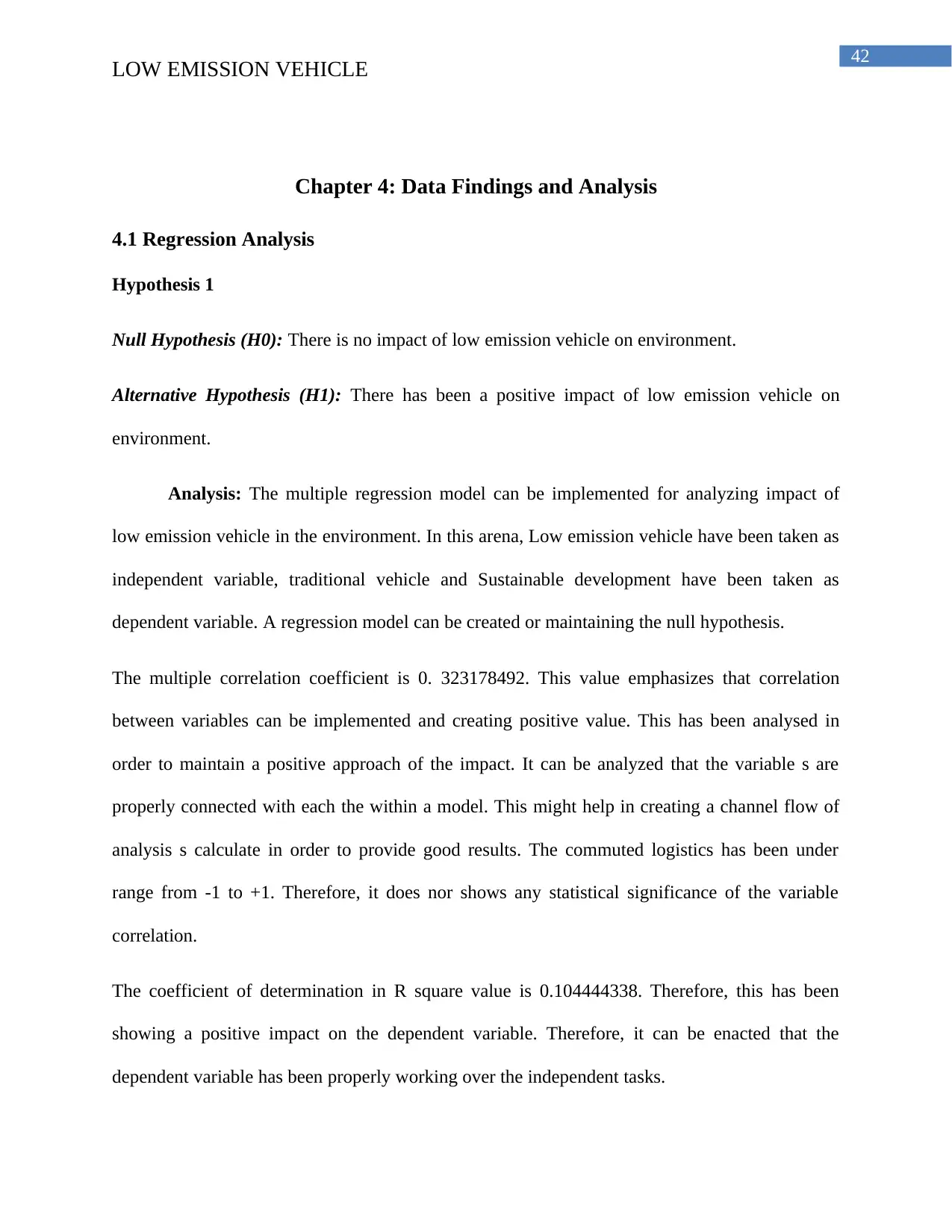
42
LOW EMISSION VEHICLE
Chapter 4: Data Findings and Analysis
4.1 Regression Analysis
Hypothesis 1
Null Hypothesis (H0): There is no impact of low emission vehicle on environment.
Alternative Hypothesis (H1): There has been a positive impact of low emission vehicle on
environment.
Analysis: The multiple regression model can be implemented for analyzing impact of
low emission vehicle in the environment. In this arena, Low emission vehicle have been taken as
independent variable, traditional vehicle and Sustainable development have been taken as
dependent variable. A regression model can be created or maintaining the null hypothesis.
The multiple correlation coefficient is 0. 323178492. This value emphasizes that correlation
between variables can be implemented and creating positive value. This has been analysed in
order to maintain a positive approach of the impact. It can be analyzed that the variable s are
properly connected with each the within a model. This might help in creating a channel flow of
analysis s calculate in order to provide good results. The commuted logistics has been under
range from -1 to +1. Therefore, it does nor shows any statistical significance of the variable
correlation.
The coefficient of determination in R square value is 0.104444338. Therefore, this has been
showing a positive impact on the dependent variable. Therefore, it can be enacted that the
dependent variable has been properly working over the independent tasks.
LOW EMISSION VEHICLE
Chapter 4: Data Findings and Analysis
4.1 Regression Analysis
Hypothesis 1
Null Hypothesis (H0): There is no impact of low emission vehicle on environment.
Alternative Hypothesis (H1): There has been a positive impact of low emission vehicle on
environment.
Analysis: The multiple regression model can be implemented for analyzing impact of
low emission vehicle in the environment. In this arena, Low emission vehicle have been taken as
independent variable, traditional vehicle and Sustainable development have been taken as
dependent variable. A regression model can be created or maintaining the null hypothesis.
The multiple correlation coefficient is 0. 323178492. This value emphasizes that correlation
between variables can be implemented and creating positive value. This has been analysed in
order to maintain a positive approach of the impact. It can be analyzed that the variable s are
properly connected with each the within a model. This might help in creating a channel flow of
analysis s calculate in order to provide good results. The commuted logistics has been under
range from -1 to +1. Therefore, it does nor shows any statistical significance of the variable
correlation.
The coefficient of determination in R square value is 0.104444338. Therefore, this has been
showing a positive impact on the dependent variable. Therefore, it can be enacted that the
dependent variable has been properly working over the independent tasks.
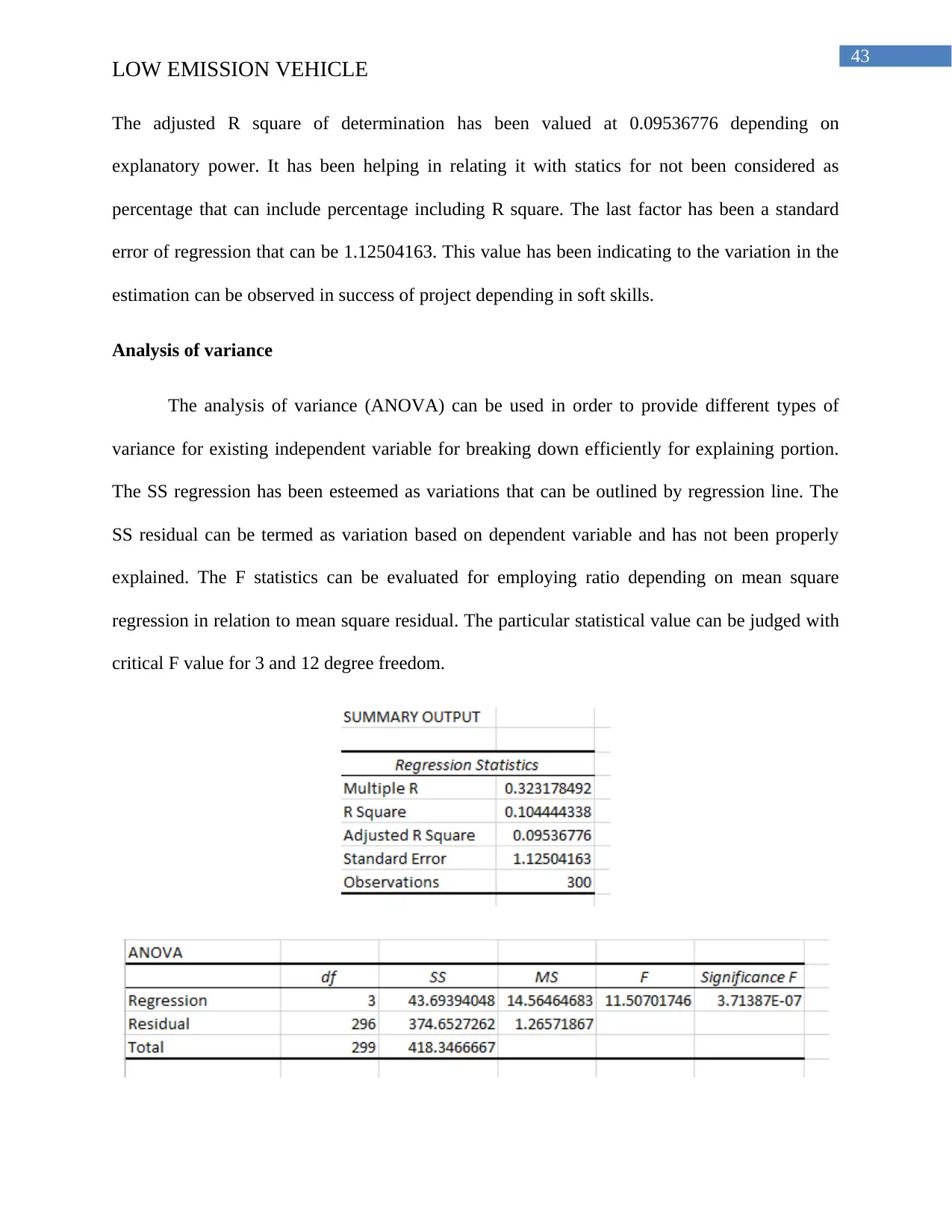
43
LOW EMISSION VEHICLE
The adjusted R square of determination has been valued at 0.09536776 depending on
explanatory power. It has been helping in relating it with statics for not been considered as
percentage that can include percentage including R square. The last factor has been a standard
error of regression that can be 1.12504163. This value has been indicating to the variation in the
estimation can be observed in success of project depending in soft skills.
Analysis of variance
The analysis of variance (ANOVA) can be used in order to provide different types of
variance for existing independent variable for breaking down efficiently for explaining portion.
The SS regression has been esteemed as variations that can be outlined by regression line. The
SS residual can be termed as variation based on dependent variable and has not been properly
explained. The F statistics can be evaluated for employing ratio depending on mean square
regression in relation to mean square residual. The particular statistical value can be judged with
critical F value for 3 and 12 degree freedom.
LOW EMISSION VEHICLE
The adjusted R square of determination has been valued at 0.09536776 depending on
explanatory power. It has been helping in relating it with statics for not been considered as
percentage that can include percentage including R square. The last factor has been a standard
error of regression that can be 1.12504163. This value has been indicating to the variation in the
estimation can be observed in success of project depending in soft skills.
Analysis of variance
The analysis of variance (ANOVA) can be used in order to provide different types of
variance for existing independent variable for breaking down efficiently for explaining portion.
The SS regression has been esteemed as variations that can be outlined by regression line. The
SS residual can be termed as variation based on dependent variable and has not been properly
explained. The F statistics can be evaluated for employing ratio depending on mean square
regression in relation to mean square residual. The particular statistical value can be judged with
critical F value for 3 and 12 degree freedom.
Paraphrase This Document
Need a fresh take? Get an instant paraphrase of this document with our AI Paraphraser
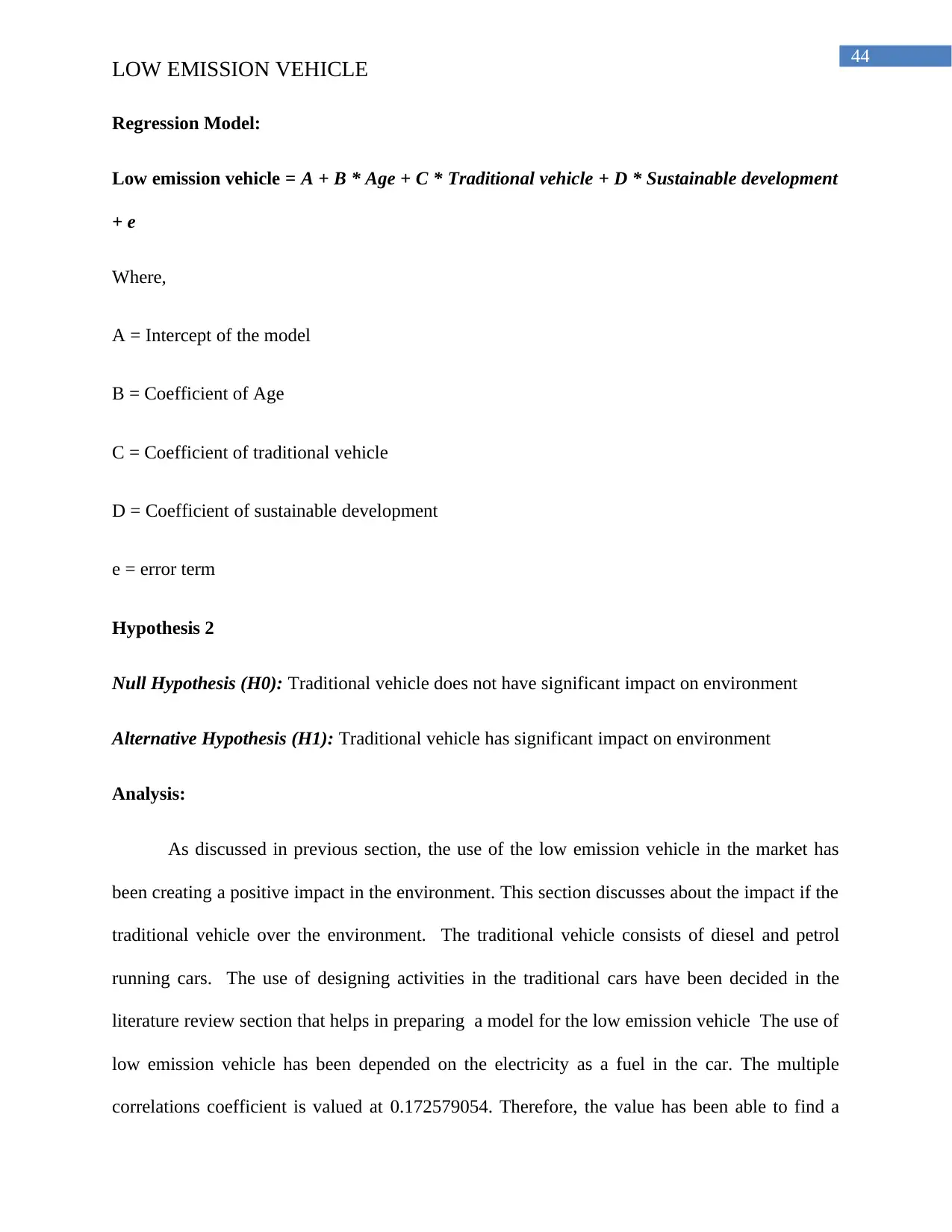
44
LOW EMISSION VEHICLE
Regression Model:
Low emission vehicle = A + B * Age + C * Traditional vehicle + D * Sustainable development
+ e
Where,
A = Intercept of the model
B = Coefficient of Age
C = Coefficient of traditional vehicle
D = Coefficient of sustainable development
e = error term
Hypothesis 2
Null Hypothesis (H0): Traditional vehicle does not have significant impact on environment
Alternative Hypothesis (H1): Traditional vehicle has significant impact on environment
Analysis:
As discussed in previous section, the use of the low emission vehicle in the market has
been creating a positive impact in the environment. This section discusses about the impact if the
traditional vehicle over the environment. The traditional vehicle consists of diesel and petrol
running cars. The use of designing activities in the traditional cars have been decided in the
literature review section that helps in preparing a model for the low emission vehicle The use of
low emission vehicle has been depended on the electricity as a fuel in the car. The multiple
correlations coefficient is valued at 0.172579054. Therefore, the value has been able to find a
LOW EMISSION VEHICLE
Regression Model:
Low emission vehicle = A + B * Age + C * Traditional vehicle + D * Sustainable development
+ e
Where,
A = Intercept of the model
B = Coefficient of Age
C = Coefficient of traditional vehicle
D = Coefficient of sustainable development
e = error term
Hypothesis 2
Null Hypothesis (H0): Traditional vehicle does not have significant impact on environment
Alternative Hypothesis (H1): Traditional vehicle has significant impact on environment
Analysis:
As discussed in previous section, the use of the low emission vehicle in the market has
been creating a positive impact in the environment. This section discusses about the impact if the
traditional vehicle over the environment. The traditional vehicle consists of diesel and petrol
running cars. The use of designing activities in the traditional cars have been decided in the
literature review section that helps in preparing a model for the low emission vehicle The use of
low emission vehicle has been depended on the electricity as a fuel in the car. The multiple
correlations coefficient is valued at 0.172579054. Therefore, the value has been able to find a
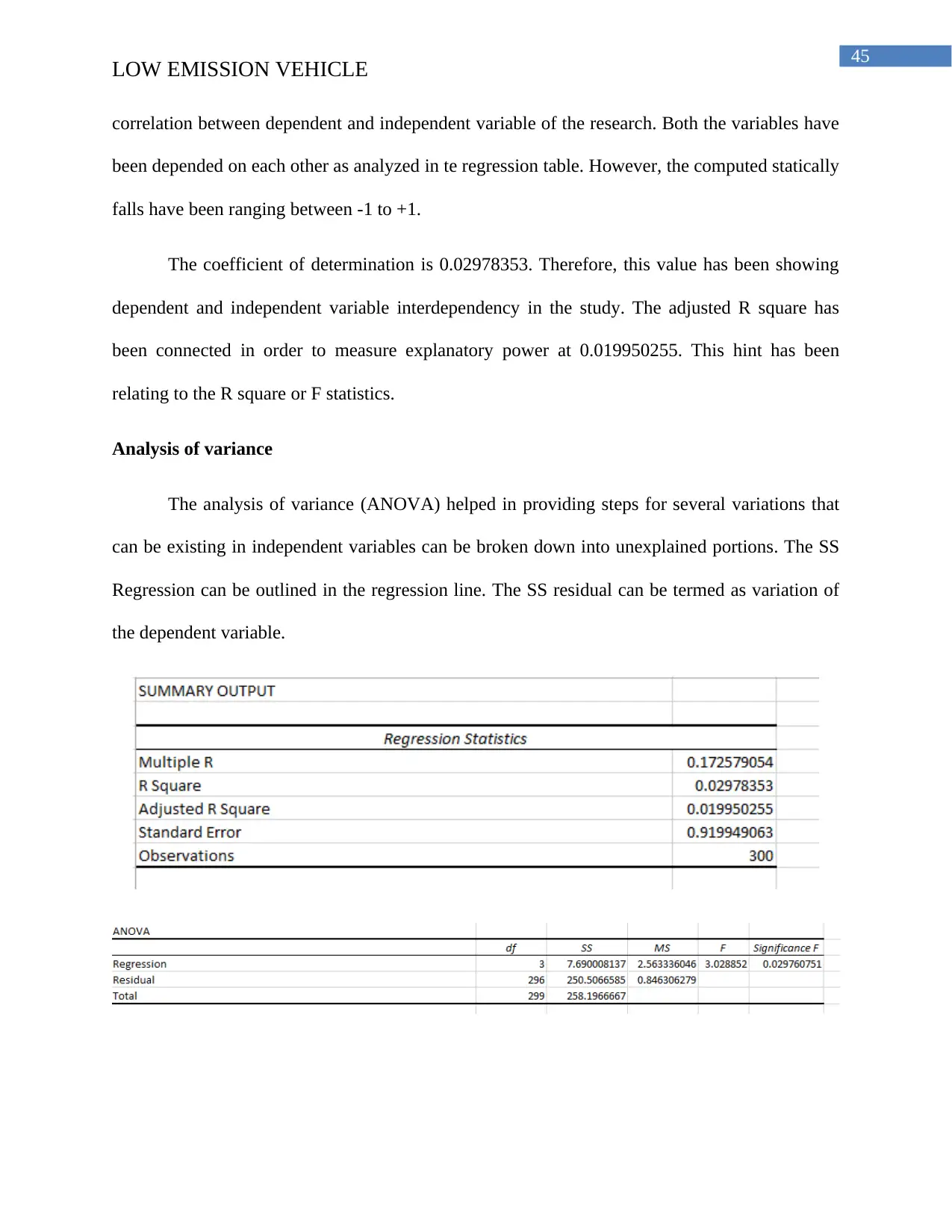
45
LOW EMISSION VEHICLE
correlation between dependent and independent variable of the research. Both the variables have
been depended on each other as analyzed in te regression table. However, the computed statically
falls have been ranging between -1 to +1.
The coefficient of determination is 0.02978353. Therefore, this value has been showing
dependent and independent variable interdependency in the study. The adjusted R square has
been connected in order to measure explanatory power at 0.019950255. This hint has been
relating to the R square or F statistics.
Analysis of variance
The analysis of variance (ANOVA) helped in providing steps for several variations that
can be existing in independent variables can be broken down into unexplained portions. The SS
Regression can be outlined in the regression line. The SS residual can be termed as variation of
the dependent variable.
LOW EMISSION VEHICLE
correlation between dependent and independent variable of the research. Both the variables have
been depended on each other as analyzed in te regression table. However, the computed statically
falls have been ranging between -1 to +1.
The coefficient of determination is 0.02978353. Therefore, this value has been showing
dependent and independent variable interdependency in the study. The adjusted R square has
been connected in order to measure explanatory power at 0.019950255. This hint has been
relating to the R square or F statistics.
Analysis of variance
The analysis of variance (ANOVA) helped in providing steps for several variations that
can be existing in independent variables can be broken down into unexplained portions. The SS
Regression can be outlined in the regression line. The SS residual can be termed as variation of
the dependent variable.
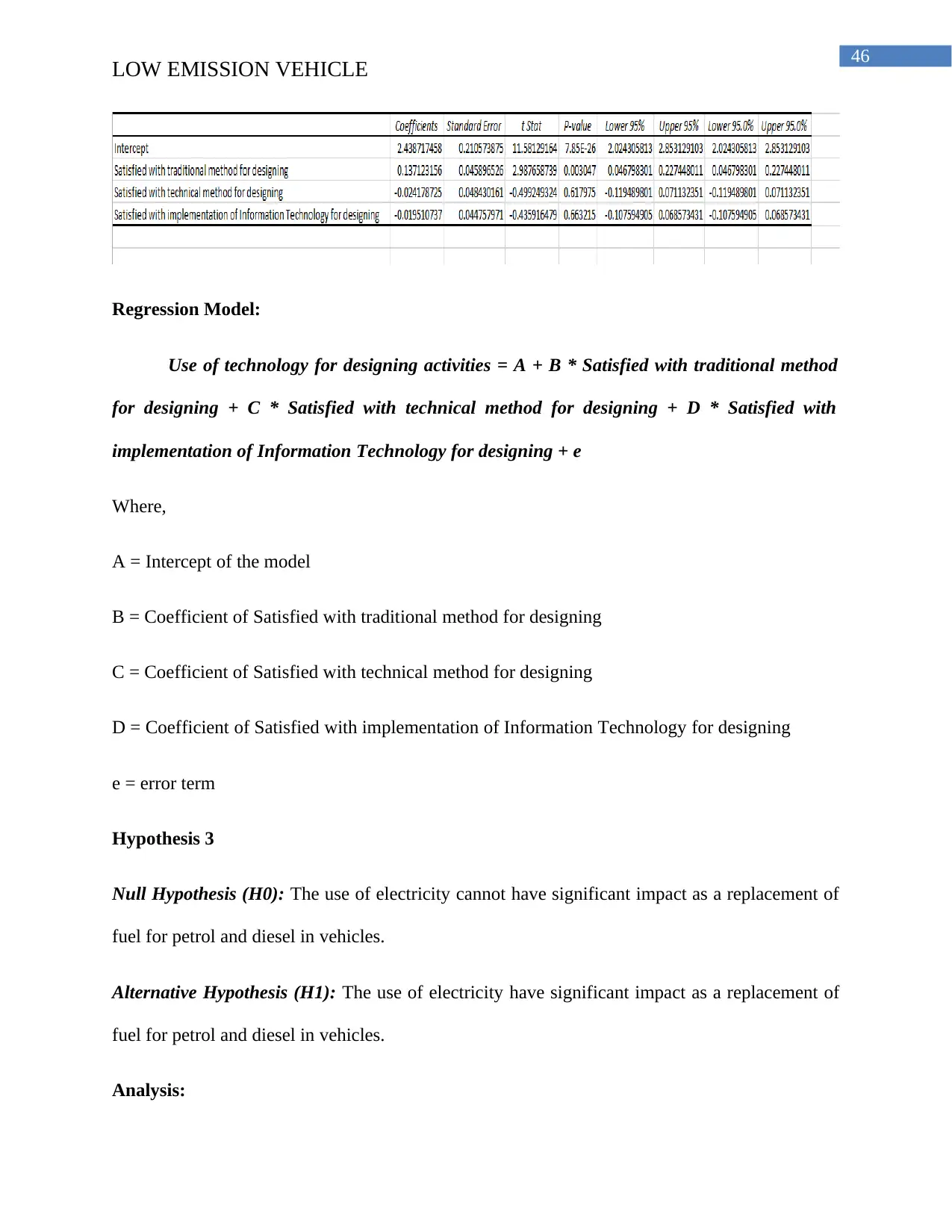
46
LOW EMISSION VEHICLE
Regression Model:
Use of technology for designing activities = A + B * Satisfied with traditional method
for designing + C * Satisfied with technical method for designing + D * Satisfied with
implementation of Information Technology for designing + e
Where,
A = Intercept of the model
B = Coefficient of Satisfied with traditional method for designing
C = Coefficient of Satisfied with technical method for designing
D = Coefficient of Satisfied with implementation of Information Technology for designing
e = error term
Hypothesis 3
Null Hypothesis (H0): The use of electricity cannot have significant impact as a replacement of
fuel for petrol and diesel in vehicles.
Alternative Hypothesis (H1): The use of electricity have significant impact as a replacement of
fuel for petrol and diesel in vehicles.
Analysis:
LOW EMISSION VEHICLE
Regression Model:
Use of technology for designing activities = A + B * Satisfied with traditional method
for designing + C * Satisfied with technical method for designing + D * Satisfied with
implementation of Information Technology for designing + e
Where,
A = Intercept of the model
B = Coefficient of Satisfied with traditional method for designing
C = Coefficient of Satisfied with technical method for designing
D = Coefficient of Satisfied with implementation of Information Technology for designing
e = error term
Hypothesis 3
Null Hypothesis (H0): The use of electricity cannot have significant impact as a replacement of
fuel for petrol and diesel in vehicles.
Alternative Hypothesis (H1): The use of electricity have significant impact as a replacement of
fuel for petrol and diesel in vehicles.
Analysis:
Secure Best Marks with AI Grader
Need help grading? Try our AI Grader for instant feedback on your assignments.
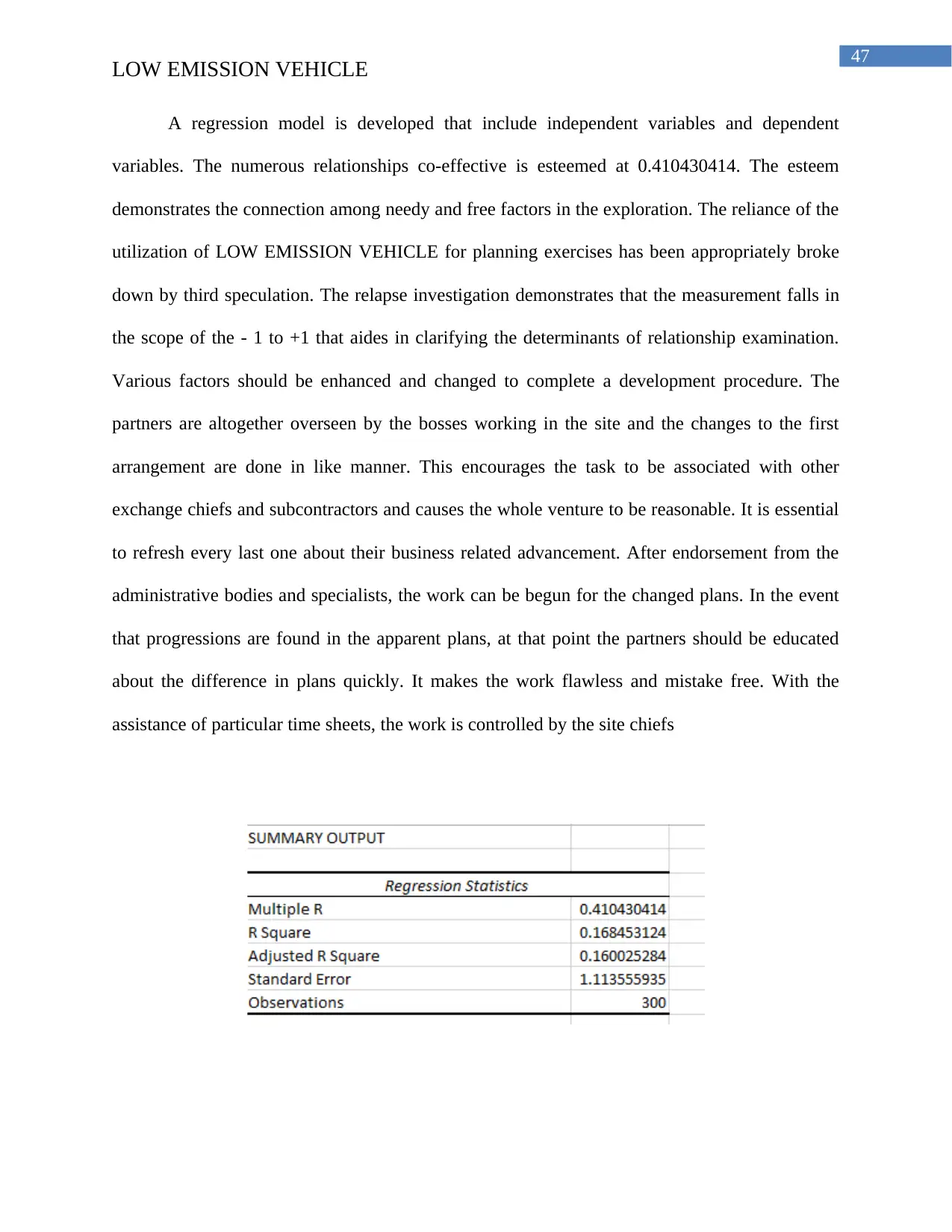
47
LOW EMISSION VEHICLE
A regression model is developed that include independent variables and dependent
variables. The numerous relationships co-effective is esteemed at 0.410430414. The esteem
demonstrates the connection among needy and free factors in the exploration. The reliance of the
utilization of LOW EMISSION VEHICLE for planning exercises has been appropriately broke
down by third speculation. The relapse investigation demonstrates that the measurement falls in
the scope of the - 1 to +1 that aides in clarifying the determinants of relationship examination.
Various factors should be enhanced and changed to complete a development procedure. The
partners are altogether overseen by the bosses working in the site and the changes to the first
arrangement are done in like manner. This encourages the task to be associated with other
exchange chiefs and subcontractors and causes the whole venture to be reasonable. It is essential
to refresh every last one about their business related advancement. After endorsement from the
administrative bodies and specialists, the work can be begun for the changed plans. In the event
that progressions are found in the apparent plans, at that point the partners should be educated
about the difference in plans quickly. It makes the work flawless and mistake free. With the
assistance of particular time sheets, the work is controlled by the site chiefs
LOW EMISSION VEHICLE
A regression model is developed that include independent variables and dependent
variables. The numerous relationships co-effective is esteemed at 0.410430414. The esteem
demonstrates the connection among needy and free factors in the exploration. The reliance of the
utilization of LOW EMISSION VEHICLE for planning exercises has been appropriately broke
down by third speculation. The relapse investigation demonstrates that the measurement falls in
the scope of the - 1 to +1 that aides in clarifying the determinants of relationship examination.
Various factors should be enhanced and changed to complete a development procedure. The
partners are altogether overseen by the bosses working in the site and the changes to the first
arrangement are done in like manner. This encourages the task to be associated with other
exchange chiefs and subcontractors and causes the whole venture to be reasonable. It is essential
to refresh every last one about their business related advancement. After endorsement from the
administrative bodies and specialists, the work can be begun for the changed plans. In the event
that progressions are found in the apparent plans, at that point the partners should be educated
about the difference in plans quickly. It makes the work flawless and mistake free. With the
assistance of particular time sheets, the work is controlled by the site chiefs
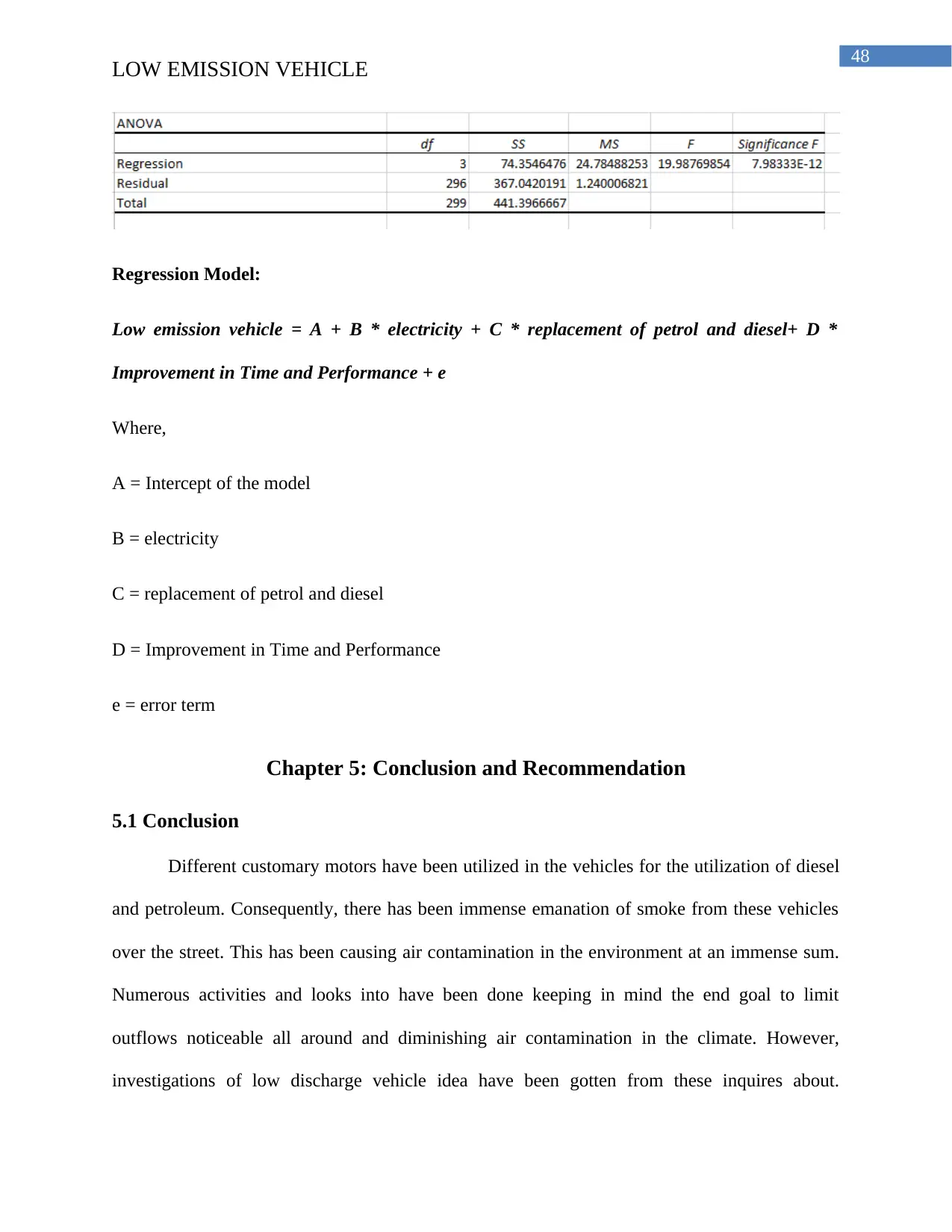
48
LOW EMISSION VEHICLE
Regression Model:
Low emission vehicle = A + B * electricity + C * replacement of petrol and diesel+ D *
Improvement in Time and Performance + e
Where,
A = Intercept of the model
B = electricity
C = replacement of petrol and diesel
D = Improvement in Time and Performance
e = error term
Chapter 5: Conclusion and Recommendation
5.1 Conclusion
Different customary motors have been utilized in the vehicles for the utilization of diesel
and petroleum. Consequently, there has been immense emanation of smoke from these vehicles
over the street. This has been causing air contamination in the environment at an immense sum.
Numerous activities and looks into have been done keeping in mind the end goal to limit
outflows noticeable all around and diminishing air contamination in the climate. However,
investigations of low discharge vehicle idea have been gotten from these inquires about.
LOW EMISSION VEHICLE
Regression Model:
Low emission vehicle = A + B * electricity + C * replacement of petrol and diesel+ D *
Improvement in Time and Performance + e
Where,
A = Intercept of the model
B = electricity
C = replacement of petrol and diesel
D = Improvement in Time and Performance
e = error term
Chapter 5: Conclusion and Recommendation
5.1 Conclusion
Different customary motors have been utilized in the vehicles for the utilization of diesel
and petroleum. Consequently, there has been immense emanation of smoke from these vehicles
over the street. This has been causing air contamination in the environment at an immense sum.
Numerous activities and looks into have been done keeping in mind the end goal to limit
outflows noticeable all around and diminishing air contamination in the climate. However,
investigations of low discharge vehicle idea have been gotten from these inquires about.
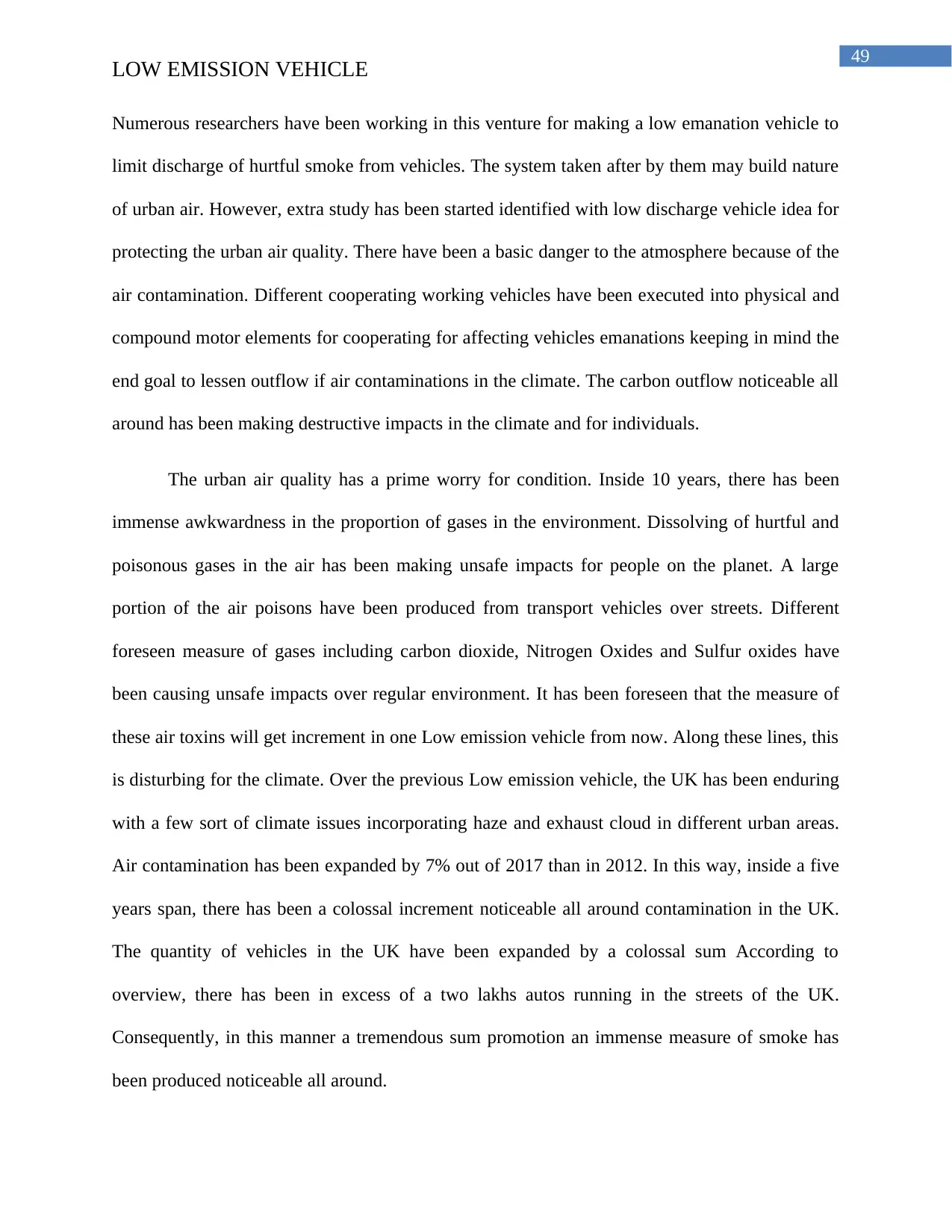
49
LOW EMISSION VEHICLE
Numerous researchers have been working in this venture for making a low emanation vehicle to
limit discharge of hurtful smoke from vehicles. The system taken after by them may build nature
of urban air. However, extra study has been started identified with low discharge vehicle idea for
protecting the urban air quality. There have been a basic danger to the atmosphere because of the
air contamination. Different cooperating working vehicles have been executed into physical and
compound motor elements for cooperating for affecting vehicles emanations keeping in mind the
end goal to lessen outflow if air contaminations in the climate. The carbon outflow noticeable all
around has been making destructive impacts in the climate and for individuals.
The urban air quality has a prime worry for condition. Inside 10 years, there has been
immense awkwardness in the proportion of gases in the environment. Dissolving of hurtful and
poisonous gases in the air has been making unsafe impacts for people on the planet. A large
portion of the air poisons have been produced from transport vehicles over streets. Different
foreseen measure of gases including carbon dioxide, Nitrogen Oxides and Sulfur oxides have
been causing unsafe impacts over regular environment. It has been foreseen that the measure of
these air toxins will get increment in one Low emission vehicle from now. Along these lines, this
is disturbing for the climate. Over the previous Low emission vehicle, the UK has been enduring
with a few sort of climate issues incorporating haze and exhaust cloud in different urban areas.
Air contamination has been expanded by 7% out of 2017 than in 2012. In this way, inside a five
years span, there has been a colossal increment noticeable all around contamination in the UK.
The quantity of vehicles in the UK have been expanded by a colossal sum According to
overview, there has been in excess of a two lakhs autos running in the streets of the UK.
Consequently, in this manner a tremendous sum promotion an immense measure of smoke has
been produced noticeable all around.
LOW EMISSION VEHICLE
Numerous researchers have been working in this venture for making a low emanation vehicle to
limit discharge of hurtful smoke from vehicles. The system taken after by them may build nature
of urban air. However, extra study has been started identified with low discharge vehicle idea for
protecting the urban air quality. There have been a basic danger to the atmosphere because of the
air contamination. Different cooperating working vehicles have been executed into physical and
compound motor elements for cooperating for affecting vehicles emanations keeping in mind the
end goal to lessen outflow if air contaminations in the climate. The carbon outflow noticeable all
around has been making destructive impacts in the climate and for individuals.
The urban air quality has a prime worry for condition. Inside 10 years, there has been
immense awkwardness in the proportion of gases in the environment. Dissolving of hurtful and
poisonous gases in the air has been making unsafe impacts for people on the planet. A large
portion of the air poisons have been produced from transport vehicles over streets. Different
foreseen measure of gases including carbon dioxide, Nitrogen Oxides and Sulfur oxides have
been causing unsafe impacts over regular environment. It has been foreseen that the measure of
these air toxins will get increment in one Low emission vehicle from now. Along these lines, this
is disturbing for the climate. Over the previous Low emission vehicle, the UK has been enduring
with a few sort of climate issues incorporating haze and exhaust cloud in different urban areas.
Air contamination has been expanded by 7% out of 2017 than in 2012. In this way, inside a five
years span, there has been a colossal increment noticeable all around contamination in the UK.
The quantity of vehicles in the UK have been expanded by a colossal sum According to
overview, there has been in excess of a two lakhs autos running in the streets of the UK.
Consequently, in this manner a tremendous sum promotion an immense measure of smoke has
been produced noticeable all around.
Paraphrase This Document
Need a fresh take? Get an instant paraphrase of this document with our AI Paraphraser
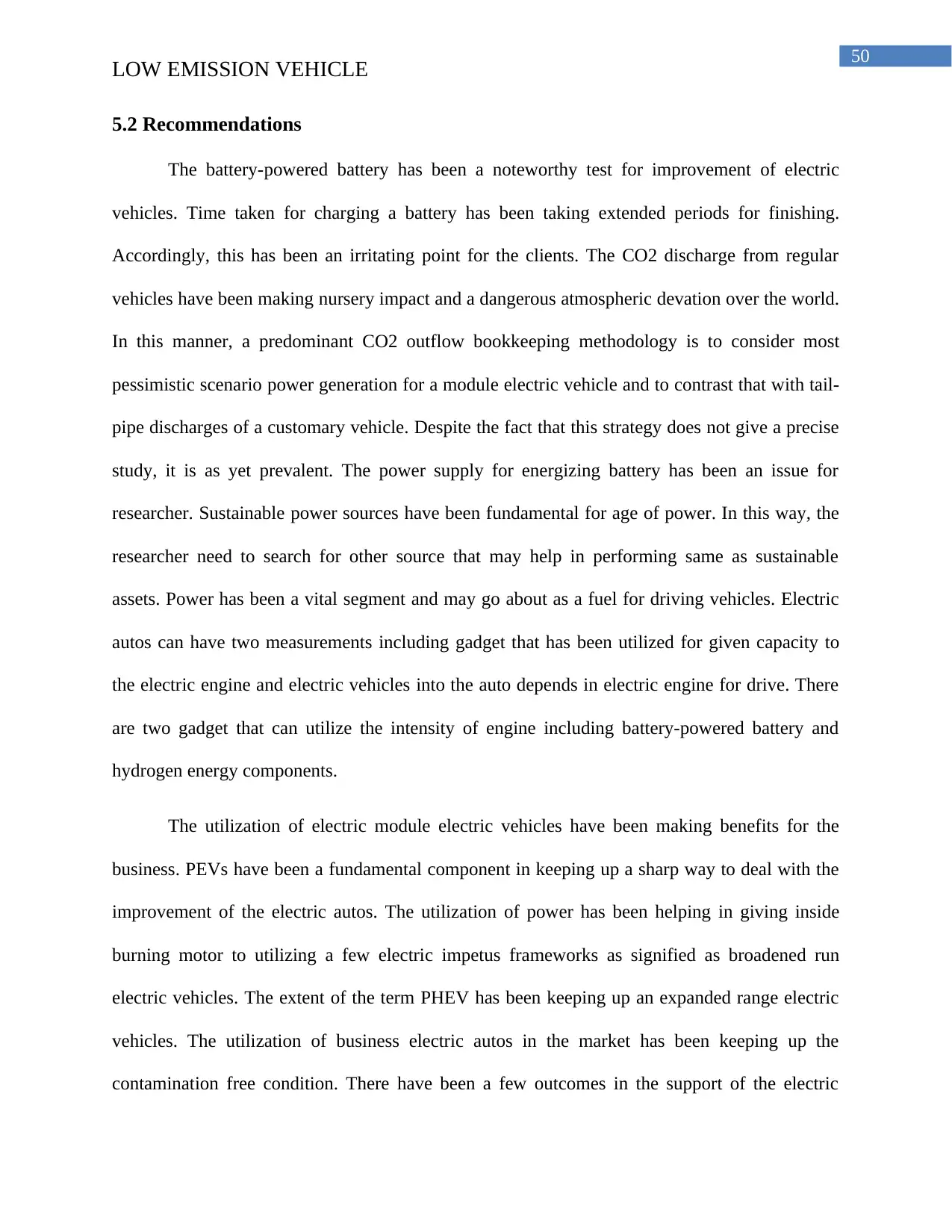
50
LOW EMISSION VEHICLE
5.2 Recommendations
The battery-powered battery has been a noteworthy test for improvement of electric
vehicles. Time taken for charging a battery has been taking extended periods for finishing.
Accordingly, this has been an irritating point for the clients. The CO2 discharge from regular
vehicles have been making nursery impact and a dangerous atmospheric devation over the world.
In this manner, a predominant CO2 outflow bookkeeping methodology is to consider most
pessimistic scenario power generation for a module electric vehicle and to contrast that with tail-
pipe discharges of a customary vehicle. Despite the fact that this strategy does not give a precise
study, it is as yet prevalent. The power supply for energizing battery has been an issue for
researcher. Sustainable power sources have been fundamental for age of power. In this way, the
researcher need to search for other source that may help in performing same as sustainable
assets. Power has been a vital segment and may go about as a fuel for driving vehicles. Electric
autos can have two measurements including gadget that has been utilized for given capacity to
the electric engine and electric vehicles into the auto depends in electric engine for drive. There
are two gadget that can utilize the intensity of engine including battery-powered battery and
hydrogen energy components.
The utilization of electric module electric vehicles have been making benefits for the
business. PEVs have been a fundamental component in keeping up a sharp way to deal with the
improvement of the electric autos. The utilization of power has been helping in giving inside
burning motor to utilizing a few electric impetus frameworks as signified as broadened run
electric vehicles. The extent of the term PHEV has been keeping up an expanded range electric
vehicles. The utilization of business electric autos in the market has been keeping up the
contamination free condition. There have been a few outcomes in the support of the electric
LOW EMISSION VEHICLE
5.2 Recommendations
The battery-powered battery has been a noteworthy test for improvement of electric
vehicles. Time taken for charging a battery has been taking extended periods for finishing.
Accordingly, this has been an irritating point for the clients. The CO2 discharge from regular
vehicles have been making nursery impact and a dangerous atmospheric devation over the world.
In this manner, a predominant CO2 outflow bookkeeping methodology is to consider most
pessimistic scenario power generation for a module electric vehicle and to contrast that with tail-
pipe discharges of a customary vehicle. Despite the fact that this strategy does not give a precise
study, it is as yet prevalent. The power supply for energizing battery has been an issue for
researcher. Sustainable power sources have been fundamental for age of power. In this way, the
researcher need to search for other source that may help in performing same as sustainable
assets. Power has been a vital segment and may go about as a fuel for driving vehicles. Electric
autos can have two measurements including gadget that has been utilized for given capacity to
the electric engine and electric vehicles into the auto depends in electric engine for drive. There
are two gadget that can utilize the intensity of engine including battery-powered battery and
hydrogen energy components.
The utilization of electric module electric vehicles have been making benefits for the
business. PEVs have been a fundamental component in keeping up a sharp way to deal with the
improvement of the electric autos. The utilization of power has been helping in giving inside
burning motor to utilizing a few electric impetus frameworks as signified as broadened run
electric vehicles. The extent of the term PHEV has been keeping up an expanded range electric
vehicles. The utilization of business electric autos in the market has been keeping up the
contamination free condition. There have been a few outcomes in the support of the electric

51
LOW EMISSION VEHICLE
autos. It requires high charge for energizing the battery of the auto for running long over the
street.
LOW EMISSION VEHICLE
autos. It requires high charge for energizing the battery of the auto for running long over the
street.
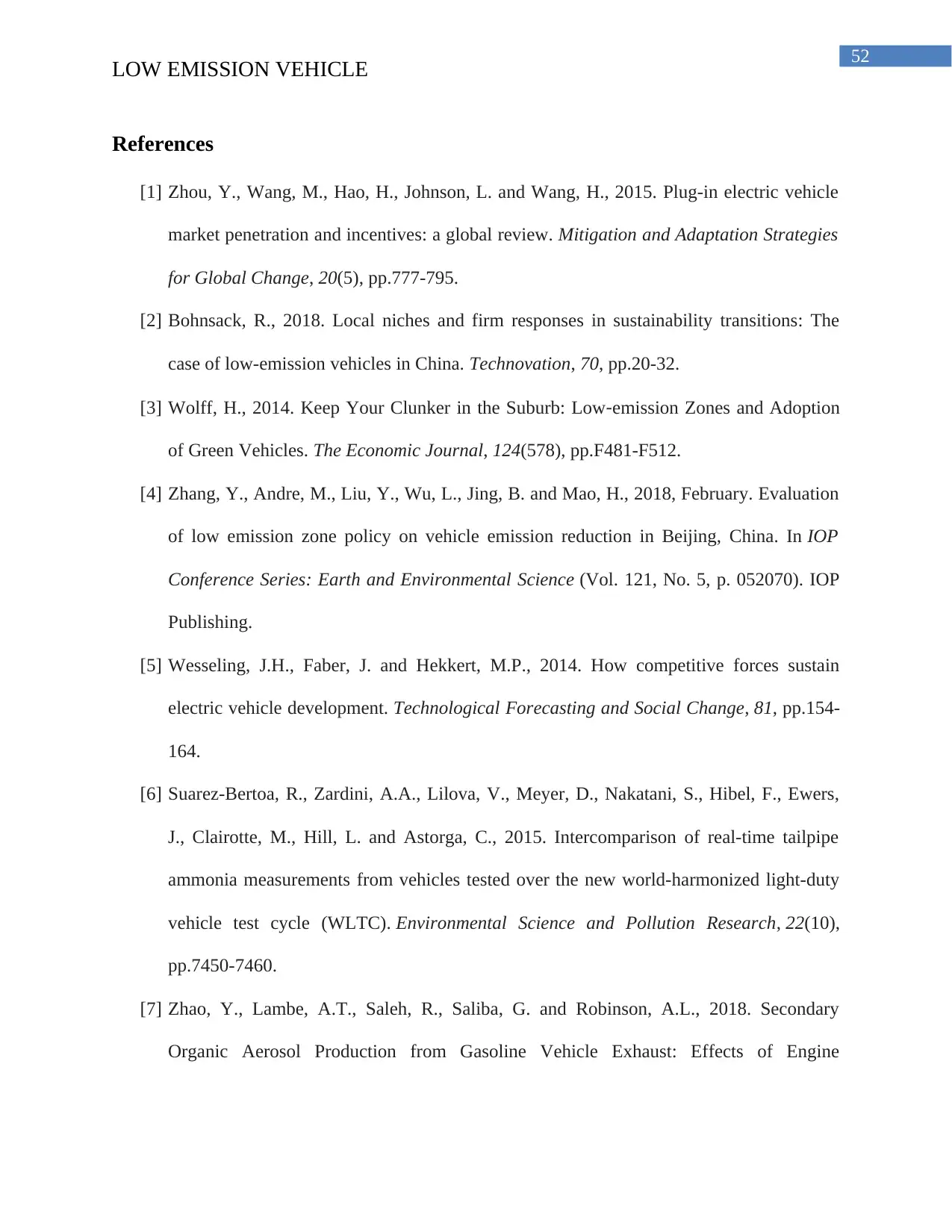
52
LOW EMISSION VEHICLE
References
[1] Zhou, Y., Wang, M., Hao, H., Johnson, L. and Wang, H., 2015. Plug-in electric vehicle
market penetration and incentives: a global review. Mitigation and Adaptation Strategies
for Global Change, 20(5), pp.777-795.
[2] Bohnsack, R., 2018. Local niches and firm responses in sustainability transitions: The
case of low-emission vehicles in China. Technovation, 70, pp.20-32.
[3] Wolff, H., 2014. Keep Your Clunker in the Suburb: Low‐emission Zones and Adoption
of Green Vehicles. The Economic Journal, 124(578), pp.F481-F512.
[4] Zhang, Y., Andre, M., Liu, Y., Wu, L., Jing, B. and Mao, H., 2018, February. Evaluation
of low emission zone policy on vehicle emission reduction in Beijing, China. In IOP
Conference Series: Earth and Environmental Science (Vol. 121, No. 5, p. 052070). IOP
Publishing.
[5] Wesseling, J.H., Faber, J. and Hekkert, M.P., 2014. How competitive forces sustain
electric vehicle development. Technological Forecasting and Social Change, 81, pp.154-
164.
[6] Suarez-Bertoa, R., Zardini, A.A., Lilova, V., Meyer, D., Nakatani, S., Hibel, F., Ewers,
J., Clairotte, M., Hill, L. and Astorga, C., 2015. Intercomparison of real-time tailpipe
ammonia measurements from vehicles tested over the new world-harmonized light-duty
vehicle test cycle (WLTC). Environmental Science and Pollution Research, 22(10),
pp.7450-7460.
[7] Zhao, Y., Lambe, A.T., Saleh, R., Saliba, G. and Robinson, A.L., 2018. Secondary
Organic Aerosol Production from Gasoline Vehicle Exhaust: Effects of Engine
LOW EMISSION VEHICLE
References
[1] Zhou, Y., Wang, M., Hao, H., Johnson, L. and Wang, H., 2015. Plug-in electric vehicle
market penetration and incentives: a global review. Mitigation and Adaptation Strategies
for Global Change, 20(5), pp.777-795.
[2] Bohnsack, R., 2018. Local niches and firm responses in sustainability transitions: The
case of low-emission vehicles in China. Technovation, 70, pp.20-32.
[3] Wolff, H., 2014. Keep Your Clunker in the Suburb: Low‐emission Zones and Adoption
of Green Vehicles. The Economic Journal, 124(578), pp.F481-F512.
[4] Zhang, Y., Andre, M., Liu, Y., Wu, L., Jing, B. and Mao, H., 2018, February. Evaluation
of low emission zone policy on vehicle emission reduction in Beijing, China. In IOP
Conference Series: Earth and Environmental Science (Vol. 121, No. 5, p. 052070). IOP
Publishing.
[5] Wesseling, J.H., Faber, J. and Hekkert, M.P., 2014. How competitive forces sustain
electric vehicle development. Technological Forecasting and Social Change, 81, pp.154-
164.
[6] Suarez-Bertoa, R., Zardini, A.A., Lilova, V., Meyer, D., Nakatani, S., Hibel, F., Ewers,
J., Clairotte, M., Hill, L. and Astorga, C., 2015. Intercomparison of real-time tailpipe
ammonia measurements from vehicles tested over the new world-harmonized light-duty
vehicle test cycle (WLTC). Environmental Science and Pollution Research, 22(10),
pp.7450-7460.
[7] Zhao, Y., Lambe, A.T., Saleh, R., Saliba, G. and Robinson, A.L., 2018. Secondary
Organic Aerosol Production from Gasoline Vehicle Exhaust: Effects of Engine
Secure Best Marks with AI Grader
Need help grading? Try our AI Grader for instant feedback on your assignments.
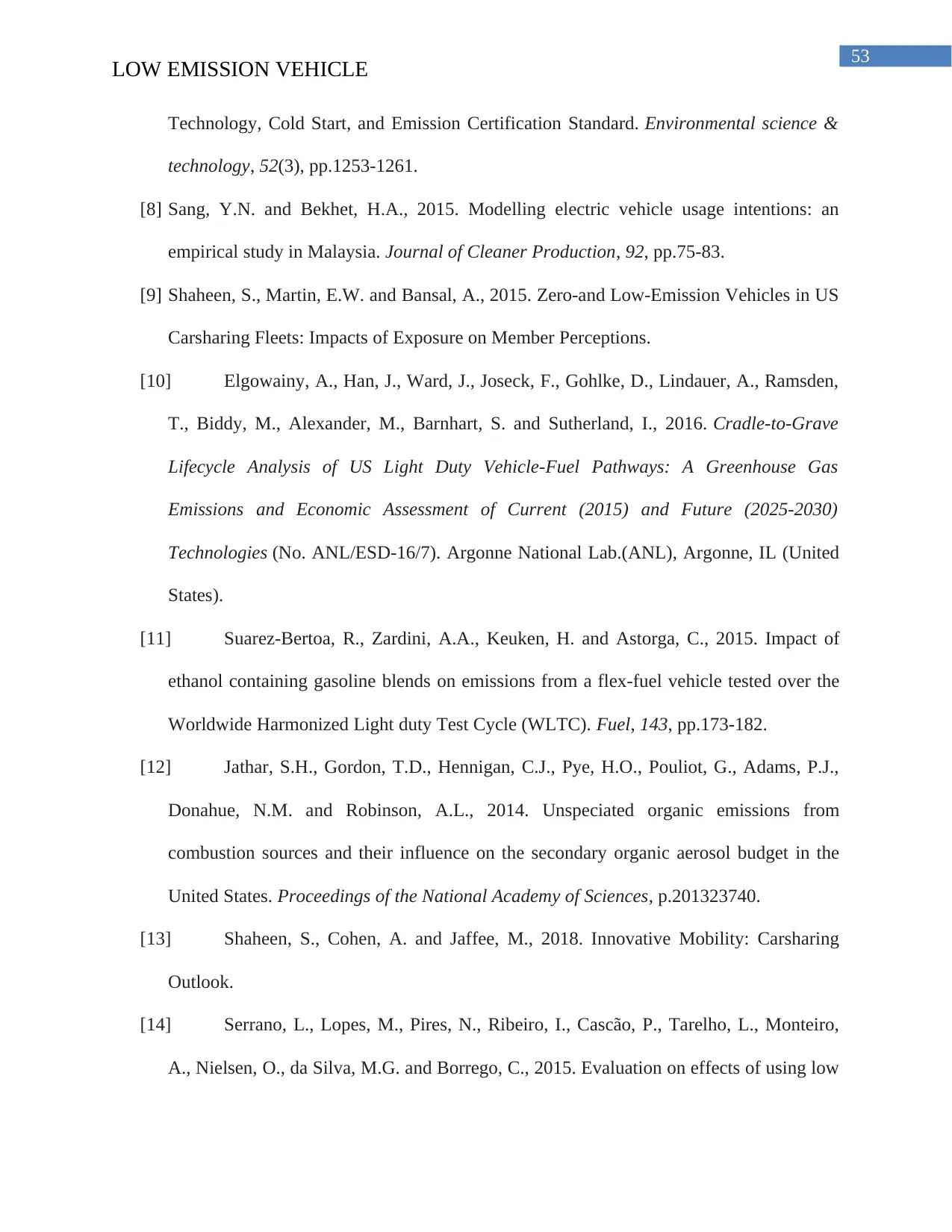
53
LOW EMISSION VEHICLE
Technology, Cold Start, and Emission Certification Standard. Environmental science &
technology, 52(3), pp.1253-1261.
[8] Sang, Y.N. and Bekhet, H.A., 2015. Modelling electric vehicle usage intentions: an
empirical study in Malaysia. Journal of Cleaner Production, 92, pp.75-83.
[9] Shaheen, S., Martin, E.W. and Bansal, A., 2015. Zero-and Low-Emission Vehicles in US
Carsharing Fleets: Impacts of Exposure on Member Perceptions.
[10] Elgowainy, A., Han, J., Ward, J., Joseck, F., Gohlke, D., Lindauer, A., Ramsden,
T., Biddy, M., Alexander, M., Barnhart, S. and Sutherland, I., 2016. Cradle-to-Grave
Lifecycle Analysis of US Light Duty Vehicle-Fuel Pathways: A Greenhouse Gas
Emissions and Economic Assessment of Current (2015) and Future (2025-2030)
Technologies (No. ANL/ESD-16/7). Argonne National Lab.(ANL), Argonne, IL (United
States).
[11] Suarez-Bertoa, R., Zardini, A.A., Keuken, H. and Astorga, C., 2015. Impact of
ethanol containing gasoline blends on emissions from a flex-fuel vehicle tested over the
Worldwide Harmonized Light duty Test Cycle (WLTC). Fuel, 143, pp.173-182.
[12] Jathar, S.H., Gordon, T.D., Hennigan, C.J., Pye, H.O., Pouliot, G., Adams, P.J.,
Donahue, N.M. and Robinson, A.L., 2014. Unspeciated organic emissions from
combustion sources and their influence on the secondary organic aerosol budget in the
United States. Proceedings of the National Academy of Sciences, p.201323740.
[13] Shaheen, S., Cohen, A. and Jaffee, M., 2018. Innovative Mobility: Carsharing
Outlook.
[14] Serrano, L., Lopes, M., Pires, N., Ribeiro, I., Cascão, P., Tarelho, L., Monteiro,
A., Nielsen, O., da Silva, M.G. and Borrego, C., 2015. Evaluation on effects of using low
LOW EMISSION VEHICLE
Technology, Cold Start, and Emission Certification Standard. Environmental science &
technology, 52(3), pp.1253-1261.
[8] Sang, Y.N. and Bekhet, H.A., 2015. Modelling electric vehicle usage intentions: an
empirical study in Malaysia. Journal of Cleaner Production, 92, pp.75-83.
[9] Shaheen, S., Martin, E.W. and Bansal, A., 2015. Zero-and Low-Emission Vehicles in US
Carsharing Fleets: Impacts of Exposure on Member Perceptions.
[10] Elgowainy, A., Han, J., Ward, J., Joseck, F., Gohlke, D., Lindauer, A., Ramsden,
T., Biddy, M., Alexander, M., Barnhart, S. and Sutherland, I., 2016. Cradle-to-Grave
Lifecycle Analysis of US Light Duty Vehicle-Fuel Pathways: A Greenhouse Gas
Emissions and Economic Assessment of Current (2015) and Future (2025-2030)
Technologies (No. ANL/ESD-16/7). Argonne National Lab.(ANL), Argonne, IL (United
States).
[11] Suarez-Bertoa, R., Zardini, A.A., Keuken, H. and Astorga, C., 2015. Impact of
ethanol containing gasoline blends on emissions from a flex-fuel vehicle tested over the
Worldwide Harmonized Light duty Test Cycle (WLTC). Fuel, 143, pp.173-182.
[12] Jathar, S.H., Gordon, T.D., Hennigan, C.J., Pye, H.O., Pouliot, G., Adams, P.J.,
Donahue, N.M. and Robinson, A.L., 2014. Unspeciated organic emissions from
combustion sources and their influence on the secondary organic aerosol budget in the
United States. Proceedings of the National Academy of Sciences, p.201323740.
[13] Shaheen, S., Cohen, A. and Jaffee, M., 2018. Innovative Mobility: Carsharing
Outlook.
[14] Serrano, L., Lopes, M., Pires, N., Ribeiro, I., Cascão, P., Tarelho, L., Monteiro,
A., Nielsen, O., da Silva, M.G. and Borrego, C., 2015. Evaluation on effects of using low
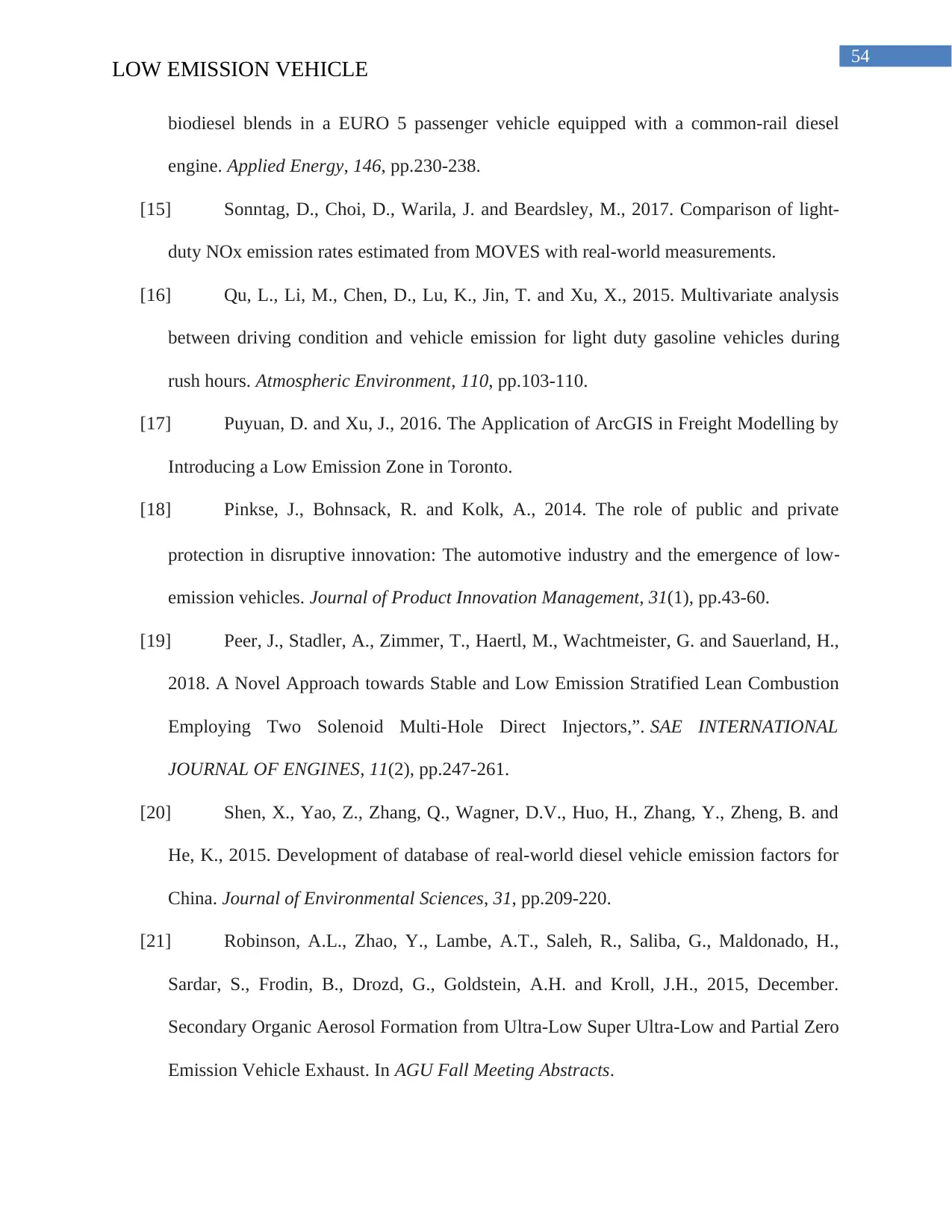
54
LOW EMISSION VEHICLE
biodiesel blends in a EURO 5 passenger vehicle equipped with a common-rail diesel
engine. Applied Energy, 146, pp.230-238.
[15] Sonntag, D., Choi, D., Warila, J. and Beardsley, M., 2017. Comparison of light-
duty NOx emission rates estimated from MOVES with real-world measurements.
[16] Qu, L., Li, M., Chen, D., Lu, K., Jin, T. and Xu, X., 2015. Multivariate analysis
between driving condition and vehicle emission for light duty gasoline vehicles during
rush hours. Atmospheric Environment, 110, pp.103-110.
[17] Puyuan, D. and Xu, J., 2016. The Application of ArcGIS in Freight Modelling by
Introducing a Low Emission Zone in Toronto.
[18] Pinkse, J., Bohnsack, R. and Kolk, A., 2014. The role of public and private
protection in disruptive innovation: The automotive industry and the emergence of low‐
emission vehicles. Journal of Product Innovation Management, 31(1), pp.43-60.
[19] Peer, J., Stadler, A., Zimmer, T., Haertl, M., Wachtmeister, G. and Sauerland, H.,
2018. A Novel Approach towards Stable and Low Emission Stratified Lean Combustion
Employing Two Solenoid Multi-Hole Direct Injectors,”. SAE INTERNATIONAL
JOURNAL OF ENGINES, 11(2), pp.247-261.
[20] Shen, X., Yao, Z., Zhang, Q., Wagner, D.V., Huo, H., Zhang, Y., Zheng, B. and
He, K., 2015. Development of database of real-world diesel vehicle emission factors for
China. Journal of Environmental Sciences, 31, pp.209-220.
[21] Robinson, A.L., Zhao, Y., Lambe, A.T., Saleh, R., Saliba, G., Maldonado, H.,
Sardar, S., Frodin, B., Drozd, G., Goldstein, A.H. and Kroll, J.H., 2015, December.
Secondary Organic Aerosol Formation from Ultra-Low Super Ultra-Low and Partial Zero
Emission Vehicle Exhaust. In AGU Fall Meeting Abstracts.
LOW EMISSION VEHICLE
biodiesel blends in a EURO 5 passenger vehicle equipped with a common-rail diesel
engine. Applied Energy, 146, pp.230-238.
[15] Sonntag, D., Choi, D., Warila, J. and Beardsley, M., 2017. Comparison of light-
duty NOx emission rates estimated from MOVES with real-world measurements.
[16] Qu, L., Li, M., Chen, D., Lu, K., Jin, T. and Xu, X., 2015. Multivariate analysis
between driving condition and vehicle emission for light duty gasoline vehicles during
rush hours. Atmospheric Environment, 110, pp.103-110.
[17] Puyuan, D. and Xu, J., 2016. The Application of ArcGIS in Freight Modelling by
Introducing a Low Emission Zone in Toronto.
[18] Pinkse, J., Bohnsack, R. and Kolk, A., 2014. The role of public and private
protection in disruptive innovation: The automotive industry and the emergence of low‐
emission vehicles. Journal of Product Innovation Management, 31(1), pp.43-60.
[19] Peer, J., Stadler, A., Zimmer, T., Haertl, M., Wachtmeister, G. and Sauerland, H.,
2018. A Novel Approach towards Stable and Low Emission Stratified Lean Combustion
Employing Two Solenoid Multi-Hole Direct Injectors,”. SAE INTERNATIONAL
JOURNAL OF ENGINES, 11(2), pp.247-261.
[20] Shen, X., Yao, Z., Zhang, Q., Wagner, D.V., Huo, H., Zhang, Y., Zheng, B. and
He, K., 2015. Development of database of real-world diesel vehicle emission factors for
China. Journal of Environmental Sciences, 31, pp.209-220.
[21] Robinson, A.L., Zhao, Y., Lambe, A.T., Saleh, R., Saliba, G., Maldonado, H.,
Sardar, S., Frodin, B., Drozd, G., Goldstein, A.H. and Kroll, J.H., 2015, December.
Secondary Organic Aerosol Formation from Ultra-Low Super Ultra-Low and Partial Zero
Emission Vehicle Exhaust. In AGU Fall Meeting Abstracts.
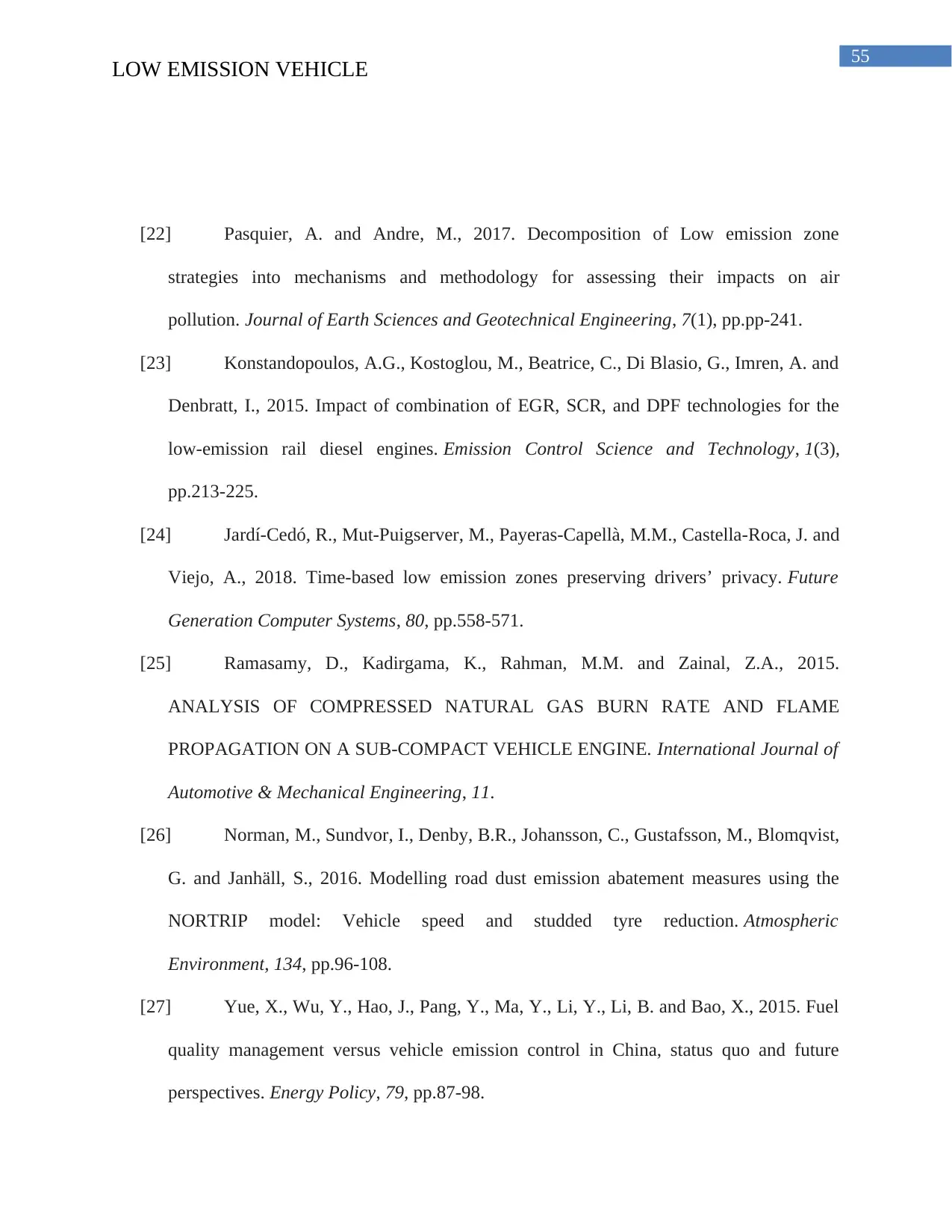
55
LOW EMISSION VEHICLE
[22] Pasquier, A. and Andre, M., 2017. Decomposition of Low emission zone
strategies into mechanisms and methodology for assessing their impacts on air
pollution. Journal of Earth Sciences and Geotechnical Engineering, 7(1), pp.pp-241.
[23] Konstandopoulos, A.G., Kostoglou, M., Beatrice, C., Di Blasio, G., Imren, A. and
Denbratt, I., 2015. Impact of combination of EGR, SCR, and DPF technologies for the
low-emission rail diesel engines. Emission Control Science and Technology, 1(3),
pp.213-225.
[24] Jardí-Cedó, R., Mut-Puigserver, M., Payeras-Capellà, M.M., Castella-Roca, J. and
Viejo, A., 2018. Time-based low emission zones preserving drivers’ privacy. Future
Generation Computer Systems, 80, pp.558-571.
[25] Ramasamy, D., Kadirgama, K., Rahman, M.M. and Zainal, Z.A., 2015.
ANALYSIS OF COMPRESSED NATURAL GAS BURN RATE AND FLAME
PROPAGATION ON A SUB-COMPACT VEHICLE ENGINE. International Journal of
Automotive & Mechanical Engineering, 11.
[26] Norman, M., Sundvor, I., Denby, B.R., Johansson, C., Gustafsson, M., Blomqvist,
G. and Janhäll, S., 2016. Modelling road dust emission abatement measures using the
NORTRIP model: Vehicle speed and studded tyre reduction. Atmospheric
Environment, 134, pp.96-108.
[27] Yue, X., Wu, Y., Hao, J., Pang, Y., Ma, Y., Li, Y., Li, B. and Bao, X., 2015. Fuel
quality management versus vehicle emission control in China, status quo and future
perspectives. Energy Policy, 79, pp.87-98.
LOW EMISSION VEHICLE
[22] Pasquier, A. and Andre, M., 2017. Decomposition of Low emission zone
strategies into mechanisms and methodology for assessing their impacts on air
pollution. Journal of Earth Sciences and Geotechnical Engineering, 7(1), pp.pp-241.
[23] Konstandopoulos, A.G., Kostoglou, M., Beatrice, C., Di Blasio, G., Imren, A. and
Denbratt, I., 2015. Impact of combination of EGR, SCR, and DPF technologies for the
low-emission rail diesel engines. Emission Control Science and Technology, 1(3),
pp.213-225.
[24] Jardí-Cedó, R., Mut-Puigserver, M., Payeras-Capellà, M.M., Castella-Roca, J. and
Viejo, A., 2018. Time-based low emission zones preserving drivers’ privacy. Future
Generation Computer Systems, 80, pp.558-571.
[25] Ramasamy, D., Kadirgama, K., Rahman, M.M. and Zainal, Z.A., 2015.
ANALYSIS OF COMPRESSED NATURAL GAS BURN RATE AND FLAME
PROPAGATION ON A SUB-COMPACT VEHICLE ENGINE. International Journal of
Automotive & Mechanical Engineering, 11.
[26] Norman, M., Sundvor, I., Denby, B.R., Johansson, C., Gustafsson, M., Blomqvist,
G. and Janhäll, S., 2016. Modelling road dust emission abatement measures using the
NORTRIP model: Vehicle speed and studded tyre reduction. Atmospheric
Environment, 134, pp.96-108.
[27] Yue, X., Wu, Y., Hao, J., Pang, Y., Ma, Y., Li, Y., Li, B. and Bao, X., 2015. Fuel
quality management versus vehicle emission control in China, status quo and future
perspectives. Energy Policy, 79, pp.87-98.
Paraphrase This Document
Need a fresh take? Get an instant paraphrase of this document with our AI Paraphraser
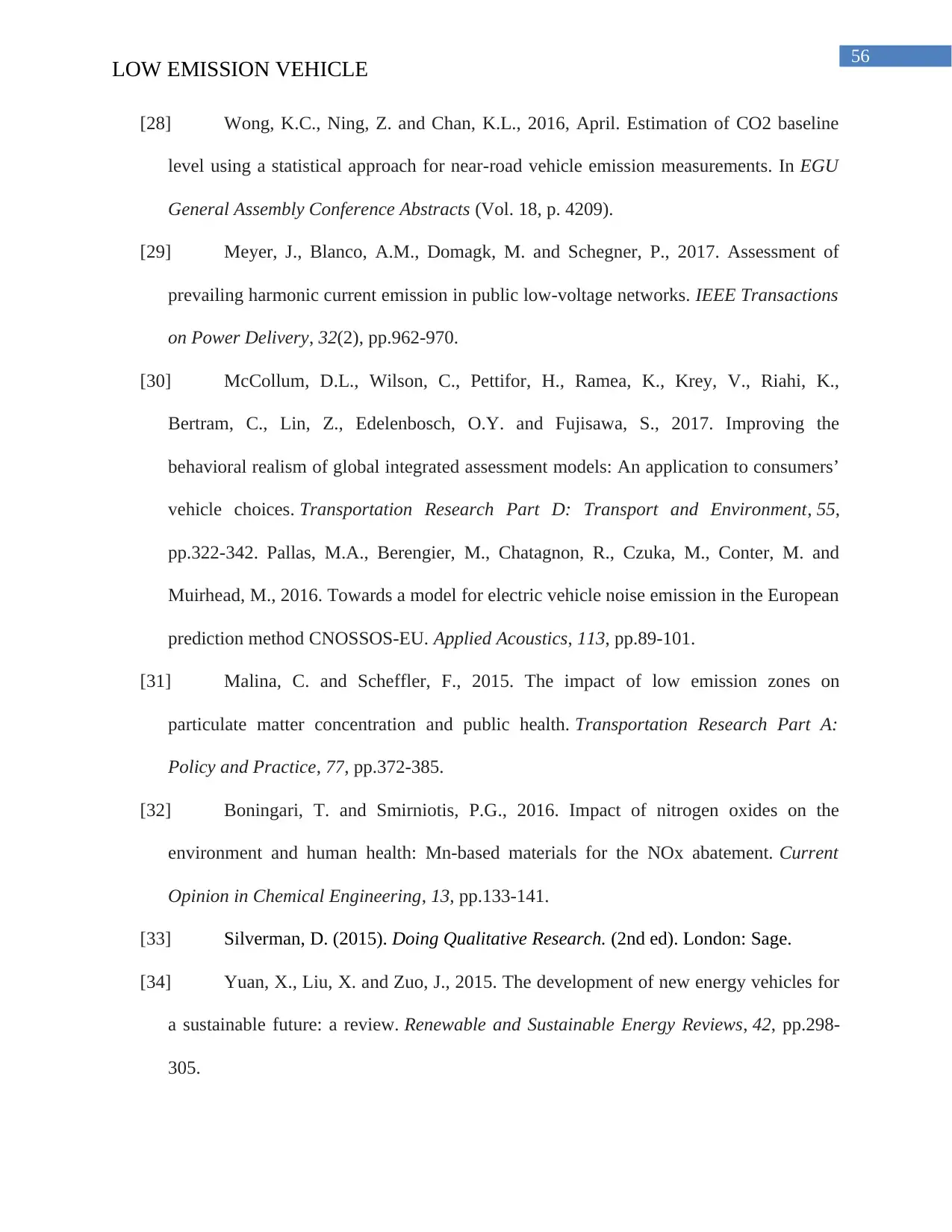
56
LOW EMISSION VEHICLE
[28] Wong, K.C., Ning, Z. and Chan, K.L., 2016, April. Estimation of CO2 baseline
level using a statistical approach for near-road vehicle emission measurements. In EGU
General Assembly Conference Abstracts (Vol. 18, p. 4209).
[29] Meyer, J., Blanco, A.M., Domagk, M. and Schegner, P., 2017. Assessment of
prevailing harmonic current emission in public low-voltage networks. IEEE Transactions
on Power Delivery, 32(2), pp.962-970.
[30] McCollum, D.L., Wilson, C., Pettifor, H., Ramea, K., Krey, V., Riahi, K.,
Bertram, C., Lin, Z., Edelenbosch, O.Y. and Fujisawa, S., 2017. Improving the
behavioral realism of global integrated assessment models: An application to consumers’
vehicle choices. Transportation Research Part D: Transport and Environment, 55,
pp.322-342. Pallas, M.A., Berengier, M., Chatagnon, R., Czuka, M., Conter, M. and
Muirhead, M., 2016. Towards a model for electric vehicle noise emission in the European
prediction method CNOSSOS-EU. Applied Acoustics, 113, pp.89-101.
[31] Malina, C. and Scheffler, F., 2015. The impact of low emission zones on
particulate matter concentration and public health. Transportation Research Part A:
Policy and Practice, 77, pp.372-385.
[32] Boningari, T. and Smirniotis, P.G., 2016. Impact of nitrogen oxides on the
environment and human health: Mn-based materials for the NOx abatement. Current
Opinion in Chemical Engineering, 13, pp.133-141.
[33] Silverman, D. (2015). Doing Qualitative Research. (2nd ed). London: Sage.
[34] Yuan, X., Liu, X. and Zuo, J., 2015. The development of new energy vehicles for
a sustainable future: a review. Renewable and Sustainable Energy Reviews, 42, pp.298-
305.
LOW EMISSION VEHICLE
[28] Wong, K.C., Ning, Z. and Chan, K.L., 2016, April. Estimation of CO2 baseline
level using a statistical approach for near-road vehicle emission measurements. In EGU
General Assembly Conference Abstracts (Vol. 18, p. 4209).
[29] Meyer, J., Blanco, A.M., Domagk, M. and Schegner, P., 2017. Assessment of
prevailing harmonic current emission in public low-voltage networks. IEEE Transactions
on Power Delivery, 32(2), pp.962-970.
[30] McCollum, D.L., Wilson, C., Pettifor, H., Ramea, K., Krey, V., Riahi, K.,
Bertram, C., Lin, Z., Edelenbosch, O.Y. and Fujisawa, S., 2017. Improving the
behavioral realism of global integrated assessment models: An application to consumers’
vehicle choices. Transportation Research Part D: Transport and Environment, 55,
pp.322-342. Pallas, M.A., Berengier, M., Chatagnon, R., Czuka, M., Conter, M. and
Muirhead, M., 2016. Towards a model for electric vehicle noise emission in the European
prediction method CNOSSOS-EU. Applied Acoustics, 113, pp.89-101.
[31] Malina, C. and Scheffler, F., 2015. The impact of low emission zones on
particulate matter concentration and public health. Transportation Research Part A:
Policy and Practice, 77, pp.372-385.
[32] Boningari, T. and Smirniotis, P.G., 2016. Impact of nitrogen oxides on the
environment and human health: Mn-based materials for the NOx abatement. Current
Opinion in Chemical Engineering, 13, pp.133-141.
[33] Silverman, D. (2015). Doing Qualitative Research. (2nd ed). London: Sage.
[34] Yuan, X., Liu, X. and Zuo, J., 2015. The development of new energy vehicles for
a sustainable future: a review. Renewable and Sustainable Energy Reviews, 42, pp.298-
305.
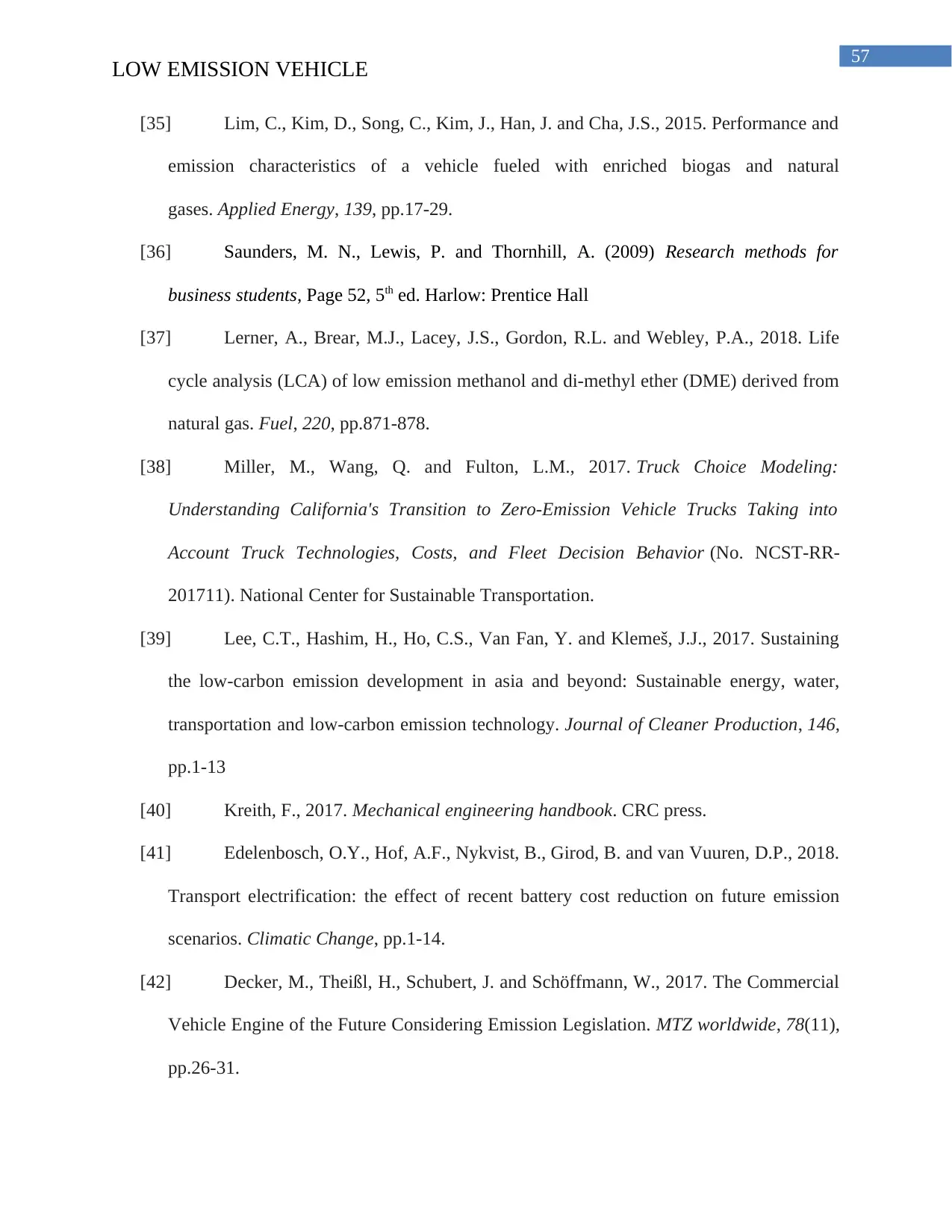
57
LOW EMISSION VEHICLE
[35] Lim, C., Kim, D., Song, C., Kim, J., Han, J. and Cha, J.S., 2015. Performance and
emission characteristics of a vehicle fueled with enriched biogas and natural
gases. Applied Energy, 139, pp.17-29.
[36] Saunders, M. N., Lewis, P. and Thornhill, A. (2009) Research methods for
business students, Page 52, 5th ed. Harlow: Prentice Hall
[37] Lerner, A., Brear, M.J., Lacey, J.S., Gordon, R.L. and Webley, P.A., 2018. Life
cycle analysis (LCA) of low emission methanol and di-methyl ether (DME) derived from
natural gas. Fuel, 220, pp.871-878.
[38] Miller, M., Wang, Q. and Fulton, L.M., 2017. Truck Choice Modeling:
Understanding California's Transition to Zero-Emission Vehicle Trucks Taking into
Account Truck Technologies, Costs, and Fleet Decision Behavior (No. NCST-RR-
201711). National Center for Sustainable Transportation.
[39] Lee, C.T., Hashim, H., Ho, C.S., Van Fan, Y. and Klemeš, J.J., 2017. Sustaining
the low-carbon emission development in asia and beyond: Sustainable energy, water,
transportation and low-carbon emission technology. Journal of Cleaner Production, 146,
pp.1-13
[40] Kreith, F., 2017. Mechanical engineering handbook. CRC press.
[41] Edelenbosch, O.Y., Hof, A.F., Nykvist, B., Girod, B. and van Vuuren, D.P., 2018.
Transport electrification: the effect of recent battery cost reduction on future emission
scenarios. Climatic Change, pp.1-14.
[42] Decker, M., Theißl, H., Schubert, J. and Schöffmann, W., 2017. The Commercial
Vehicle Engine of the Future Considering Emission Legislation. MTZ worldwide, 78(11),
pp.26-31.
LOW EMISSION VEHICLE
[35] Lim, C., Kim, D., Song, C., Kim, J., Han, J. and Cha, J.S., 2015. Performance and
emission characteristics of a vehicle fueled with enriched biogas and natural
gases. Applied Energy, 139, pp.17-29.
[36] Saunders, M. N., Lewis, P. and Thornhill, A. (2009) Research methods for
business students, Page 52, 5th ed. Harlow: Prentice Hall
[37] Lerner, A., Brear, M.J., Lacey, J.S., Gordon, R.L. and Webley, P.A., 2018. Life
cycle analysis (LCA) of low emission methanol and di-methyl ether (DME) derived from
natural gas. Fuel, 220, pp.871-878.
[38] Miller, M., Wang, Q. and Fulton, L.M., 2017. Truck Choice Modeling:
Understanding California's Transition to Zero-Emission Vehicle Trucks Taking into
Account Truck Technologies, Costs, and Fleet Decision Behavior (No. NCST-RR-
201711). National Center for Sustainable Transportation.
[39] Lee, C.T., Hashim, H., Ho, C.S., Van Fan, Y. and Klemeš, J.J., 2017. Sustaining
the low-carbon emission development in asia and beyond: Sustainable energy, water,
transportation and low-carbon emission technology. Journal of Cleaner Production, 146,
pp.1-13
[40] Kreith, F., 2017. Mechanical engineering handbook. CRC press.
[41] Edelenbosch, O.Y., Hof, A.F., Nykvist, B., Girod, B. and van Vuuren, D.P., 2018.
Transport electrification: the effect of recent battery cost reduction on future emission
scenarios. Climatic Change, pp.1-14.
[42] Decker, M., Theißl, H., Schubert, J. and Schöffmann, W., 2017. The Commercial
Vehicle Engine of the Future Considering Emission Legislation. MTZ worldwide, 78(11),
pp.26-31.
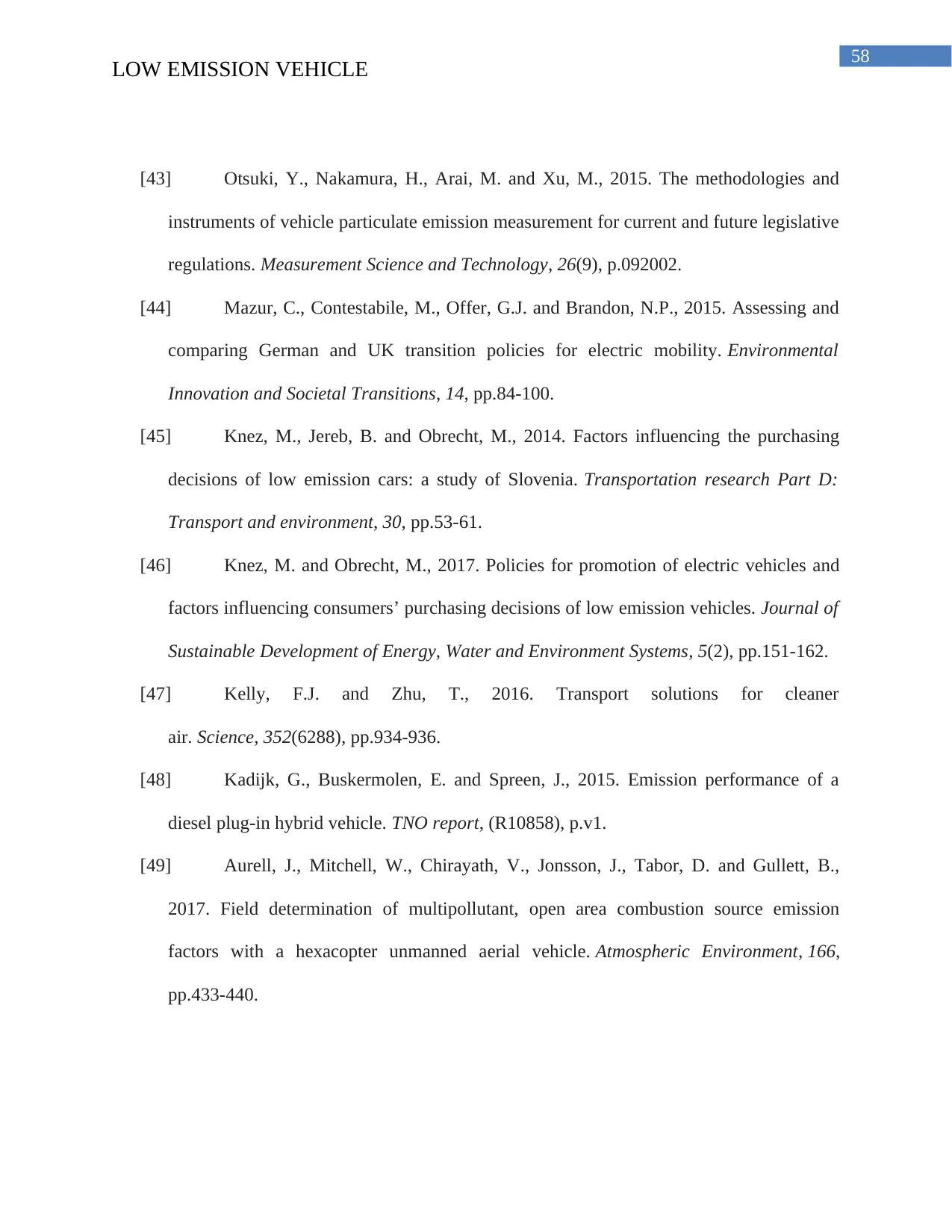
58
LOW EMISSION VEHICLE
[43] Otsuki, Y., Nakamura, H., Arai, M. and Xu, M., 2015. The methodologies and
instruments of vehicle particulate emission measurement for current and future legislative
regulations. Measurement Science and Technology, 26(9), p.092002.
[44] Mazur, C., Contestabile, M., Offer, G.J. and Brandon, N.P., 2015. Assessing and
comparing German and UK transition policies for electric mobility. Environmental
Innovation and Societal Transitions, 14, pp.84-100.
[45] Knez, M., Jereb, B. and Obrecht, M., 2014. Factors influencing the purchasing
decisions of low emission cars: a study of Slovenia. Transportation research Part D:
Transport and environment, 30, pp.53-61.
[46] Knez, M. and Obrecht, M., 2017. Policies for promotion of electric vehicles and
factors influencing consumers’ purchasing decisions of low emission vehicles. Journal of
Sustainable Development of Energy, Water and Environment Systems, 5(2), pp.151-162.
[47] Kelly, F.J. and Zhu, T., 2016. Transport solutions for cleaner
air. Science, 352(6288), pp.934-936.
[48] Kadijk, G., Buskermolen, E. and Spreen, J., 2015. Emission performance of a
diesel plug-in hybrid vehicle. TNO report, (R10858), p.v1.
[49] Aurell, J., Mitchell, W., Chirayath, V., Jonsson, J., Tabor, D. and Gullett, B.,
2017. Field determination of multipollutant, open area combustion source emission
factors with a hexacopter unmanned aerial vehicle. Atmospheric Environment, 166,
pp.433-440.
LOW EMISSION VEHICLE
[43] Otsuki, Y., Nakamura, H., Arai, M. and Xu, M., 2015. The methodologies and
instruments of vehicle particulate emission measurement for current and future legislative
regulations. Measurement Science and Technology, 26(9), p.092002.
[44] Mazur, C., Contestabile, M., Offer, G.J. and Brandon, N.P., 2015. Assessing and
comparing German and UK transition policies for electric mobility. Environmental
Innovation and Societal Transitions, 14, pp.84-100.
[45] Knez, M., Jereb, B. and Obrecht, M., 2014. Factors influencing the purchasing
decisions of low emission cars: a study of Slovenia. Transportation research Part D:
Transport and environment, 30, pp.53-61.
[46] Knez, M. and Obrecht, M., 2017. Policies for promotion of electric vehicles and
factors influencing consumers’ purchasing decisions of low emission vehicles. Journal of
Sustainable Development of Energy, Water and Environment Systems, 5(2), pp.151-162.
[47] Kelly, F.J. and Zhu, T., 2016. Transport solutions for cleaner
air. Science, 352(6288), pp.934-936.
[48] Kadijk, G., Buskermolen, E. and Spreen, J., 2015. Emission performance of a
diesel plug-in hybrid vehicle. TNO report, (R10858), p.v1.
[49] Aurell, J., Mitchell, W., Chirayath, V., Jonsson, J., Tabor, D. and Gullett, B.,
2017. Field determination of multipollutant, open area combustion source emission
factors with a hexacopter unmanned aerial vehicle. Atmospheric Environment, 166,
pp.433-440.
Secure Best Marks with AI Grader
Need help grading? Try our AI Grader for instant feedback on your assignments.
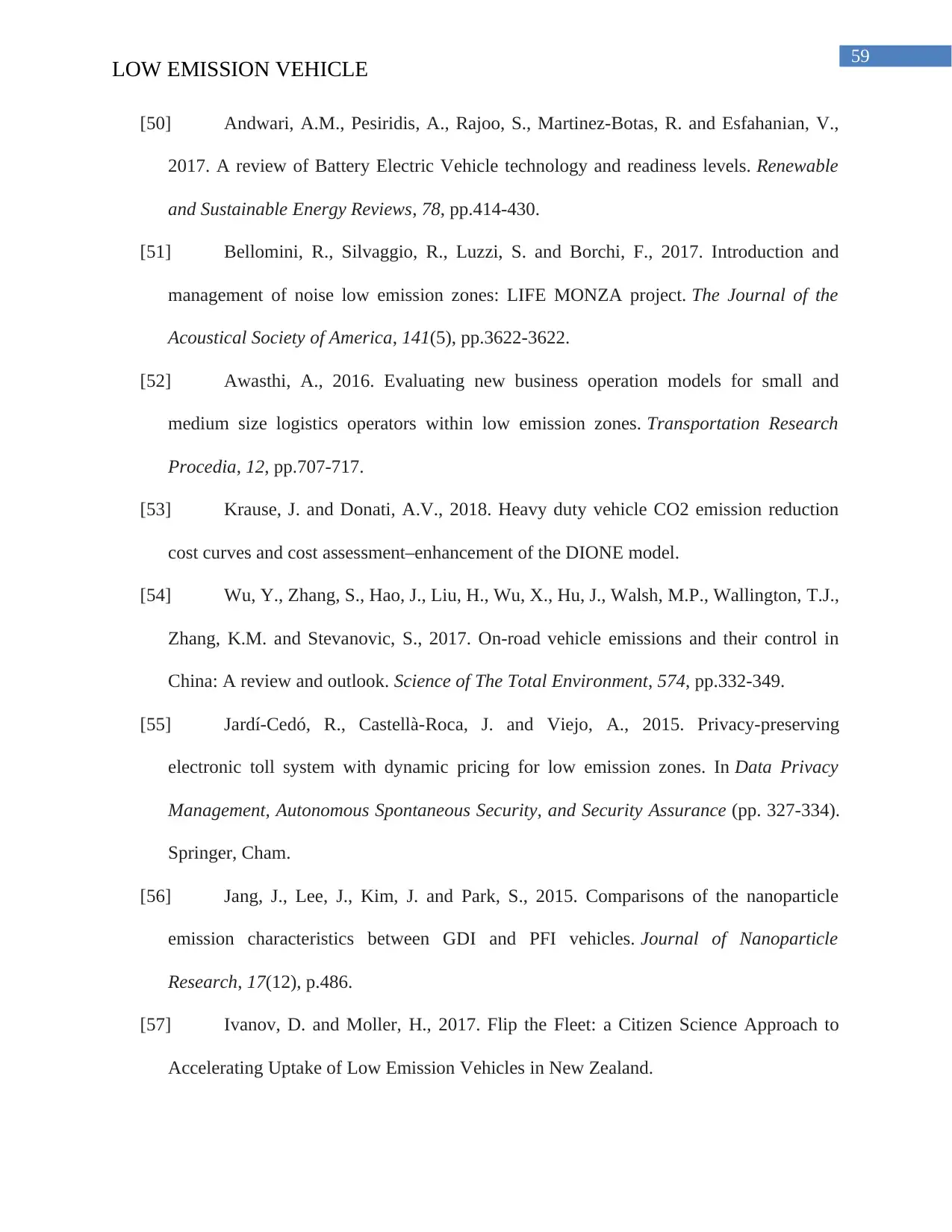
59
LOW EMISSION VEHICLE
[50] Andwari, A.M., Pesiridis, A., Rajoo, S., Martinez-Botas, R. and Esfahanian, V.,
2017. A review of Battery Electric Vehicle technology and readiness levels. Renewable
and Sustainable Energy Reviews, 78, pp.414-430.
[51] Bellomini, R., Silvaggio, R., Luzzi, S. and Borchi, F., 2017. Introduction and
management of noise low emission zones: LIFE MONZA project. The Journal of the
Acoustical Society of America, 141(5), pp.3622-3622.
[52] Awasthi, A., 2016. Evaluating new business operation models for small and
medium size logistics operators within low emission zones. Transportation Research
Procedia, 12, pp.707-717.
[53] Krause, J. and Donati, A.V., 2018. Heavy duty vehicle CO2 emission reduction
cost curves and cost assessment–enhancement of the DIONE model.
[54] Wu, Y., Zhang, S., Hao, J., Liu, H., Wu, X., Hu, J., Walsh, M.P., Wallington, T.J.,
Zhang, K.M. and Stevanovic, S., 2017. On-road vehicle emissions and their control in
China: A review and outlook. Science of The Total Environment, 574, pp.332-349.
[55] Jardí-Cedó, R., Castellà-Roca, J. and Viejo, A., 2015. Privacy-preserving
electronic toll system with dynamic pricing for low emission zones. In Data Privacy
Management, Autonomous Spontaneous Security, and Security Assurance (pp. 327-334).
Springer, Cham.
[56] Jang, J., Lee, J., Kim, J. and Park, S., 2015. Comparisons of the nanoparticle
emission characteristics between GDI and PFI vehicles. Journal of Nanoparticle
Research, 17(12), p.486.
[57] Ivanov, D. and Moller, H., 2017. Flip the Fleet: a Citizen Science Approach to
Accelerating Uptake of Low Emission Vehicles in New Zealand.
LOW EMISSION VEHICLE
[50] Andwari, A.M., Pesiridis, A., Rajoo, S., Martinez-Botas, R. and Esfahanian, V.,
2017. A review of Battery Electric Vehicle technology and readiness levels. Renewable
and Sustainable Energy Reviews, 78, pp.414-430.
[51] Bellomini, R., Silvaggio, R., Luzzi, S. and Borchi, F., 2017. Introduction and
management of noise low emission zones: LIFE MONZA project. The Journal of the
Acoustical Society of America, 141(5), pp.3622-3622.
[52] Awasthi, A., 2016. Evaluating new business operation models for small and
medium size logistics operators within low emission zones. Transportation Research
Procedia, 12, pp.707-717.
[53] Krause, J. and Donati, A.V., 2018. Heavy duty vehicle CO2 emission reduction
cost curves and cost assessment–enhancement of the DIONE model.
[54] Wu, Y., Zhang, S., Hao, J., Liu, H., Wu, X., Hu, J., Walsh, M.P., Wallington, T.J.,
Zhang, K.M. and Stevanovic, S., 2017. On-road vehicle emissions and their control in
China: A review and outlook. Science of The Total Environment, 574, pp.332-349.
[55] Jardí-Cedó, R., Castellà-Roca, J. and Viejo, A., 2015. Privacy-preserving
electronic toll system with dynamic pricing for low emission zones. In Data Privacy
Management, Autonomous Spontaneous Security, and Security Assurance (pp. 327-334).
Springer, Cham.
[56] Jang, J., Lee, J., Kim, J. and Park, S., 2015. Comparisons of the nanoparticle
emission characteristics between GDI and PFI vehicles. Journal of Nanoparticle
Research, 17(12), p.486.
[57] Ivanov, D. and Moller, H., 2017. Flip the Fleet: a Citizen Science Approach to
Accelerating Uptake of Low Emission Vehicles in New Zealand.

60
LOW EMISSION VEHICLE
[58] Ithnin, A.M., Ahmad, M.A., Bakar, M.A.A., Rajoo, S. and Yahya, W.J., 2015.
Combustion performance and emission analysis of diesel engine fuelled with water-in-
diesel emulsion fuel made from low-grade diesel fuel. Energy Conversion and
Management, 90, pp.375-382.
[59] Holman, C., Harrison, R. and Querol, X., 2015. Review of the efficacy of low
emission zones to improve urban air quality in European cities. Atmospheric
Environment, 111, pp.161-169.
[60] Hao, H., Liu, Z., Zhao, F. and Li, W., 2016. Natural gas as vehicle fuel in China:
A review. Renewable and sustainable energy reviews, 62, pp.521-533.
[61] Farrell, J., 2016. Co-Optimization of Fuels and Engines (No. NREL/PR-5400-
66333). National Renewable Energy Lab.(NREL), Golden, CO (United States).
[62] Gentner, D.R., Jathar, S.H., Gordon, T.D., Bahreini, R., Day, D.A., El Haddad, I.,
Hayes, P.L., Pieber, S.M., Platt, S.M., de Gouw, J. and Goldstein, A.H., 2017. Review of
urban secondary organic aerosol formation from gasoline and diesel motor vehicle
emissions. Environmental science & technology, 51(3), pp.1074-1093.
[63] Galvis, B., Bergin, M., Boylan, J., Huang, Y., Bergin, M. and Russell, A.G., 2015.
Air quality impacts and health-benefit valuation of a low-emission technology for rail
yard locomotives in Atlanta Georgia. Science of the Total Environment, 533, pp.156-164.
[64] Fensterer, V., Küchenhoff, H., Maier, V., Wichmann, H.E., Breitner, S., Peters,
A., Gu, J. and Cyrys, J., 2014. Evaluation of the impact of low emission zone and heavy
traffic ban in Munich (Germany) on the reduction of PM10 in ambient air. International
journal of environmental research and public health, 11(5), pp.5094-5112.
LOW EMISSION VEHICLE
[58] Ithnin, A.M., Ahmad, M.A., Bakar, M.A.A., Rajoo, S. and Yahya, W.J., 2015.
Combustion performance and emission analysis of diesel engine fuelled with water-in-
diesel emulsion fuel made from low-grade diesel fuel. Energy Conversion and
Management, 90, pp.375-382.
[59] Holman, C., Harrison, R. and Querol, X., 2015. Review of the efficacy of low
emission zones to improve urban air quality in European cities. Atmospheric
Environment, 111, pp.161-169.
[60] Hao, H., Liu, Z., Zhao, F. and Li, W., 2016. Natural gas as vehicle fuel in China:
A review. Renewable and sustainable energy reviews, 62, pp.521-533.
[61] Farrell, J., 2016. Co-Optimization of Fuels and Engines (No. NREL/PR-5400-
66333). National Renewable Energy Lab.(NREL), Golden, CO (United States).
[62] Gentner, D.R., Jathar, S.H., Gordon, T.D., Bahreini, R., Day, D.A., El Haddad, I.,
Hayes, P.L., Pieber, S.M., Platt, S.M., de Gouw, J. and Goldstein, A.H., 2017. Review of
urban secondary organic aerosol formation from gasoline and diesel motor vehicle
emissions. Environmental science & technology, 51(3), pp.1074-1093.
[63] Galvis, B., Bergin, M., Boylan, J., Huang, Y., Bergin, M. and Russell, A.G., 2015.
Air quality impacts and health-benefit valuation of a low-emission technology for rail
yard locomotives in Atlanta Georgia. Science of the Total Environment, 533, pp.156-164.
[64] Fensterer, V., Küchenhoff, H., Maier, V., Wichmann, H.E., Breitner, S., Peters,
A., Gu, J. and Cyrys, J., 2014. Evaluation of the impact of low emission zone and heavy
traffic ban in Munich (Germany) on the reduction of PM10 in ambient air. International
journal of environmental research and public health, 11(5), pp.5094-5112.
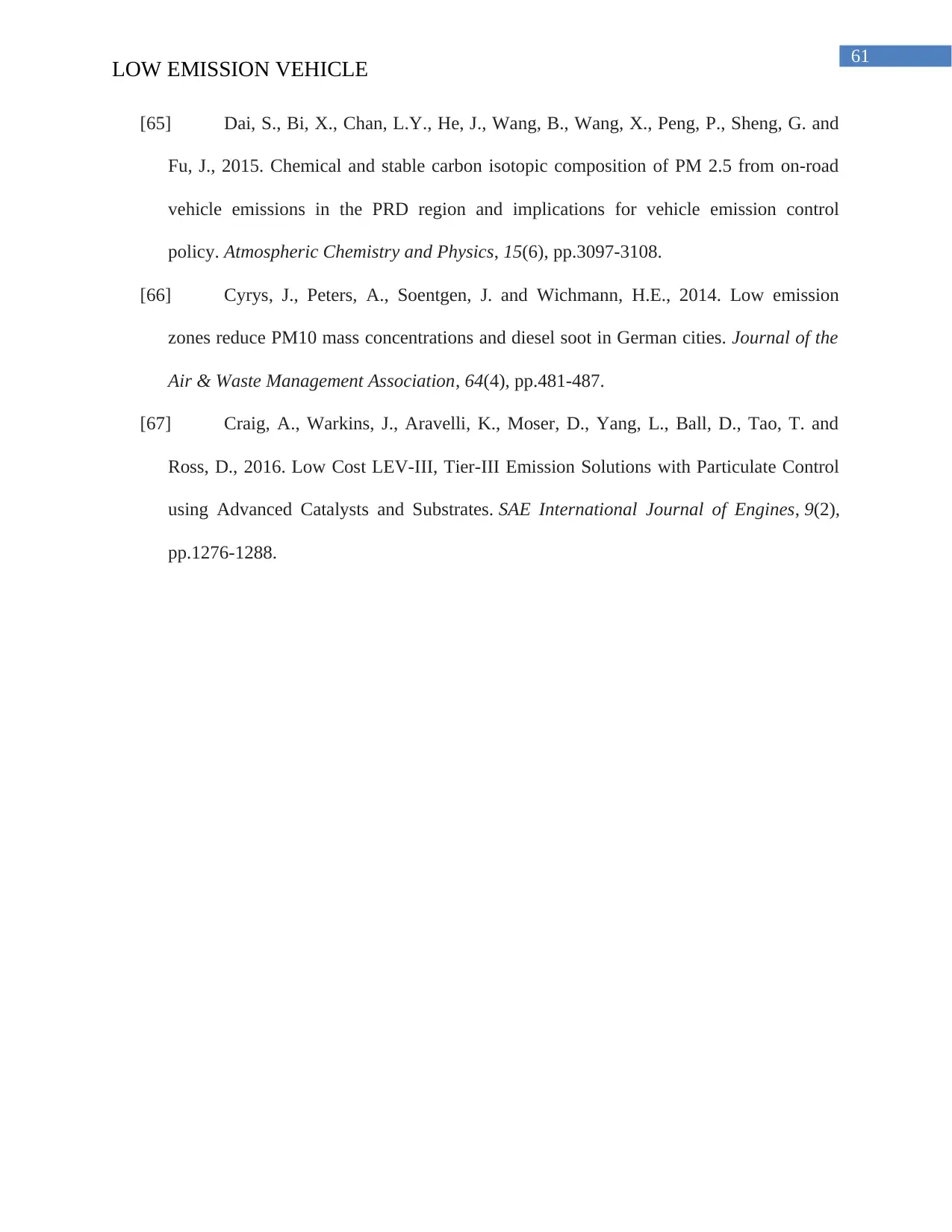
61
LOW EMISSION VEHICLE
[65] Dai, S., Bi, X., Chan, L.Y., He, J., Wang, B., Wang, X., Peng, P., Sheng, G. and
Fu, J., 2015. Chemical and stable carbon isotopic composition of PM 2.5 from on-road
vehicle emissions in the PRD region and implications for vehicle emission control
policy. Atmospheric Chemistry and Physics, 15(6), pp.3097-3108.
[66] Cyrys, J., Peters, A., Soentgen, J. and Wichmann, H.E., 2014. Low emission
zones reduce PM10 mass concentrations and diesel soot in German cities. Journal of the
Air & Waste Management Association, 64(4), pp.481-487.
[67] Craig, A., Warkins, J., Aravelli, K., Moser, D., Yang, L., Ball, D., Tao, T. and
Ross, D., 2016. Low Cost LEV-III, Tier-III Emission Solutions with Particulate Control
using Advanced Catalysts and Substrates. SAE International Journal of Engines, 9(2),
pp.1276-1288.
LOW EMISSION VEHICLE
[65] Dai, S., Bi, X., Chan, L.Y., He, J., Wang, B., Wang, X., Peng, P., Sheng, G. and
Fu, J., 2015. Chemical and stable carbon isotopic composition of PM 2.5 from on-road
vehicle emissions in the PRD region and implications for vehicle emission control
policy. Atmospheric Chemistry and Physics, 15(6), pp.3097-3108.
[66] Cyrys, J., Peters, A., Soentgen, J. and Wichmann, H.E., 2014. Low emission
zones reduce PM10 mass concentrations and diesel soot in German cities. Journal of the
Air & Waste Management Association, 64(4), pp.481-487.
[67] Craig, A., Warkins, J., Aravelli, K., Moser, D., Yang, L., Ball, D., Tao, T. and
Ross, D., 2016. Low Cost LEV-III, Tier-III Emission Solutions with Particulate Control
using Advanced Catalysts and Substrates. SAE International Journal of Engines, 9(2),
pp.1276-1288.
Paraphrase This Document
Need a fresh take? Get an instant paraphrase of this document with our AI Paraphraser
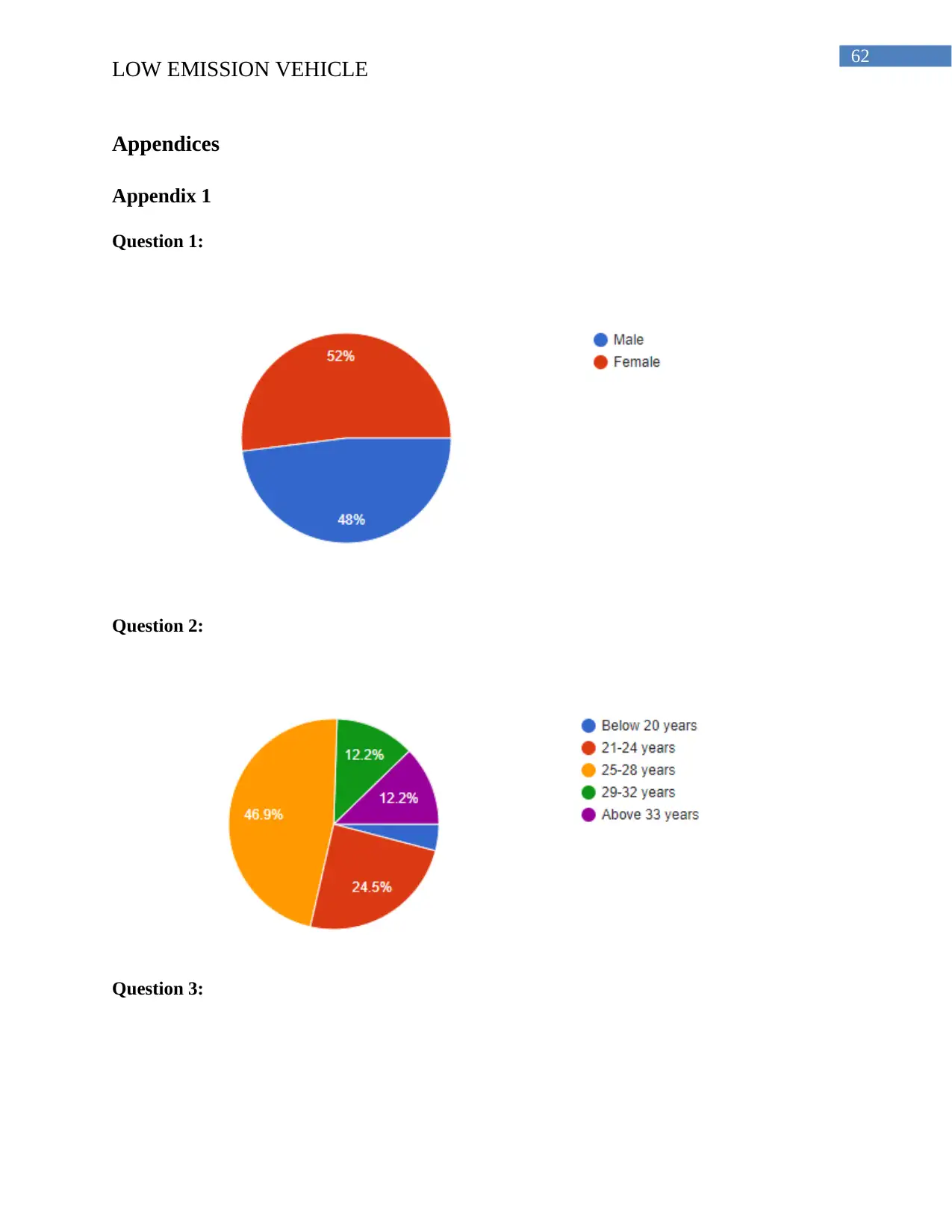
62
LOW EMISSION VEHICLE
Appendices
Appendix 1
Question 1:
Question 2:
Question 3:
LOW EMISSION VEHICLE
Appendices
Appendix 1
Question 1:
Question 2:
Question 3:

63
LOW EMISSION VEHICLE
Question 4:
Question 5:
LOW EMISSION VEHICLE
Question 4:
Question 5:
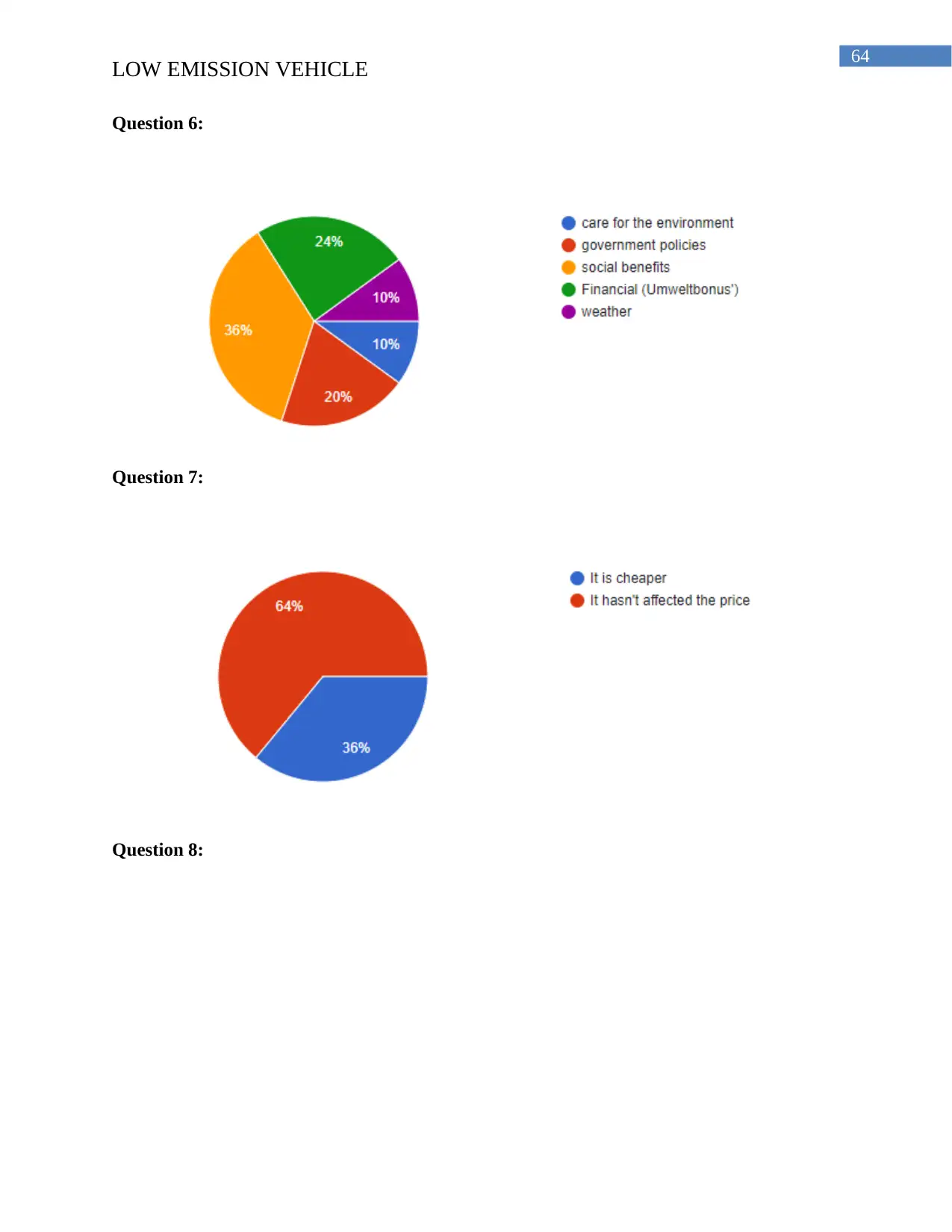
64
LOW EMISSION VEHICLE
Question 6:
Question 7:
Question 8:
LOW EMISSION VEHICLE
Question 6:
Question 7:
Question 8:
Secure Best Marks with AI Grader
Need help grading? Try our AI Grader for instant feedback on your assignments.
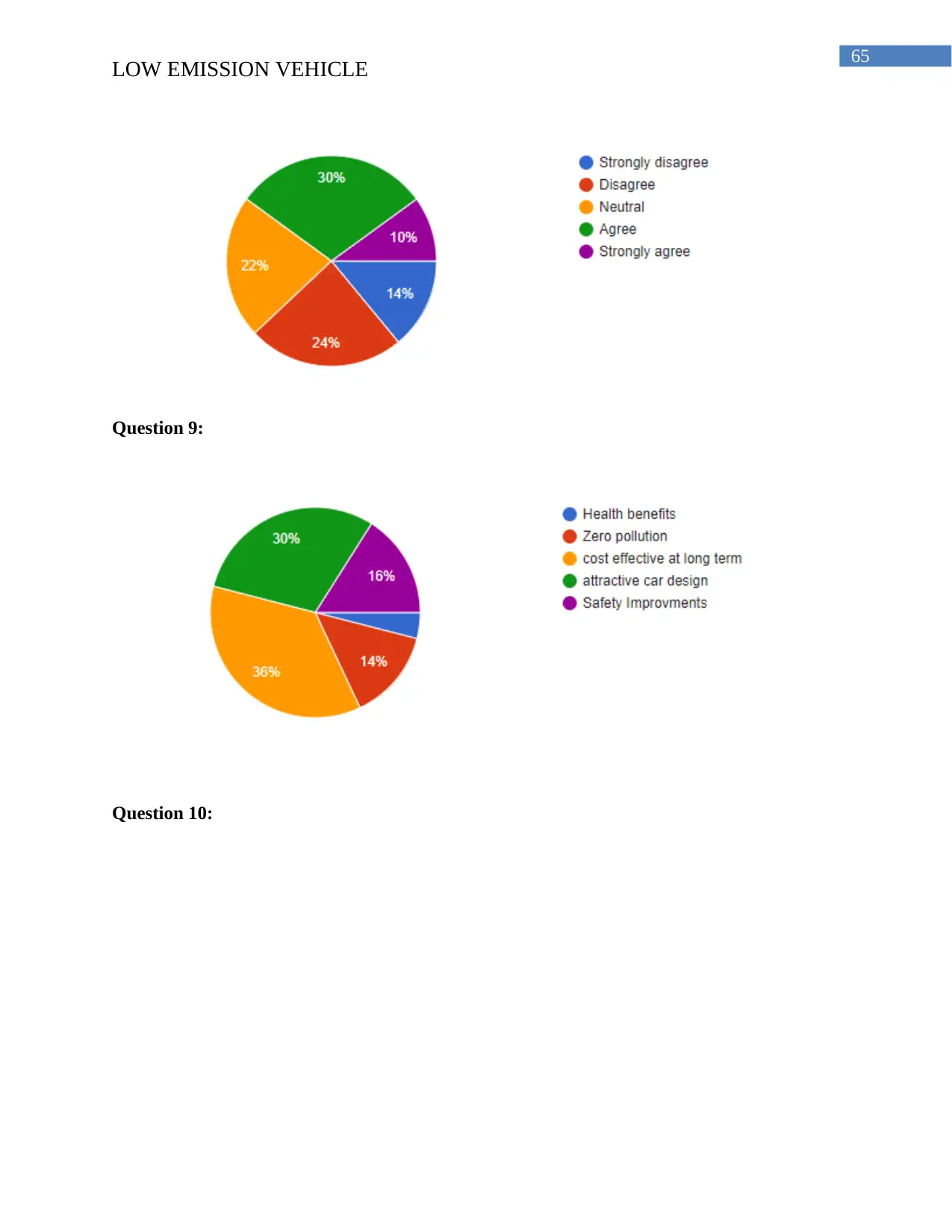
65
LOW EMISSION VEHICLE
Question 9:
Question 10:
LOW EMISSION VEHICLE
Question 9:
Question 10:

66
LOW EMISSION VEHICLE
LOW EMISSION VEHICLE

67
LOW EMISSION VEHICLE
LOW EMISSION VEHICLE
1 out of 67
Related Documents
Your All-in-One AI-Powered Toolkit for Academic Success.
+13062052269
info@desklib.com
Available 24*7 on WhatsApp / Email
![[object Object]](/_next/static/media/star-bottom.7253800d.svg)
Unlock your academic potential
© 2024 | Zucol Services PVT LTD | All rights reserved.





